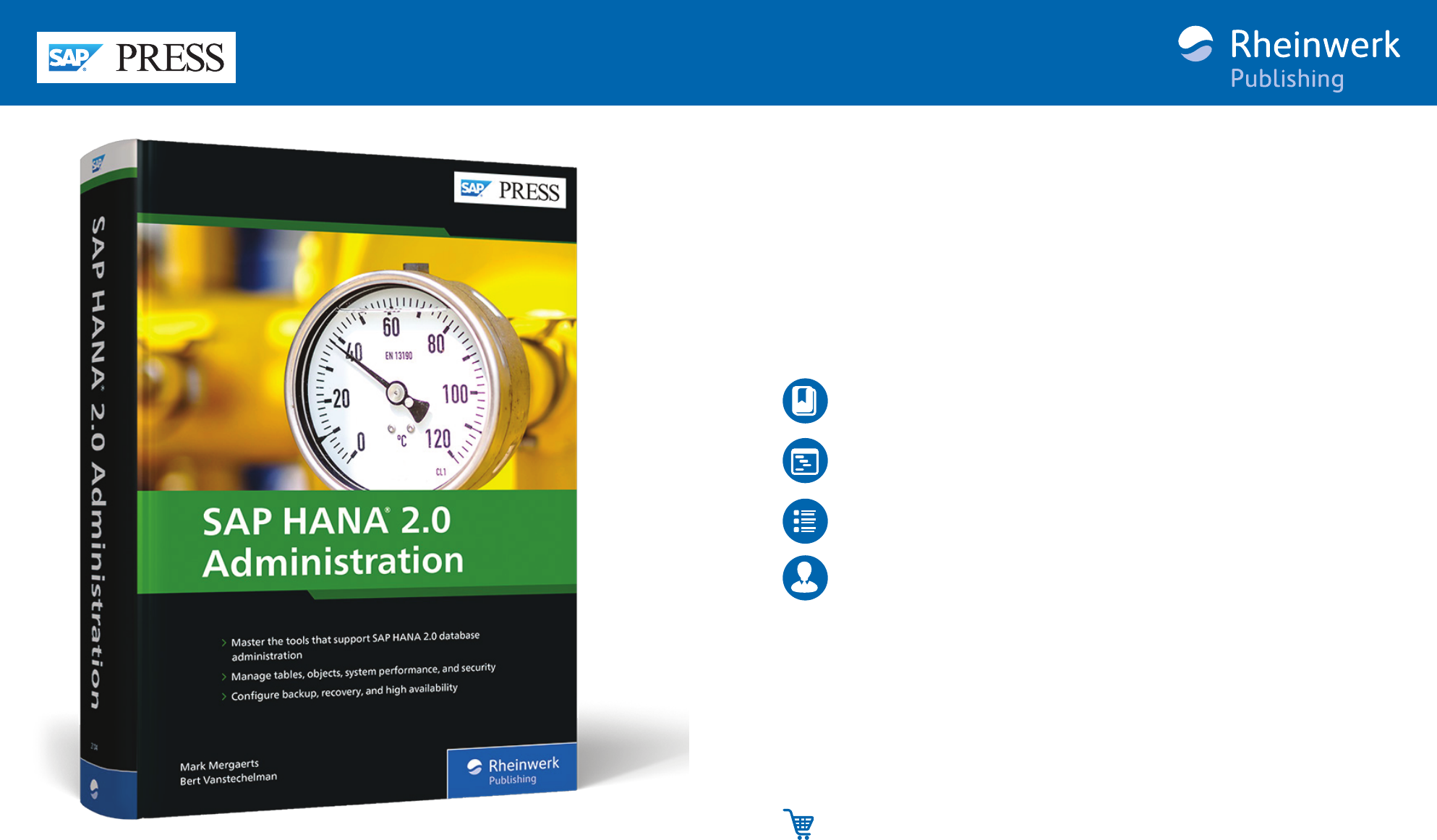
Browse the Book
In this chapter you’ll learn how an SAP HANA instance is structured, how
it manages resources and activities, and how to use different tools to
administer the instance and the databases it contains.
Mark Mergaerts, Bert Vanstechelman
SAP HANA 2.0 Administration
1056 Pages, 2022, $89.95
ISBN 978-1-4932-2104-2
www.sap-press.com/5287
First-hand knowledge.
“Instance Administration”
Contents
Index
The Authors

131
4
Chapter 4
Instance Administration
Now that you’ve been introduced to the various SAP HANA administra-
tion tools, in this chapter you’ll learn how an SAP HANA instance is struc-
tured, how it manages resources and activities, and how to use different
tools to administer the instance and the databases it contains.
SAP HANA is a database management system (DBMS)—perhaps one with very peculiar
characteristics, but a DBMS nonetheless. When describing any DBMS, it’s customary to
make a distinction between the database, which is the physical repository of the data,
and the technical infrastructure that is necessary to operate the database. This techni-
cal infrastructure is to a large extent defined and managed by software objects like exe-
cutable code, processes, and memory structures. We use the term SAP HANA instance,
or simply instance, to refer to this infrastructure as installed on one host. In a single-
node installation, there is only one instance; in a multinode installation, there are sev-
eral. The SAP HANA instance or instances and the database together form the SAP
HANA system (or just system).
One thing that comes up in the sales pitch of every DBMS vendor is that the system
needs very little work—that it is, so to speak, self-managing. As anyone with a back-
ground in database administration or consulting in that domain can attest, self-
managing database systems live in the same imaginary universe as the one in which all
lunches are free. Like any complex and often business-critical application, a certain
amount of management work will always be required; SAP HANA is no exception to
that rule. In this chapter, we’ll try to provide you with the necessary knowledge of how
an SAP HANA instance is organized and how you can carry out key management tasks.
This chapter focuses on instance administration, and Chapter 5 focuses on database
administration, but there are areas where the dividing line between the two isn’t sharp,
so there’s inevitably some overlap. This chapter ventures into the database realm, for
example, when describing workload classes or database logging.
The first section in this chapter describes how an SAP instance is structured: you’ll
learn how an instance is uniquely identified, which server-level entities (like operating
system users, groups, and directory trees) it uses, which processes it launches, and
which network ports these processes make use of. One of the basic things an SAP HANA
administrator has to know is how to start and stop an instance, which is the subject of
the second section. Then we’ll talk about the parameters that define how the instance
is configured. The fourth section focuses on that most critical of SAP HANA resources:

4 Instance Administration
132
memory. We’ll see how SAP HANA organizes its memory and how it behaves when
there isn’t enough of it. We then move on to sessions and transactions, which represent
the work applications actually perform in the database. The subject of Section 4.6 is
load management and distribution: here we’ll see how to control and optimize the allo-
cation of precious server resources to different workloads. Section 4.7 looks at some
special SAP HANA utilities that run on the database server. The last section of the chap-
ter deals with redo logs, which hold a persistent record of all transactions. As we said
earlier, this subject might just as well be part of the chapter on database management,
but because we concentrate mainly on the management aspect, we cover it here.
Metadata and Monitoring Views
In this and future chapters, you’ll encounter several references to monitoring views. We
discuss these in detail in Chapter 15, but it’s useful to briefly introduce them here. SAP
HANA provides an extensive collection of database views that contain information
about its inner workings. These views are organized into three categories:
쐍 Catalog views contain the metadata—that is, information about data objects such
as schemas, tables, views, services, and so on. These are covered in Chapter 11.
쐍 Monitoring views provide current runtime data about the active instance, including
statistics and status information. Monitoring views aren’t physical objects in the
database. The data they contain isn’t stored anywhere; it’s calculated on the spot
when you query the view. All monitoring views have names beginning with
"M_".
We discuss monitoring views in Chapter 15.
쐍 Statistics service views (often shorted to statistics views) contain historical informa-
tion about the status, resource usage, and performance of the system. They can be
used to study the behavior of the SAP HANA system over time. Like the monitoring
views, we cover statistics views in Chapter 15.
4.1 Structure of an SAP HANA Instance
When designing SAP HANA, SAP chose not to invent an entirely new organizational
model but instead to make use of an existing model that has proven its quality and
manageability since the introduction of the first SAP R/3 release in the early 1990s;
this is the model used for SAP application servers. If you have an SAP administration
background, then the way an SAP HANA instance is organized will look very familiar.
Even if you have no such background, you’ll find this structure easy to understand
and navigate. In this section, we look at the system ID (SID), the operating system
users and groups, the directory organization, and the process hierarchy, each time
pointing out the close resemblance between the two types of instances. In Sections
4.1.6 to 4.1.8, we look at some directories and files that are specific to SAP HANA: the
database directories where you find the data and log volumes; the INI files, which
133
4.1 Structure of an SAP HANA Instance
4
contain the configuration parameters; and the trace files, in which runtime informa-
tion about the instance is collected. To navigate the different file system areas with
more ease, the SAP HANA installation creates a set of aliases (command shortcuts),
which we list in the last section.
4.1.1 SAP HANA System ID and Instance Number
Every SAP system, ABAP or Java, has a name: the system ID (SID). Likewise, an SAP
HANA system also has a system ID, which in this chapter we will always denote with
HSID. Where it appears as part of a longer string, such as in directory paths, we use
<HSID> as a placeholder. Like the SID, the HSID consists of three characters. The first is
an uppercase letter and the second and third either an uppercase letter or a number.
Apart from some reserved names, the HSID can be chosen freely at installation time. A
frequently used (but not mandatory) convention for SAP HANA is to let the system ID
begin with H.
Again, like every SAP application instance, an SAP HANA instance is uniquely identified
by a two-digit number in a range from 00 to 97 (98 and 99 are reserved). In this chapter,
we’ll use <xx> as a placeholder for the instance number.
When using the command line, the administrator will often have to use the HSID and
instance number as command parameters. To make life easier and to provide better
portability of, say, management scripts, two environment variables are set in the OS
environment of the SAP HANA administrator user. These are shown in Table 4.1.
4.1.2 Users and Groups
The ID of the operating system user for the SAP HANA administrator is <hsid>adm,
which is again the exact equivalent of the
<sid>adm user of SAP application instances.
All management activities regarding the SAP HANA instance are performed while
logged in as this user.
The primary group of the
<hsid>adm user also has the same name as in an application
instance: sapsys. With SAP HANA, the user is also a member of the secondary group
<hsid>shm.
With multitenant database installations, it’s possible that, for security reasons, the
management of different tenant databases must be strictly segregated. If this is the
Environment Variable Description
SAPSYSTEMNAME SAP HANA system ID
TINSTANCE Instance number
Table 4.1 Environment Variables for HSID and Instance Number
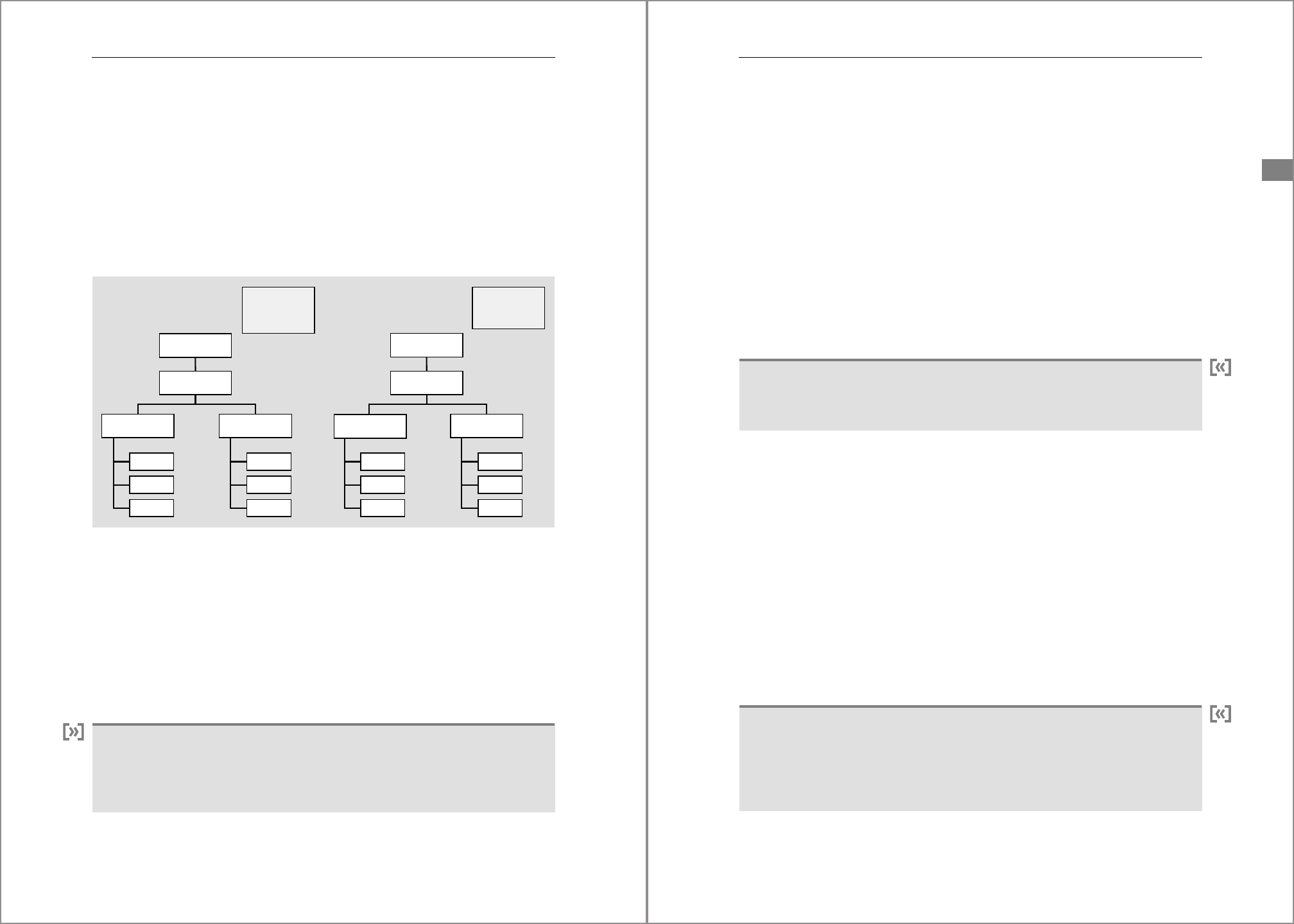
4 Instance Administration
134
case, then the SAP HANA system can be configured for high isolation (the alternative,
and default, is low isolation). In a high isolation setup, separate OS users and groups are
created for each tenant database. The database-specific services then run with the iden-
tity of these dedicated users, who also have the ownership of the database files.
4.1.3 Directory Structure
Figure 4.1 shows the file system setup of an ABAP or Java dialog instance on the left and
that of an SAP HANA instance on the right. It will be obvious that the two are virtually
identical.
Figure 4.1 File System Structure of ABAP/Java and SAP HANA Instances
The top-level directory of an SAP dialog instance refers to the SAP HANA system ID, the
HSID. Under this top node, the SAP dialog instance has a SYS subdirectory, which con-
tains files shared by the entire system, and an instance-specific directory called Dxx
(for ABAP) or Jxx (for Java), where the D and J denote the instance type (other types exist
as well) and xx is the two-digit instance number. By the same token, the SAP HANA
instance has a SYS subdirectory and an instance subdirectory HDB<xx>, where HDB is
the instance type and xx is the instance number in the same range as that for dialog
instances.
Central Services Instance
Apart from dialog instances, ABAP and Java systems also have a central services in-
stance, which groups the processes that represent single points of failure. No equiva-
lent exists for SAP HANA because high availability is not managed at this level.
/oracle
/db2
/sybase
/hana
Dxx/Jxx SYS
HDBxx
SYS
/usr/sap
exe
work
. . .
exe
global
prole
exe
work
. . .
exe
global
prole
<SID>
<HSID>
/usr/sap
135
4.1 Structure of an SAP HANA Instance
4
In ABAP and Java systems, the database resides in a separate directory tree, whose top
node typically has the name of the database system—for instance, /oracle, /db2, or
/sybase. The same is true for SAP HANA: the database files (including the data and log
volumes) have their own directory tree under /hana. In the case of SAP HANA, how-
ever, the SAP area (under /usr/sap/<HSID>) and the database area (under /hana) are
connected by symbolic links. In fact, if you drilled down into the /usr/sap/<HSID>
structure, you would discover that physically very little exists there and that most
subdirectories are in fact symbolic links to a subdirectory under /hana/shared. There
is little point going into the deep details of this, however: the structure is intended to
create a recognizable and easily navigable environment. These two takeaways are suf-
ficient:
쐍 The SAP HANA instance directory tree is structured so as to be nearly identical to
that of a classical SAP application instance.
쐍 The actual instance files are located mostly in and below the /hana/shared directory.
No /sapmnt File System
In contrast to SAP application instances on UNIX and Linux, there is no /sapmnt file sys-
tem.
4.1.4 Process Tree
Another important similarity between SAP dialog and SAP HANA instances is that they
run under the control of the SAP start service framework. At the top of the process tree
is the SAP service process
sapstartsrv. This process is responsible for starting and stop-
ping the processes in the instance and acts as their parent process. Figure 4.2 compares
the process tree of an SAP HANA instance to that of an ABAP dialog instance. On the
ABAP side,
sapstartsrv launches the sapstart program, which starts the dispatcher
process. The dispatcher then spawns a series of clones of itself, which become the
instance work processes, and also starts some other specialized processes, like the
RFC gateway and the Internet Communication Manager. On the SAP HANA side, we
also find
sapstartsrv and sapstart, which start the HDB daemon process; the daemon
in turn launches the different SAP HANA service processes, which were described in
Chapter 2.
sapstart
A note for the purists: strictly speaking, sapstart is not a child process of sapstartsrv.
The
sapstart process is detached from the process tree and attaches directly to the OS
system daemon (PID 1). However, this technical behavior does not affect the validity of
the example.
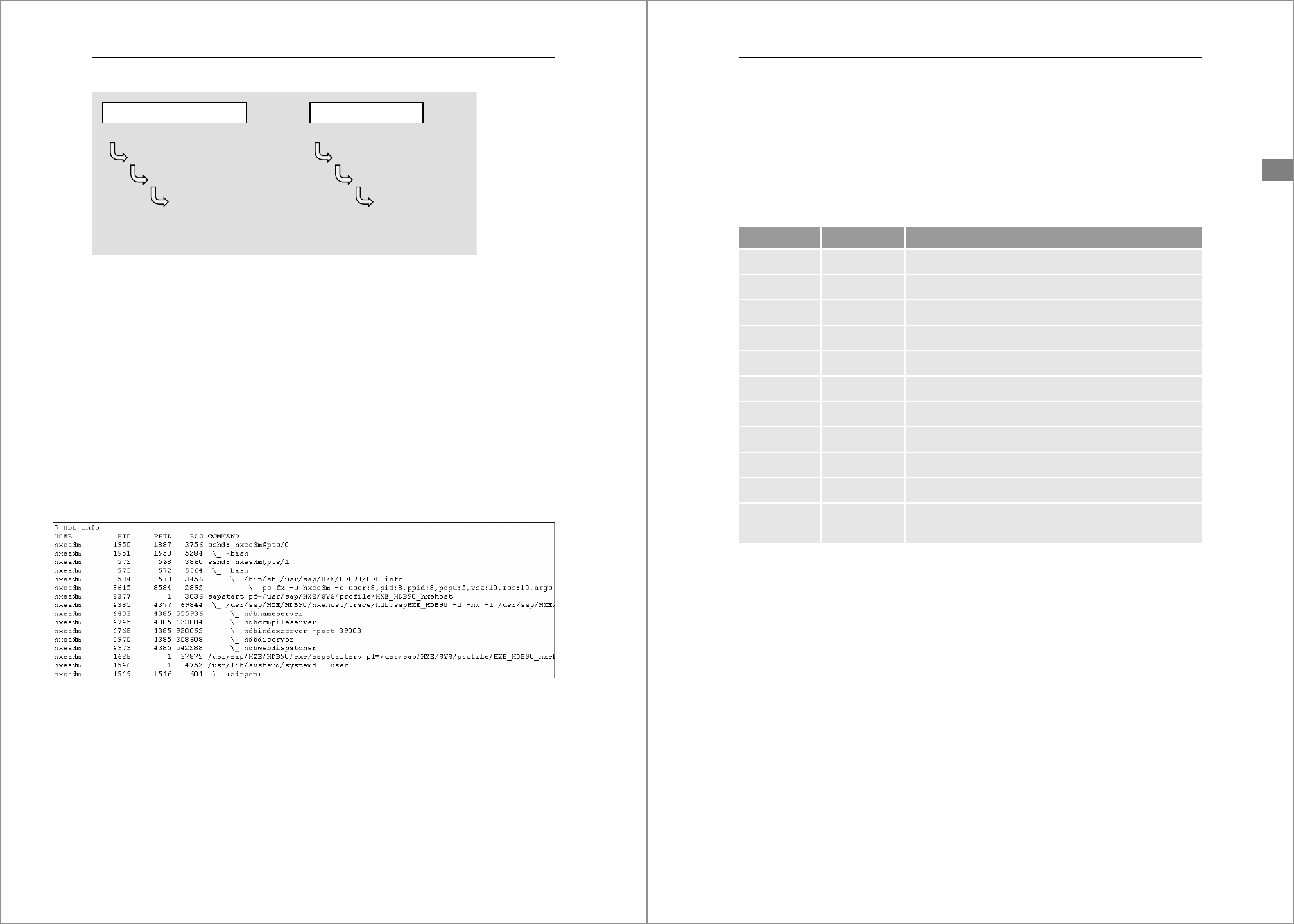
4 Instance Administration
136
Figure 4.2 Process Tree of ABAP and SAP HANA Instances
If the instance is up and running, then the server command HDB info clearly displays
this hierarchy. Figure 4.3 shows the process tree for an active SAP HANA, express edi-
tion instance (HANA SID HXE). The master process is
sapstartsrv (PID 1628, near the
end of the list). The
sapstart process (PID 4377) is the parent of process hdb.sapHXE_
HDB90
. This is nothing more than an alias (symbolic link) for the hdbdaemon process:
ls -l /usr/sap/HXE/HDB90/hxehost/trace/hdb.sapHXE_HDB90
/usr/sap/HXE/HDB90/hxehost/trace/hdb.sapHXE_HDB90 -> /usr/sap/HXE/HDB90/exe/
hdbdaemon
This is again something also found with ABAP instances, where the dispatcher and
work processes (whose real program name is
disp+work) appear under the name of a
symbolic link
dw.sapSID_Dxx.
Figure 4.3 SAP HANA Instance Processes
4.1.5 Services and Ports
The services that make up an SAP HANA instance either work on behalf of the entire
system or belong to a specific tenant only. In the system metadata, a service is almost
always identified by the host where it’s running and the network port it’s using for all
communication. This combination of hostname and port number can therefore be
sapstartsrv
sapstart
Dispatcher
work process
work process
. . .
other instance processes
sapstartsrv
sapstart
hdbdaemon
hdbnameserver
hdbindexserver
hdbwebdispatcher
. . .
SAP ABAP Dialog Instance SAP HANA Instance
137
4.1 Structure of an SAP HANA Instance
4
seen as a unique identification for a given service, and later in this chapter and in other
parts of the book we’ll encounter many situations in which you must use or interpret
this identification to obtain data about the system.
The SAP HANA installation defines the services in a range starting at 3xx00, where xx
denotes the instance number; for example, port numbers for an instance 01 would
start at 30100. Table 4.2 shows standard port number assignments as set by the SAP
HANA installation process or SAP HANA lifecycle manager (
hdblcm executable).
When a tenant database is created via SQL with the
CREATE DATABASE statement, it’s pos-
sible to assign the port numbers explicitly. In that case, tenant port numbers may differ
from this standard.
You can find the services and their associated port numbers by querying the
M_SERVICES
monitoring view.
4.1.6 SAP HANA Database Directories
The top node for the database directory tree is /hana. This area contains the physical
directories and files of the SAP HANA application (which the symbolic links in /usr/sap/
<HSID> point to), as well as the data and log volumes of the system and tenant data-
bases.
Port Database Service Name
3xx00 - daemon
3xx01 System DB nameserver
3xx02 System DB preprocessor
3xx03 Initial tenant indexserver
3xx04 Initial tenant scriptserver
3xx05 Initial tenant diserver
3xx06 Initial tenant webdispatcher
3xx07, 3xx08 Initial tenant xsengine
3xx10 Initial tenant compileserver
3xx11 Initial tenant dpserver
3xx40–3xx99 Other tenants Services assigned by installation or hdblcm when creating
additional tenants
Table 4.2 Port Numbers in SAP HANA System
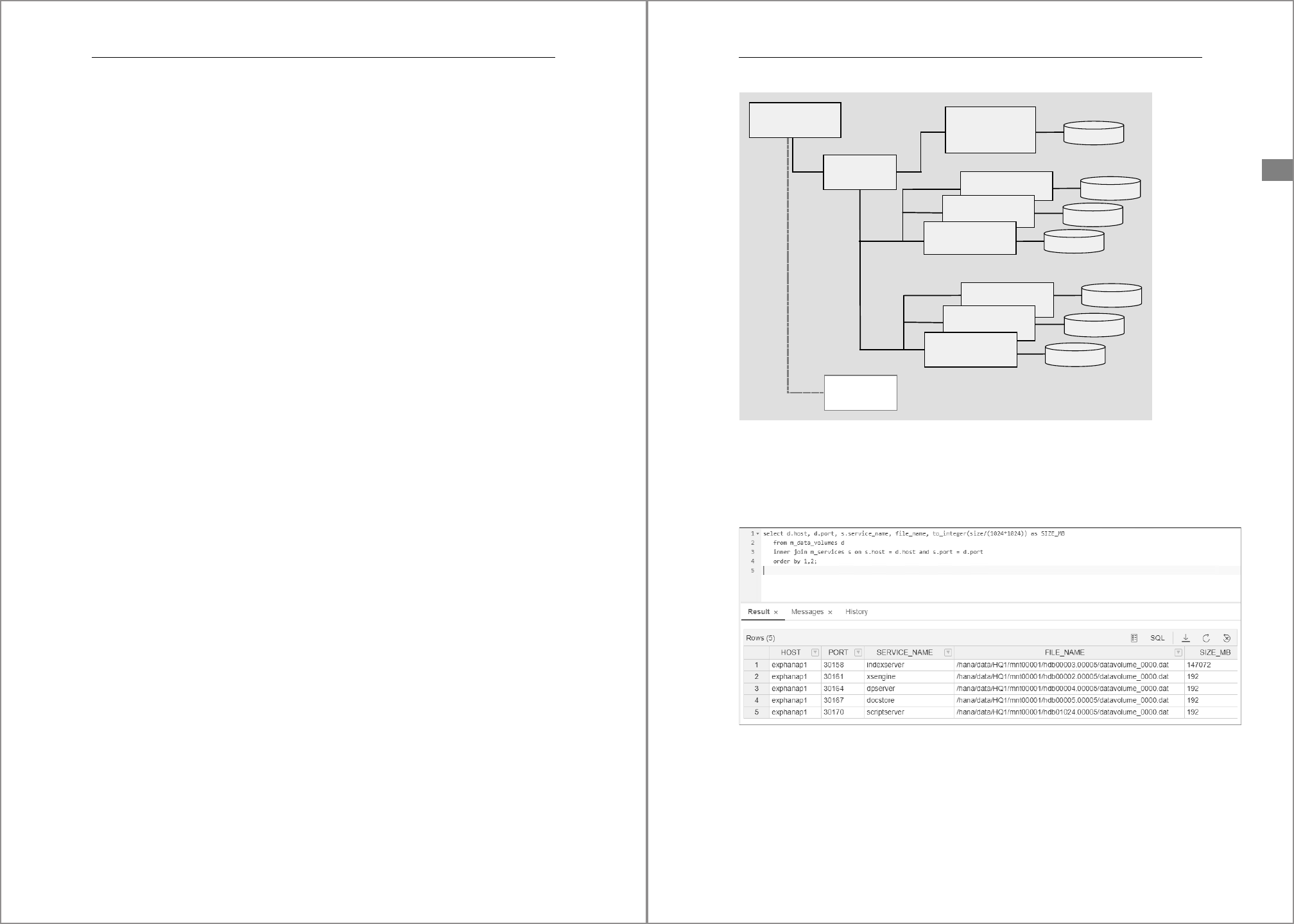
4 Instance Administration
138
The data and log volumes reside under a directory node known as the basepath. Its
physical path may differ between installations, but it can be determined from two con-
figuration parameters in the global.ini profile in the
[persistence] section:
쐍 basepath_datavolume
쐍 basepath_logvolumes
If SAP HANA is up and running, then you can find the values of these parameters by
querying the
M_CONFIGURATION_PARAMETER_VALUES monitoring view, as shown in Listing 4.1.
select host, port, key, value from M_CONFIGURATION_PARAMETER_VALUES
where file_name = 'global.ini' and key in
('basepath_datavolumes','basepath_logvolumes');
HOST,PORT,KEY,VALUE
"prdhana1",33003,"basepath_datavolumes","/hana/data/HP1"
"prdhana1",33007,"basepath_datavolumes","/hana/data/HP1"
"prdhana1",33003,"basepath_logvolumes","/hana/log/HP1"
"prdhana1",33007,"basepath_logvolumes","/hana/log/HP1"
Listing 4.1 Retrieving Data and Log Volume Basepaths
As you can see, the parameters are set twice: for service 33003 and 33007 (which, based
on Table 4.2, correspond to the standard ports for the index server and SAP HANA XS
engine). Each SAP HANA service that needs persistent storage has its own data and log
volumes and therefore its own storage path (although in practice they will rarely, if
ever, be different between services).
Data Volumes
Under the basepath, the data volumes are organized as shown in Figure 4.4.
The directories mnt00001, mnt00002, and so on correspond to different hosts:
mnt00001 always exists; scale-out systems will also have mnt00002 and higher
depending on the number of nodes. The hdb00001 subdirectory contains the data vol-
ume of the name server of the system database. The tenants have their own subdirec-
tories, like hdb0000n.ddd containing the data volumes for the index server and the
other services that use persistent storage. The ddd suffix is a sequence number indicat-
ing the tenant.
By default, a data volume consists of a single data file with the name datavolume_
0000.dat. The process of writing data from memory to persistent storage continuously
adds, changes, and deletes pages to this file. When additional space is required, the file
will automatically expand; however, it does not shrink when space requirements
decrease. Shrinking a data volume is possible, but it’s a manual operation.
The data volume of the index server can be partitioned in such a way that its data is dis-
tributed over different disk stripes, which can improve performance.
139
4.1 Structure of an SAP HANA Instance
4
Figure 4.4 Directory Structure for Data Volumes
The data files of the database are listed in the M_DATA_VOLUMES monitoring view. Join this
view with
M_SERVICES to see the association between the volume and the service, as
shown in Figure 4.5.
Figure 4.5 Listing Data Volumes of Database
Log Volumes
Figure 4.6 shows the directory structure for the log volumes. For readability, Figure 4.6
only shows the directory structure for a single-tenant database.
mnt00002
datale
datale
datale
datale
datale
datale
datale
hdb00004.003
hdb00003.003
hdb00002.003
hdb00004.004
hdb00003.004
hdb00002.004
mnt00001
hdb00001
(nameserver
SYSTEMDB)
data basepath

4 Instance Administration
140
Figure 4.6 Directory Structure for Log Volumes
The directories are organized in precisely the same way as for the data volumes. The
only difference is in the contents of the subdirectories. Instead of a single data file,
there is a constantly evolving collection of redo log files. These files are called log seg-
ments and are numbered sequentially starting with 0. To prevent the disks containing
the logs from overflowing, it’s necessary to schedule regular log backups. Redo log
management and backups are subjects we’ll cover later in this chapter.
In addition to the redo logs, each log volume also contains a log directory file with the
name logsegment_000_directory.dat.
Now that you know where to find the data and log volumes of the SAP HANA database,
it’s time for a warning—a dire warning.
Here Be Dragons!
Never—we repeat, n-e-v-e-r—manipulate the SAP HANA data and log volumes with
operating system commands! Operations on the files should be handled only by the
DBMS processes or through SQL commands. Do not rename, move, or—worst of all—
delete files manually. You’ll end up with an unusable database that can no longer be
started. When the SAP HANA installation creates the data and log directories, it places
an empty file called __DO_NOT_TOUCH_FILES_IN_THIS_DIRECTORY__ there. That file
is there for a reason.
mnt00002
log basepath
mnt00001
hdb00002.003
logsegment_000_00000000.dat
logsegment_000_00000001.dat
. . .
logsegment_000_00000000.dat
logsegment_000_00000001.dat
. . .
logsegment_000_00000000.dat
logsegment_000_00000001.dat
. . .
hdb00004.003
hdb00003.003
hdb00001
(nameserver
SYSTEMDB)
141
4.1 Structure of an SAP HANA Instance
4
Threatening as it sounds, there is one exception to this rule: in a situation where the
disk containing the redo log is full, you will probably have to move log segments by
hand—but you’ll have to move them back to where they came from later.
4.1.7 INI Files: Database Parameters
All SAP HANA parameters are stored in a collection of server files, commonly known as
INI files (from the file extension .ini). If you’re old enough to remember preregistry ver-
sions of Microsoft Windows, then both the term INI file and the structure of these files
will bring back memories because this was the typical format Windows-based applica-
tions used for their parameter settings. In fact, the SAP HANA parameter files are for-
matted in precisely the same way as their Windows ancestors: every INI file is
subdivided into sections titled with names in square brackets; the parameters them-
selves are entered as key/value pairs, as shown schematically in Listing 4.2.
[sectionA]
parameter1 = value1
parameter2 = value2
[sectionB]
parameter3 = value3
Listing 4.2 General Format of INI File
In the SAP HANA documentation, a parameter therefore always has a three-part identi-
fication: the INI file, the section, and the parameter file. We already saw an example of
this when we mentioned the parameters for the data and log basepaths in Section 4.1.6.
Parameters are defined at four different levels or, to use their precise name, layers.
These layers are listed in Table 4.3.
We return to this when we talk about parameter maintenance, but we’re mentioning it
here because the layer affects the location of the INI files.
Although parameters exist at four layers, they can only be set at three. The settings at
the
DEFAULT layer are read-only and can’t be changed.
Layer Scope
DEFAULT SAP HANA default settings
SYSTEM Entire SAP HANA system
HOST Single host
DATABASE Individual database (multitenant only)
Table 4.3 Parameter Layers
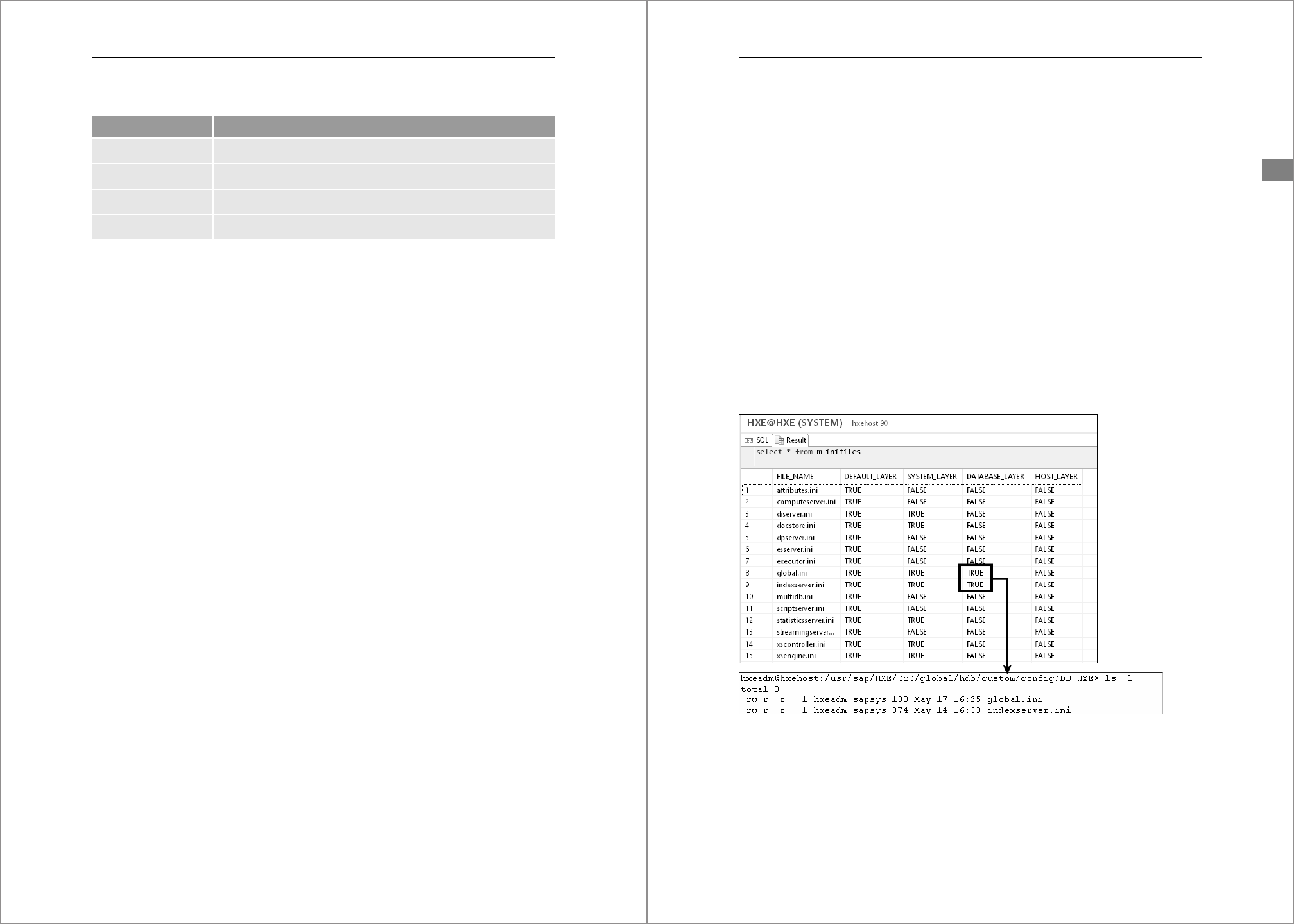
4 Instance Administration
142
Every layer has its own directory; we list these in Table 4.4.
Not every INI file is defined for every layer (except the default layer, which has a version
of all INI files). For example, the daemon.ini file, which contains the parameters for the
HDB daemon process, only exists at the system and host layer, not at the database
layer. Conversely, the majority of INI files exist at the system and database layers but
not at the host layer. The directory of the default layer contains a file called inifiles.ini,
which lists all existing INI files, indicates for each layer whether they are defined there,
and also shows the affected services and a brief description. Listing 4.3 shows a small
extract from this file.
[file:global.ini]
layered=yes
default=yes
system=yes
host=yes
database=yes
services=*
description=global settings for all services
[file:indexserver.ini]
layered=yes
default=yes
system=yes
host=no
database=yes
services=indexserver,docstore,xsengine,dpserver,etsserver
description=hdbindexserver
[file:inifiles.ini]
hidden=yes
layered=yes
default=yes
system=no
database=no
Layer Directory
DEFAULT (read-only) /usr/sap/<HSID>/HDB<xx>/exe/config
SYSTEM /usr/sap/<HSID>/SYS/global/hdb/custom/config
HOST /usr/sap/<HSID>/HDB<xx>/<hostname>
DATABASE /usr/sap/<HSID>/SYS/global/hdb/custom/config/DB_<tenant>
Table 4.4 Directories for INI Files
143
4.1 Structure of an SAP HANA Instance
4
host=no
description=inifile meta information
[file:nameserver.ini]
layered=yes
default=yes
system=yes
host=no
database=no
services=nameserver,webdispatcher
description=nameserver
Listing 4.3 Extract from inifiles.ini
To see which INI files are in use and at which layers, query the M_INIFILES monitoring
view. Figure 4.7 shows the contents of the view in an SAP HANA Express system. At the
time of the query, only the global.ini and indexserver.ini files exist at the database layer
for the HXE tenant. Listing the contents of the corresponding server directory shows
that indeed only those two INI files exist there.
Figure 4.7 M_INIFILES Monitoring View
4.1.8 Trace Files
Trace files are text files with diagnostic messages, which are continuously being written
to by the SAP HANA processes. These files are an important source of information

4 Instance Administration
144
about the functioning of the system, and they are the first place to turn to if you notice
or suspect a malfunction. Not all information in the trace files is intended for common
mortals, but it may still be very useful to SAP support specialists if you have to call
upon them to solve a problem.
We’ll defer a full discussion of trace files until Chapter 15, which is about monitoring
SAP HANA, but because they play an important role in the management of the
instance, it’s necessary to at least mention their existence here.
4.1.9 Command Aliases for Directory Navigation
Even after you’ve become familiar with the directory organization, constantly having
to remember what’s where and typing the full directory paths gets a little tedious. To
make this easier, the SAP HANA installation creates a set of aliases for the
cd (change
directory) command in the shell environment of the
<hsid>adm user. These aliases can
be used to quickly switch to a directory of interest. There are about 20 of these aliases;
you won’t use all of them frequently. Those listed in Table 4.5 are the ones that you
might find the most useful, in the authors’ experience.
To list all available aliases for directory switching, use the
alias | fgrep cd command.
Alias Target Description
cdco /usr/sap/<HSID>/HDB<xx>/exe/config Default parameter files (INI files)
cdcoc /usr/sap/<HSID>/HDB<xx>/global/
hdb/custom/config
System, host, and database INI files
cdexe /usr/sap/<HSID>/SYS/exe/hdb SAP executables and libraries directory
cdglo /usr/sap/<HSID>/SYS/exe/global Global directory
cdhdb /usr/sap/<HSID>/HDB<xx> Instance directory
cdhdblcm /hana/shared/<HSID>/hdblcm SAP HANA lifecycle manager directory
cdpro /usr/sap/<HSID>/SYS/profile Instance profile directory
cdpy /usr/sap/<HSID>/HDB<xx>/exe/
python_support
Directory containing Python support
scripts
cdtrace /usr/sap/<HSID>/HDB<xx>/
<hostname>/trace
Instance and tenant database trace
files
Table 4.5 Useful Aliases for cd Command
145
4.2 Starting and Stopping the Instance
4
4.2 Starting and Stopping the Instance
You can start and stop the SAP HANA instance via the command line and with SAP
HANA Studio; we describe both methods in the first two sections. The SAP documenta-
tion vaguely mentions that it’s also possible to do with the SAP HANA cockpit, but this
doesn’t appear to be true at this time. By default, starting the SAP HANA instance also
starts the tenant databases, but it’s of course also possible to start and stop them indi-
vidually. You can also disable the automatic startup for one or more tenants. We cover
these subjects in Section 4.2.4. In Section 4.2.5, we show how you can check the current
status of the instance and the tenant databases, and in Section 4.2.6 we take a closer
look at the SAP start service process.
4.2.1 With the Command Line
We already saw the commands to start and stop the SAP HANA instance in Chapter 3.
These operations are implemented as options of the
HDB command, as shown in List-
ing 4.4.
HDB start
HDB stop
HDB restart(stop + start)
Listing 4.4 Start/Stop Options for HDB Command
These commands run in the foreground; that is, the server session remains blocked
until the process finishes. If you want to do other things, such as monitoring the trace
files, during startup or shutdown, then you must open an extra session on the database
server.
There’s nothing particularly interesting about the output of the commands, so we
won’t show it here—except for this little intriguing line in the
HDB stop output:
hdbdaemon will wait maximal 300 seconds for NewDB services finishing.
Notice the name NewDB. We think the developers left this in on purpose to commemo-
rate the very early days of SAP HANA by referring to it—just this once—by its old work-
ing name.
4.2.2 With SAP HANA Studio
In SAP HANA Studio, you find the functions to start, stop, and restart (stop + start) the
system when you right-click a connection to the system database (not a tenant data-
base). You then see the options Start System, Stop System, and Restart System in the
context menu, as shown in Figure 4.8. Let’s now look at each of those options in more
detail, and also take a brief look at the trace files for these processes.

4 Instance Administration
146
Figure 4.8 Menu to Start, Stop, or Restart System in SAP HANA Studio
Starting
Choose Start System from the context menu shown in Figure 4.8. Confirm in the pop-
up window that you want to start the system now. The status of the services on the Pro-
cesses screen will gradually change from yellow to green (see Figure 4.9); this screen
refreshes every few seconds. The instance is fully started when all services are green.
Figure 4.9 Service Status during Startup
147
4.2 Starting and Stopping the Instance
4
Stopping
Choose Stop System from the context menu shown in Figure 4.8. The pop-up window
in Figure 4.10 appears; here you choose between a soft shutdown, which waits for all
active sessions to end, and a hard shutdown, which kills and rolls back the currently
open transactions. For a soft shutdown, you can also specify a timeout; if there are still
open sessions at the end of the timeout period, SAP HANA Studio will do a hard shut-
down. The default timeout period is 10 minutes.
Figure 4.10 Shutdown Options
As soon as the shutdown sequence begins, the statuses of the services on the Processes
screen will start to change from green to yellow. When the shutdown is complete, only
the HDB daemon service will be listed with a red status icon (see Figure 4.11).
Figure 4.11 All Services Stopped
Restarting
This option shuts down and immediately restarts the instance. Choose Restart System
from the context menu shown in Figure 4.8. As when stopping the system, you can
choose between a soft shutdown (with a timeout) and a hard shutdown.
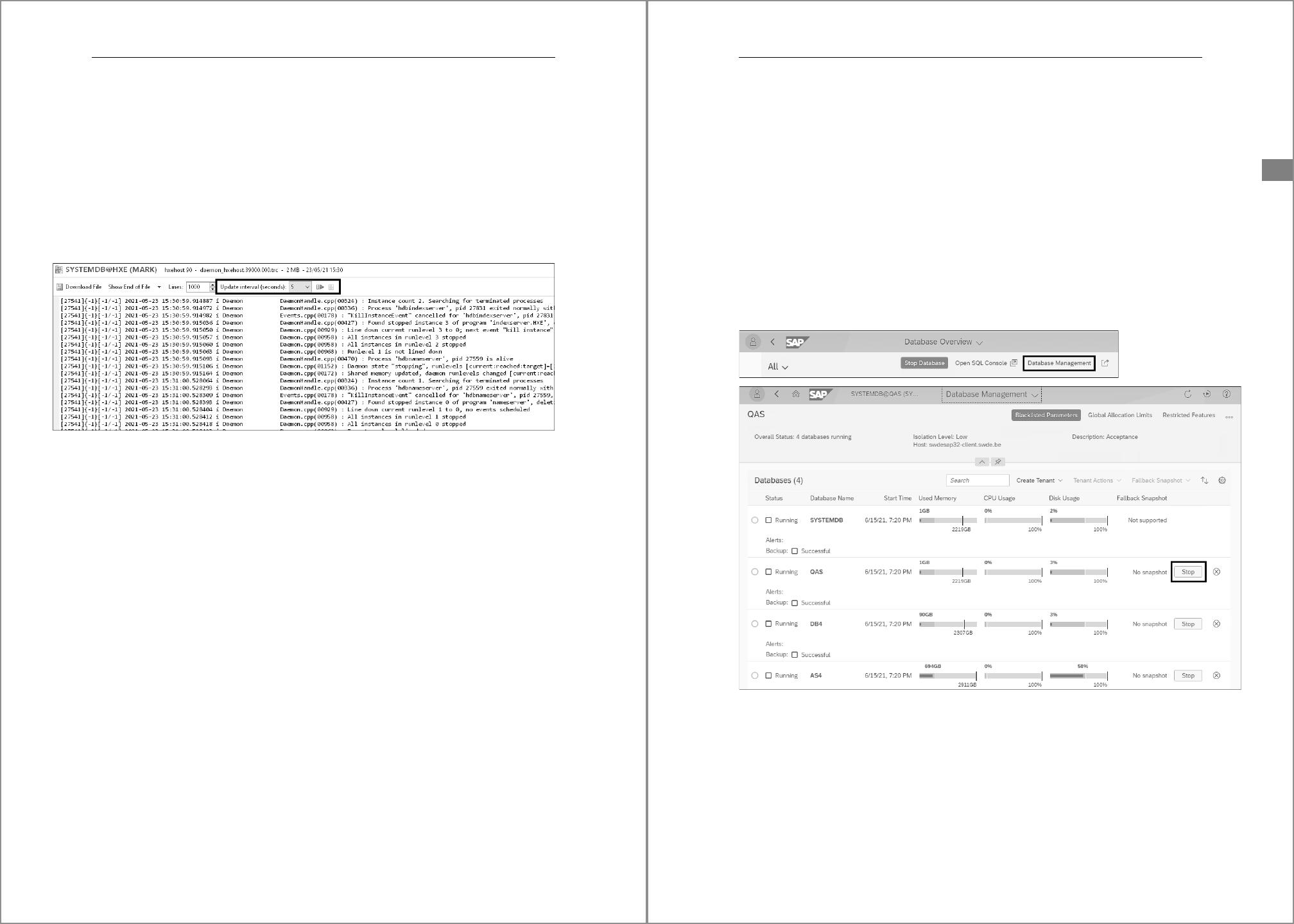
4 Instance Administration
148
Trace Files
While the start or stop process is ongoing, it’s interesting (and necessary, if there’s trou-
ble) to look at the instance trace files. In SAP HANA Studio, you can do so by opening
the Diagnosis Files tab (to the right of the Processes tab in Figure 4.11). The trace file you
may want to look at first is the one for the
hdbdaemon process (daemon_<hostname>.
<service>.000.trc). Double-click the name to display the contents of the file (see Figure
4.12). The screen will show the most recent messages; you can enable an autorefresh
function (right-hand side of the toolbar) so that you always get up-to-date status infor-
mation.
Figure 4.12 Monitoring Daemon Trace File
4.2.3 With SAP HANA Cockpit
According to the SAP HANA Administration Guide, you can start and stop the system by
using the Start System and Stop System buttons at the top of the Database Directory
screen. We cannot confirm this because in all the cockpit versions we checked, and
despite satisfying the connection requirements, these buttons proved elusive.
Not that we really see this as a major shortcoming. Given that it’s extremely easy to stop
and start SAP HANA from the command line, this is really what we advise you to do. And
if you insist on using a GUI, the function works impeccably in SAP HANA Studio, which
will probably still be around by the time the issue in the cockpit gets fixed.
4.2.4 Starting and Stopping Tenant Databases
By default, the tenant databases start up automatically when the SAP HANA instance
starts. It’s possible to change this behavior with following SQL statement:
alter database <DB> no restart;
To reinstate the automatic start, use this statement:
alter database <DB> default restart;
149
4.2 Starting and Stopping the Instance
4
These operations require a connection to the system database. You can use three meth-
ods for this:
1. With the command line
Tenant databases can be started and stopped manually with these statements (also
when connected to the system database):
alter system stop database <DB>;
alter system start database <DB>;
2. With SAP HANA cockpit
In the Database Directory window, open a connection to the system database. In
Database Overview, choose Database Management (if you don’t see this button,
then you’re in a tenant database). On the next screen, there’s a Stop or Start button
to the right of each tenant (Figure 4.13).
Figure 4.13 Start/Stop Tenant Database in SAP HANA Cockpit
3. With SAP HANA Studio
There is no specific function in SAP HANA Studio to stop and start tenant databases;
to do this, open a SQL console for a system database connection and use the
alter
system start database/stop database statements shown earlier.

4 Instance Administration
150
4.2.5 Checking the Instance and Database Status
To check the instance status from the server command line, use HDB info.
We already showed the output of this command in Figure 4.3. If the instance is running,
you’ll see the HDB daemon process with the service processes underneath it. The pres-
ence of one or more
hdbindexserver processes indicates that the tenant databases are
also active.
To see the status of all databases, use the following query when connected to the sys-
tem database:
select * from M_DATABASES;
The ACTIVE_STATUS column shows the current state of the tenant database; if ACTIVE_
STATUS is 'NO', then ACTIVE_STATUS_DETAILS gives the reason the tenant is down—for
example, because it was stopped manually or because autorestart is disabled.
M_DATABASES View
The M_DATABASES view only provides information about all databases when executed in
the system database. The view also exists for the tenant databases, but there it only
shows the data for the tenant itself.
4.2.6 Managing the SAP Start Service
Stopping the SAP HANA instance using any of the methods we saw in the previous sec-
tions does not end the SAP start service (
sapstartsrv) process itself. This is fine; there’s
normally no need to stop it, and its resource use is close to nothing. There may be
exceptional situations, however, when you do want to stop the service process; further-
more,
sapstartsrv has numerous management and information functions that you
might want to make use of.
All communication with the
sapstartsrv process is done using another program, sap-
control. This program interfaces with the service process using web service calls. A sap-
control command generally takes this form:
sapcontrol -nr <xx> -function <servicename> [<parameters>]
Here, <xx> is the two-digit SAP HANA instance number, <servicename> is the name of
the service function you want to call, and
<parameters> represents the parameters to be
passed to the service function (not every function takes parameters). There are more
command line arguments than this, but only
-nr and -function are mandatory. Use
sapcontrol -h for a list of all options and all service functions with their parameters.
To facilitate the use of commands like
sapcontrol that need the instance number, an
environment variable
TINSTANCE is normally set in the environment of the <hsid>adm
instance administrator. In the first section we first describe how you can stop and start
151
4.2 Starting and Stopping the Instance
4
the SAP start service process; then we look at some of the interesting services you can
invoke with
sapcontrol.
Stopping and Starting sapstartsrv
To stop the service process, use this command:
sapcontrol -nr <xx> StopService
The service will normally stop almost immediately. It’s safe to do this even while the
SAP HANA instance is running; this is because, as we mentioned earlier,
sapstartsrv is
not attached to the SAP HANA process tree (the process at the top of the tree is
sap-
start
). However, as long as the service process is stopped, you can’t use HDB to stop or
start SAP HANA because it needs to interact with
sapstartsrv.
To restart the service process, use this command:
sapcontrol -nr <xx> StartService <HSID>
Notice that the StartService function has the HSID as a mandatory parameter.
There is also a function to restart (stop + start) the service, as follows:
sapcontrol -nr <xx> RestartService
Other Service Functions
We won’t go through the entire list of available functions (and some don’t apply to SAP
HANA anyway), but we’ll show some of the more useful ones.
To check the status of the SAP HANA instance processes, use this command:
sapcontrol -nr $TINSTANCE GetProcessList
If the instance is up, the output is a list of processes with GREEN status. If the output con-
tains a
YELLOW status, then this means that the process is not fully operational (e.g., still
starting), and
GRAY means that the process is stopped. For a stopped instance, you’ll see
something like Listing 4.5.
sapcontrol -nr $TINSTANCE -function GetProcessList
GetProcessList
OK
name, description, dispstatus, textstatus, starttime, elapsedtime, pid
hdbdaemon, HDB Daemon, GRAY, Stopped,,,15427
Listing 4.5 sapcontrol Showing Stopped Process
Use following command to display the log of the sapstartsrv process:
sapcontrol -nr $TINSTANCE GetTraceFile
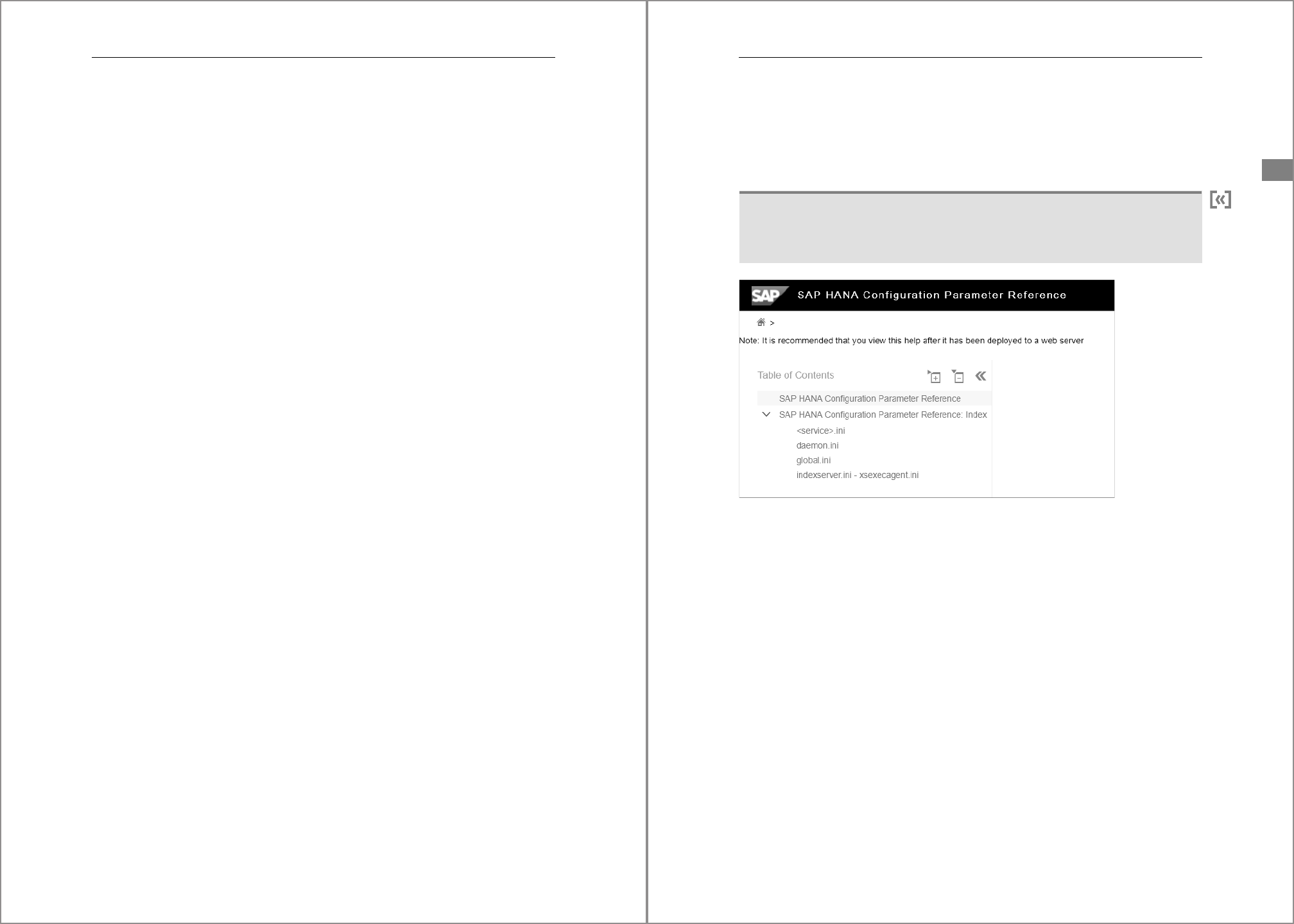
4 Instance Administration
152
The next command lists the environment in which the service process was started; this
can sometimes be useful when troubleshooting if you suspect that environment set-
tings might have been incorrect when the instance was started:
sapcontrol -nr $TINSTANCE GetEnvironment
For version information (of the SAP start service, not of SAP HANA), use this command:
sapcontrol -nr $TINSTANCE GetVersionInfo
/usr/sap/HXE/HDB90/exe/sapstartsrv, 753, patch 512, changelist 1949210, ...
4.3 Maintaining Parameters
We saw in Section 4.1.7 that parameters are stored in INI files on the server and that
these files exist at four layers. The default layer controls the default values of all param-
eters and cannot be changed. At the other three layers, system, database, and host,
parameters can be set in separate layer specific INI files. The hierarchy of layers is as fol-
lows, from highest to lowest:
쐍 HOST
쐍 DATABASE
쐍 SYSTEM
쐍 DEFAULT
Settings of a higher layer override the values set at a lower layer. Which INI files are
operational at which layer can be found in the
M_INIFILES monitoring view, which we
also encountered in Section 4.1.7.
Although the meaning and the hierarchy of the layers seems straightforward, there is
one catch: when you specify the
SYSTEM layer while connected to a tenant database, you
are actually setting that parameter at the
DATABASE layer. We come back to this in the
SQL statement examples.
The INI files are text files, which means that you can not only read but also change
them using a text editor. However, as of version 2.0 SPS 05, the practice of directly edit-
ing the INI files has been deprecated and should no longer be used. In the past, manu-
ally changing the INI files was the only way to modify parameters when SAP HANA was
offline. As of SAP HANA 2.0 SPS 05, SAP delivers a Python script to maintain parame-
ters; this script can be used whether SAP HANA is online or offline. In the following
paragraphs, we describe five different methods to maintain the parameters: using SQL
statements, with the SAP HANA cockpit, with Transaction DBACOCKPIT in ABAP sys-
tems, with SAP HANA Studio, and with the new Python script.
Before we start with this, one word about the documentation: there are hundreds of
parameters, and unless you are vying for the title of SAP HANA uber nerd, there’s no
153
4.3 Maintaining Parameters
4
reason to know them all. However, it’s still useful to have complete documentation for
them available. When you download the SAP HANA documentation (see Appendix B),
the package includes a zipped archive with the SAP HANA Configuration Parameter Ref-
erence Guide. Extract this archive along with the other guides; then, to display the guide
in a browser, open the index.html document (see Figure 4.14).
System Privileges
To maintain parameters, the user must have the INIFILE ADMIN and EXTENDED STORAGE
ADMIN system privileges.
Figure 4.14 Parameter Reference Documentation
4.3.1 With SQL Statements
The SQL statement to change a parameter is ALTER SYSTEM ALTER CONFIGURATION. Use the
keyword
SET to set a parameter for the indicated layer and use UNSET to remove it from
that layer. The general syntax to set or change a parameter is as follows:
ALTER SYSTEM ALTER CONFIGURATION ('filename', 'layer' [, 'name'])
SET ('section', 'parameter') = 'value' [WITH RECONFIGURE]
In the first pair of parentheses, you specify the name of the INI file and the layer; the
second set contains the section (without the square brackets) and the parameter name.
The optional
WITH RECONFIGURE means that the change is both written to the INI file and
applied immediately to the active instance. Without this option, the INI file is changed,
but this change does not take effect until either the instance is restarted or the same
parameter is altered again, but now using
WITH RECONFIGURE. The majority of parame-
ters, but not all of them, can be changed online.

4 Instance Administration
154
For the DATABASE layer, the change applies by default to the database you are currently
connected to. In some cases, however, a change for a tenant database can only be made
when connected to the system database. For the
HOSTS layer, you have to specify an
explicit host; we show this in one of the examples ahead. In both cases, you must use
the
'name' argument, the optional third argument in the first set of parentheses.
Parameter values must always be in single quotes, even if they are purely numeric.
For
UNSET, the syntax is similar—except of course that no parameter value is assigned,
as follows:
ALTER SYSTEM ALTER CONFIGURATION (filename, layer)
UNSET (section, parameter) [WITH RECONFIGURE]
Let’s walk through a fully worked out example, which also demonstrates the catch with
the database and system layers we mentioned earlier. We want to set a parameter that
deals with table repartitioning for tenant database P50 in SAP HANA instance HQ1 (for
now, don’t worry about what this means; we’ll come back to this parameter again in
Chapter 12). The
max_rows_per_partition parameter is found in the [table_placement]
section of the global.ini file.
Before making the change, we inspect the INI files on the server, first at the system
level, as follows:
$ cd /usr/sap/HQ1/SYS/global/hdb/custom/config
$ grep max_rows_per_partition global.ini
(nothing found)
For the system layer, global.ini exists but it doesn’t contain a setting for our parameter.
We next look at the tenant database layer:
$ cd DB_P50
$ cat global.ini
global.ini: No such file or directory
No global.ini file even exists for the tenant database yet.
We now connect to the tenant and set the parameter at the database layer, as follows:
$ hdbsql -d P50 -u ...
ALTER SYSTEM ALTER CONFIGURATION ('global.ini', 'DATABASE')
SET ('table_placement','max_rows_per_partition') =
'500000' WITH RECONFIGURE;
We then check the tenant database INI file directory again, as shown in Listing 4.6.
$pwd
/usr/sap/HQ1/SYS/global/hdb/custom/config/DB_P50
$ cat global.ini
155
4.3 Maintaining Parameters
4
# global.ini last modified <date> <time> by hdbindexserver -port 30158
[table_placement]
max_rows_per_partition = 500000
Listing 4.6 New INI File Created
The system correctly created global.ini at the database layer and registered the one
parameter that we set.
We now decide that we want to make this setting apply to the entire system. We con-
nect to the system database and use the same statement, but now for the system layer:
$ hdbsql -d SYSTEMDB -u ...
ALTER SYSTEM ALTER CONFIGURATION ('global.ini', 'SYSTEM')
SET ('table_placement','max_rows_per_partition') =
'500000' WITH RECONFIGURE;
We check whether the change was applied to the system layer global.ini, as follows:
$ cd /usr/sap/HQ1/SYS/global/hdb/custom/config
$ grep max_rows_per_partition global.ini
max_rows_per_partition = 500000
The parameter now exists the system layer.
Later, after some testing, we decide that a better setting would be 1 million instead of
500,000. We want to make this change at the system layer. We connect (mistakenly, as
we will see) to the tenant database instead of the system database, as follows:
$ hdbsql -d P50 -u ...
ALTER SYSTEM ALTER CONFIGURATION ('global.ini', 'SYSTEM')
SET ('table_placement','max_rows_per_partition') =
'1000000' WITH RECONFIGURE;
Let’s verify that the change has indeed been applied in the INI file of the system layer,
as follows:
$ cd /usr/sap/HQ1/SYS/global/hdb/custom/config
$ grep max_rows_per_partition global.ini
max_rows_per_partition = 500000
Somehow the system seems to have ignored our command and the parameter is
unchanged. What about the tenant database layer?
$ cd /usr/sap/HQ1/SYS/global/hdb/custom/config/DB_P50
$ grep max_rows_per_partition global.ini
max_rows_per_partition = 1000000
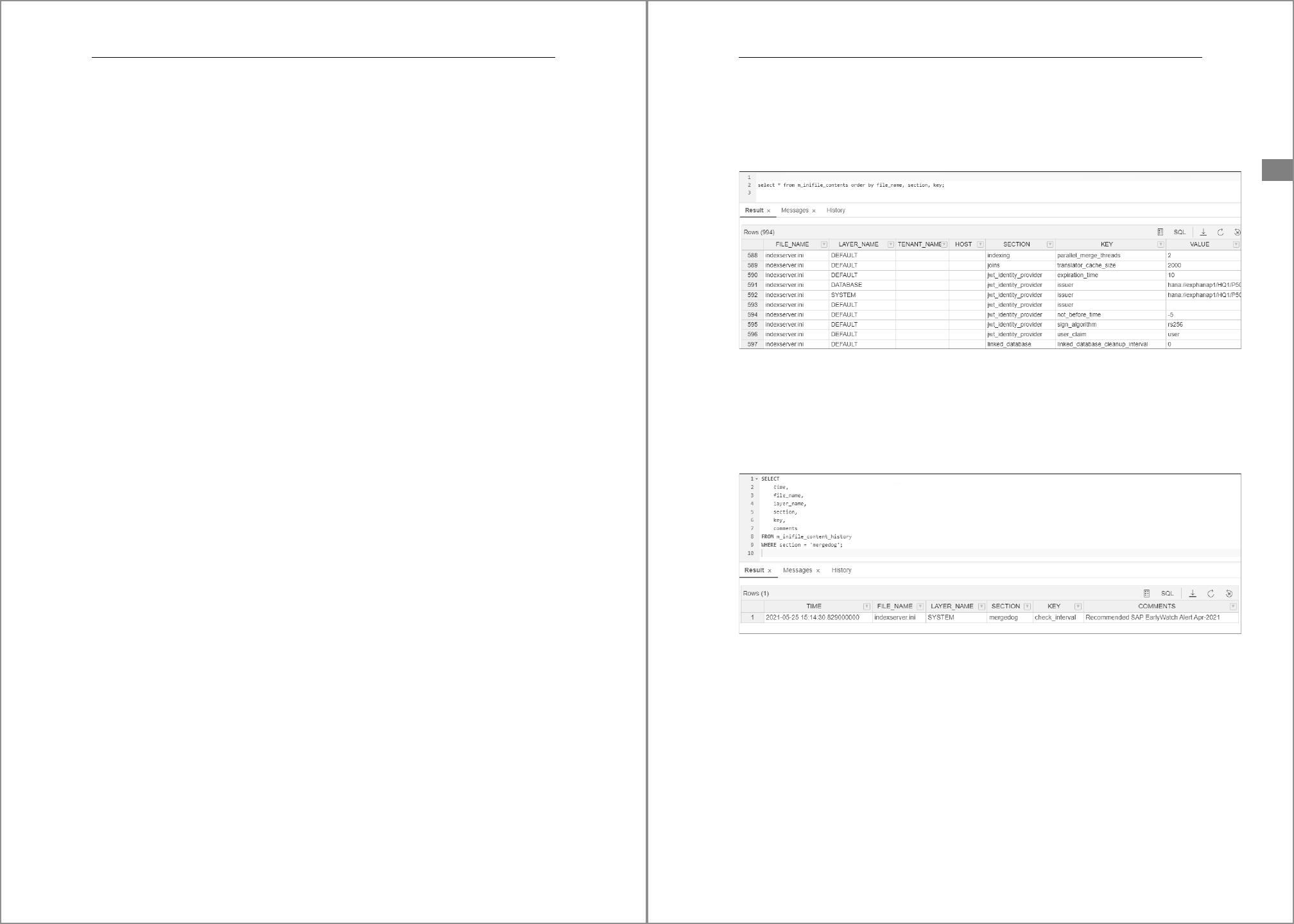
4 Instance Administration
156
This is the catch we talked about: we specified 'SYSTEM' as the layer in the SQL state-
ment, but because we were connected to a tenant database, the system handled this as
if we had specified
'DATABASE'.
Before describing how you can display the current parameter settings, let’s look at a
few more examples. The next statement shows the use of the
HOSTS layer. The first time
we’re connected to the tenant database, as follows:
$ hdbsql -d P50 -u ...
ALTER SYSTEM ALTER CONFIGURATION ('global.ini', 'HOST', 'exphanap1')
SET ('table_placement','max_rows_per_partition') =
'1000000' WITH RECONFIGURE;
* 2: general error: Configuration layer HOST can only be used in SYSTEMDB
No catch here: for the HOSTS layer, the system wants you to connect specifically to the
system database. We will oblige, as follows:
$ hdbsql -d SYSTEMDB -u ...
ALTER SYSTEM ALTER CONFIGURATION ('global.ini', 'HOST', 'exphanap1')
SET ('table_placement','max_rows_per_partition') =
'1000000' WITH RECONFIGURE;
Check the INI file directory for the host layer, as follows:
$ cd /usr/sap/HQ1/HDB01/exphanap1
$ grep max_rows_per_partition global.ini
max_rows_per_partition = 1000000
Finally, let’s get rid of the parameter change at all levels, as shown in Listing 4.7.
$ hdbsql -d SYSTEMDB -u ...
ALTER SYSTEM ALTER CONFIGURATION ('global.ini', 'HOST', 'exphanap1')
UNSET ('table_placement','max_rows_per_partition') WITH RECONFIGURE;
ALTER SYSTEM ALTER CONFIGURATION ('global.ini', 'SYSTEM')
UNSET ('table_placement','max_rows_per_partition') WITH RECONFIGURE;
-- Switch to the tenant
\co -d P50 -u ...
ALTER SYSTEM ALTER CONFIGURATION ('global.ini', 'DATABASE')
UNSET ('table_placement','max_rows_per_partition') WITH RECONFIGURE;
Listing 4.7 Unset Parameter at All Levels
With parameter changes, it’s often useful to document the reason for the change. You
can do this by adding a
COMMENT clause to the SQL statement, as follows:
ALTER SYSTEM ALTER CONFIGURATION ('indexserver.ini', 'SYSTEM')
SET ('mergedog', 'check_interval') = '30000' WITH RECONFIGURE
COMMENT 'Recommended SAP EarlyWatch Alert Apr-2021';
157
4.3 Maintaining Parameters
4
To display the current parameter settings, you can query the M_INIFILE_CONTENTS mon-
itoring view. The view contains one record per parameter per layer where it’s defined.
Figure 4.15 shows an example. The
HOST column is filled in only for parameters of the
HOSTS layer. The TENANT_NAME column is no longer in use.
Figure 4.15 Parameter Values in Monitoring View M_INIFILE_CONTENTS
Note that if you document the parameter changes with the COMMENT option, you won’t
see this comment in
M_INIFILE_CONTENTS (nor will you find it in the INI file). To see these
comments, you must query another monitoring view,
M_INIFILE_CONTENT_HISTORY, as
shown in Figure 4.16.
Figure 4.16 Change History and Comments in M_INIFILE_CONTENT_HISTORY
4.3.2 With the SAP HANA Cockpit
In this section, we’ll walk you through managing parameters with the SAP HANA cock-
pit. Look at Figure 4.17 and proceed as follows:
1 Start in the Database Directory app and select the database and connection and user.
As described earlier, connect to the system database if you want to change parame-
ters of the
SYSTEM and HOSTS layers; for parameters on the DATABASE layer, connect to
the tenant.
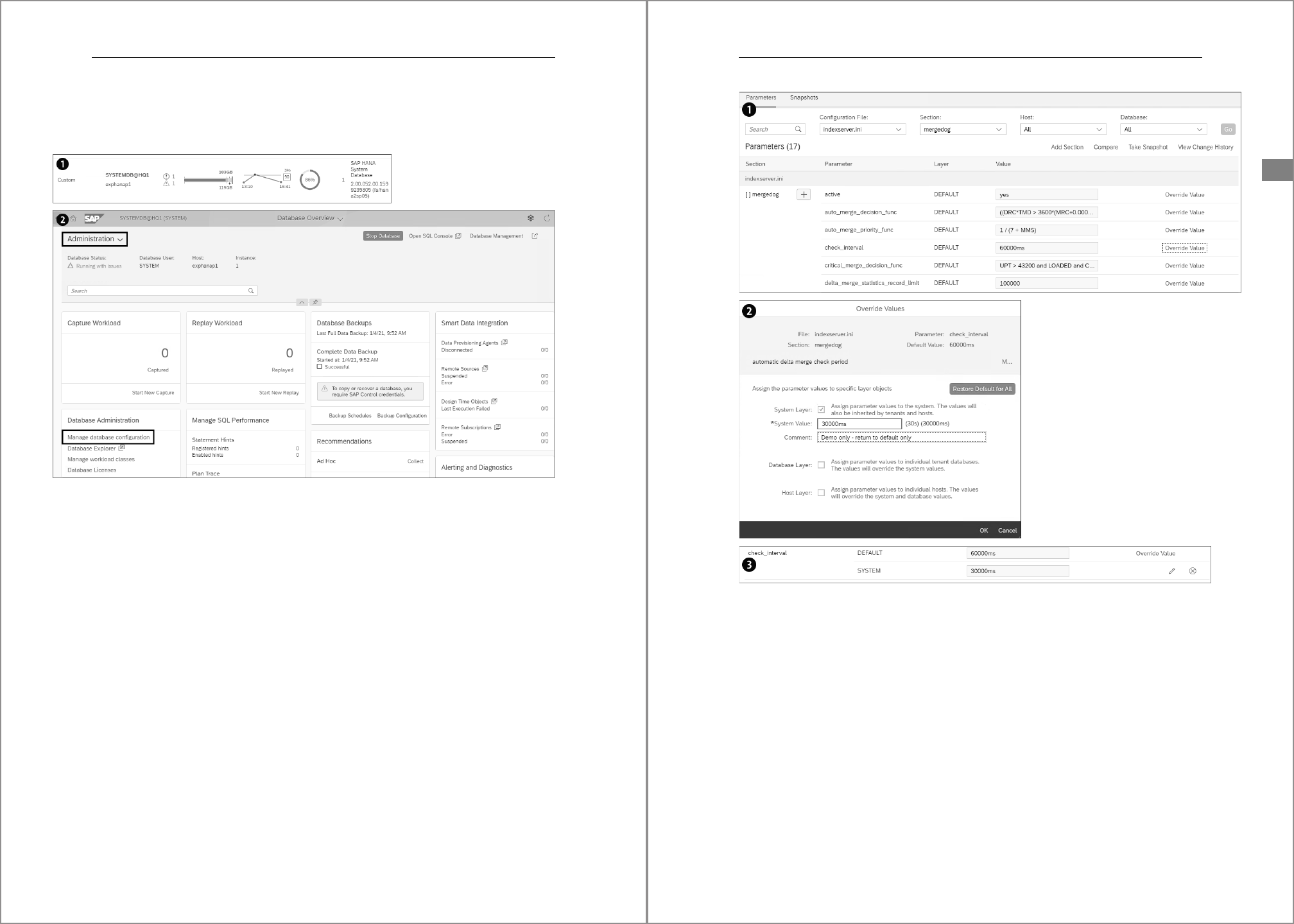
4 Instance Administration
158
2 The Database Overview app opens. In the top-left corner, change the context to
Administration or All. Scroll down to Database Administration section; there, click
Manage Database Configuration.
Figure 4.17 Maintain Parameters in SAP HANA Cockpit: Part 1
Now examine Figure 4.18, and proceed as follows:
1 Initially all parameters for all layers are listed, which in our test system amounted to
almost 2,000 entries. To make this manageable, use the filtering fields at the top to
restrict the list to what you are interested in. Here we want to manage parameters in
the
[mergedog] section of indexserver.ini. To change a parameter, click Override
Value.
2 A pop-up window opens in which you can choose the layer (system, database, or
host). Enable the checkbox for the layer you want to modify. You can now enter a
value and an optional comment. If the value is expressed in a specific unit (here, mil-
liseconds), then you will automatically be shown a list of acceptable units. Choose
OK to save your change.
3 The new setting is now listed along with the default (for which Override Value
remains available in case you want to make a different setting for another layer).
With the icons to the right of the custom setting, you can either change the value
again or remove it (the equivalent of
UNSET in the SQL statement).
159
4.3 Maintaining Parameters
4
Figure 4.18 Maintain Parameters in SAP HANA Cockpit: Part 2
4.3.3 With Transaction DBACOCKPIT
In DBA Cockpit, choose Configuration 폷 INI Files. The list of INI files appears on the right.
Open the file and section of the parameters you are interested in. The parameters in the
sections are listed with their values at the different layers (see Figure 4.19).
To maintain a parameter, double-click its entry in the list. In the pop-up window shown
in Figure 4.20, enter the new value. In this case, we’re using the default connection to
the tenant database, which means that we’re only offered the option to change the
system/database layer (remember that for tenant databases these layers are one and
the same thing). Click Save Change to save the new value to the INI file and to change

4 Instance Administration
160
the active setting for the instance if the parameter is dynamically changeable; as with
the SAP HANA cockpit, the
WITH RECONFIGURE clause is implicit and you cannot change
this behavior. Unlike the SAP HANA cockpit, DBA Cockpit doesn’t let you enter a com-
ment.
Figure 4.19 Display Parameters in DBA Cockpit
Figure 4.20 Maintain Parameters in DBA Cockpit
You must choose Refresh in the main SAP HANA cockpit window before the modified
value is displayed (Figure 4.21).
To return the parameter to its default setting, double-click and then choose Save
Default, shown in the window in Figure 4.20. Refresh the parameter list and the former
change will no longer be visible.
161
4.3 Maintaining Parameters
4
Figure 4.21 Display Changed Parameter in DBA Cockpit
4.3.4 With SAP HANA Studio
In SAP HANA Studio, open the Administration Console and go to the Configuration tab.
Expand the list of INI files and the sections to get to the parameter you’re interested in
(see Figure 4.22). The gray diamonds mean that specific settings exist for the indicated
layer.
Figure 4.22 Display Parameters in SAP HANA Studio
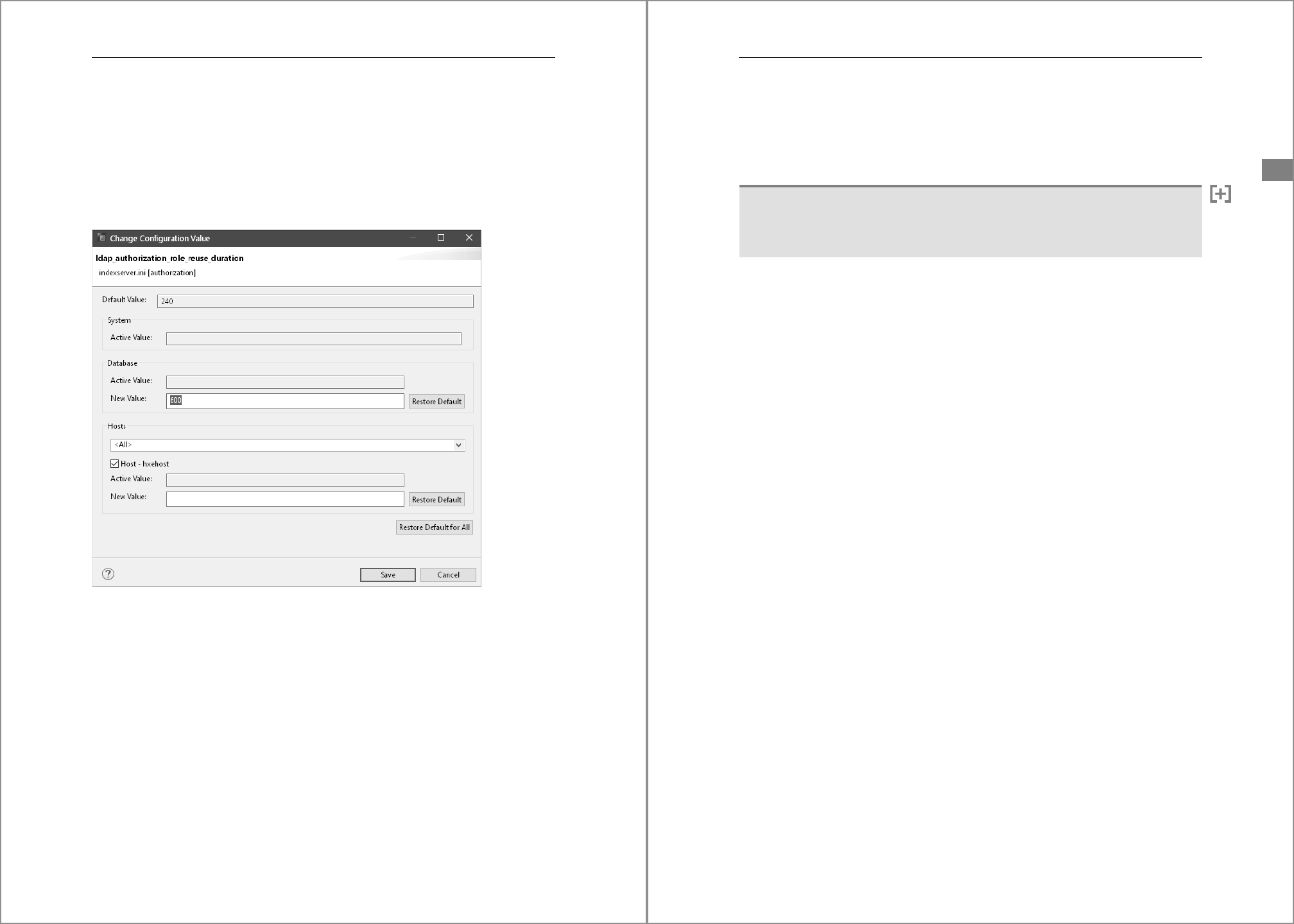
4 Instance Administration
162
Double-click a parameter to change its value, which opens the window shown in Figure
4.23. The layers that are available for input depend on the connection. In this case, we’re
connected to the tenant database, which only allows us to set the database layer (the
hosts layer is also enabled for input, but entering a value there will be rejected with the
error Communication layer HOST can only be used in SYSTEMDB).
The WITH RECONFIGURE option is used implicitly, so changes to dynamic parameters take
effect immediately. It isn’t possible to add a comment.
Figure 4.23 Maintain Parameters in SAP HANA Studio
4.3.5 With setParameter.py
This Python script is new in SAP HANA 2.0 SPS 05. You can use it to change parameters
from the command line, regardless of whether the SAP HANA instance is online or
offline. If the instance is offline, using this script replaces direct editing of the INI files
(which is deprecated). For the parameters, you must specify the layer, file name, section
name, and parameter name separated by forward slashes (
/). Before running the script,
use the
cdpy alias to switch to the Python support directory—for example:
cdpy
python setParameter.py -set 'SYSTEM/indexserver.ini/mergedog/check_interval = 30000'
python setParameter.py -unset 'SYSTEM/indexserver.ini/mergedog/check_interval'
163
4.3 Maintaining Parameters
4
To set a parameter at the database layer, you must specify the name of the tenant data-
base, as follows:
python setParameter.py \
-set 'DATABASE:P50/indexserver.ini/mergedog/check_interval = 30000'
Backslash to Indicate More Lines to Follow
For long Linux shells spanning more than one line, use the backslash character (\) to
indicate that more lines will follow.
For the hosts layer, you may omit the hostname, which then defaults to the current
host, or specify a hostname explicitly, as shown in Listing 4.8.
python setParameter.py \
-set 'HOSTS/indexserver.ini/mergedog/check_interval = 30000'
python setParameter.py \
-set 'HOSTS:exphanap1/indexserver.ini/mergedog/check_interval = 30000'
Listing 4.8 Specifying HOSTS Layer with setParameter.py
By default, the script only changes the parameter in the INI file; for a dynamic parame-
ter, the active value is not changed. This matches the behavior of the
ALTER SYSTEM ALTER
CONFIGURATION
command, but it’s contrary to the behavior in the SAP HANA cockpit,
SAP HANA Studio, and Transaction DBACOCKPIT. Use the
-reconfigure option to also
change the parameter in the running instance, as follows:
python setParameter.py \
-set 'SYSTEM/indexserver.ini/mergedog/check_interval = 30000' -reconfigure
You can also add comments, as follows:
python setParameter.py \
-set 'SYSTEM/indexserver.ini/mergedog/check_interval = 30000' \
-comment "For testing only, return to default later"
It’s possible to change multiple parameters in one call of the script, as shown in List-
ing 4.9.
python setParameter.py \
-set 'SYSTEM/indexserver.ini/password policy/minimal_password_length = 12' \
-unset 'SYSTEM/ indexserver.ini/password policy/minimum_password_lifetime' \
-set 'DATABASE:P50/indexserver.ini/password policy/minimal_password_length = 16' \
-set 'DATABASE:P50/indexserver.ini/password policy/last_used_passwords = 8' \
-set 'DATABASE:P50/indexserver.ini/password policy/minimum_password_lifetime = 7'
-with reconfigure
Listing 4.9 Changing Multiple Commands at Once with setParameter.py

4 Instance Administration
164
Adding the -sapcontrol=1 option appends an extra line to the output in a format that
can be easily parsed by text-processing commands, a very common practice in UNIX
and Linux shell scripts, as shown in Listing 4.10.
python setParameter.py \
-set 'SYSTEM/indexserver.ini/password policy/last_used_passwords = 8' \
-sapcontrol=1
Setting parameters succeeded
SAPCONTROL-OK:
python setParameter.py \
-set 'DATABASE:V10/indexserver.ini/password policy/last_used_passwords = 8' \
-sapcontrol=1
SAPCONTROL-ERROR: DATABASE:V10/indexserver.ini/password policy/last_used_
passwords = 8 unknown database name
Listing 4.10 Using -sapcontrol=1 Option with setParameter.py
4.3.6 Protecting against Unsupported Parameter Values
Until SAP HANA 2.0 SPS 03, it was possible to give any value to a parameter. SAP HANA
would accept the setting without applying any form of consistency or even basic sanity
check. Starting with SAP HANA 2.0 SPS 04, it’s possible to protect against this by setting
the
unsupported_configuration_change parameter in the [configuration] section of the
global.ini file.
Possible values are
'none', 'warning', and 'error'. The default is 'warning', which means
you’re still able to set a parameter to some absurd value, but at least the system will
inform you that you are doing so. We recommend setting this parameter to
'error' for
the SYSTEM layer, as follows:
-- Connected to SYSTEMDB:
alter system alter configuration('global.ini','SYSTEM')
set ('configuration','unsupported_configuration_change') =
'error' with reconfigure;
Watch Your Spelling
Even with the parameter set to 'error', it’s still possible to specify a nonexistent sec-
tion or parameter name. Although this may sometimes be needed to implement SAP
support advice, it also means that you must be extremely careful not to make mis-
takes. Consider these three parameter settings:
쐍 set ('password policy','minimal_password_length) = 16 <<< command 1
쐍 set ('password_policy','minimal_password_length) = 16 <<< command 2
쐍 set ('password policy','minimum_password_length) = 16 <<< command 3
165
4.4 Managing Memory
4
Only command 1 is correct, but in reality all three commands will work! Command 2
(with an underscore instead of a space in the section name) will create a new section
by that name in the INI file. Command 3 (in which the parameter name is wrong) will
create a parameter with the specified name alongside the “real” parameter, the value
of which remains unchanged.
The graphical tools have an advantage here because they let you start from a list of
parameters displayed by the tool. They still allow you to create new sections and
parameters, but at least it’s a conscious action by the user.
4.4 Managing Memory
When thinking about an in-memory database system, it’s easy to understand that
memory is its most fundamental resource. The way the SAP HANA system utilizes
memory will to a large extent define how well that system is performing. Here we take
a closer look at how memory is structured and managed. We first describe how SAP
HANA organizes its memory and how the memory layout relates to that of the server.
We then see how memory is allocated (Section 4.4.2) and what happens when there
isn’t enough of it (Section 4.4.3). Section 4.4.4 introduces heap memory, which is pro-
cess-specific, and shared memory, which is shared among all processes in the instance.
In Section 4.4.5, you’ll learn how to limit the amount of memory SQL statements can
use, which is quite useful if such a statement misbehaves. The last two sections deal
with the monitoring of memory at the server level (Section 4.4.6) and for the SAP
instance (Section 4.4.7).
4.4.1 Memory Layout
Figure 4.24 shows the general layout of memory on the server (left) and memory spe-
cific for SAP HANA (right). To start with the diagram on the left, the physical memory
(RAM) installed in the database server is used partially by the operating system itself,
partially by other processes unrelated to SAP HANA, and partially (a major part) by SAP
HANA. The combined usage from all memory consumers might be smaller than the
available RAM; in that case, part of the physical memory remains free. If demand for
physical memory exceeds the available capacity, then the operating system will swap
out part of the programs’ memory pages to the swap area on disk according to a least
recently used (LRU) algorithm. Swapping imposes a severe performance penalty on the
affected processes, and in a correctly sized SAP HANA server it shouldn’t occur at all.
The diagram on the right in Figure 4.24 shows the structure of the memory used by SAP
HANA. Like every other application, SAP HANA is a collection of programs; these pro-
grams need memory to store their code instructions (also known as program text) and
their stack (for data variables). All other memory allocated by SAP HANA is used on

4 Instance Administration
166
behalf of the database system. This area is called the SAP HANA memory pool. The pool
itself is made up of two major areas: the first and largest is used for the in-memory stor-
age of tables. As we will see later in much more detail, database tables belong either to
the row store or the column store, depending on the storage model that they follow.
Normally, the column-store tables are both larger and far more numerous than the
row-store tables, which means that they also occupy a significantly larger part of the
pool. The second area holds the memory structures needed for database management.
If the two areas combined take up less space than the total size of the pool, then the
memory pool contains a free area. This space is free only from the perspective of SAP
HANA; for the operating system, the memory is allocated and in use. SAP HANA will
not normally return free memory in the pool to the OS; the memory is kept in the pool
and serves to satisfy surges in demand, such as when the size of the table memory
increases.
Figure 4.24 Memory Layout
4.4.2 When and How Memory Is Allocated
When SAP HANA is started, it doesn’t allocate the entire memory pool in one go. It
requests memory from the OS as demand increases, and this continues until it reaches
a maximum quantity, the global allocation limit. This limit is set via the
global_alloca-
tion_limit
parameter in the [memory] section of the global.ini file.
The default setting is 0, which means that the global allocation limit is computed in the
function of the physical memory of the server using the following rules:
쐍 90% of the first 64 GB
쐍 97% of the capacity above 64 GB
Swap Area
Code and Stack
Row Store
Column Store
System Tables
Database Management
Free Area in Memory Pool
SAP HANA Memory
Table Memory
Other Processes
SAP HANA
Free Physical Memory
Server Memory (RAM)
O/S
SAP HANA
Memory Pool
167
4.4 Managing Memory
4
There is normally no reason to deviate from the standard setting, with two possible
exceptions:
쐍 If the server runs more than one SAP HANA system, then each system should have
its global allocation limit set so that the combined limit doesn’t exceed the capacity
of the server.
쐍 If the license sets a limit on the memory size, then the global allocation limit must of
course respect the licensing conditions.
If you do set the global allocation limit explicitly, then you can express it either as an
absolute number of megabytes or as a percentage of physical memory. The advantage
of the latter is that if the installed physical memory changes, the global allocation limit
adapts accordingly.
When the SAP HANA instance needs more memory and the pool size is below the
global allocation limit, then the instance will request extra memory from the OS—but,
as we stated in the previous paragraph, the opposite is not true: when memory in the
pool becomes available again, such as when a query with a very large result set has
ended, then this memory is not returned to the OS but is retained for later use.
In a multitenant installation, it’s possible to set an allocation limit per tenant. The
parameter for this is
allocationlimit in the [memory] section of the global.ini file.
This setting can only be made from the system database; changing the allocation limit
from inside the tenant is not allowed. This is one of the situations in which you must
explicitly specify a database name in addition to the
DATABASE layer in the ALTER SYSTEM
ALTER
CONFIGURATION statement. For example, the following command sets an allocation
limit of 64 GB for the DEV tenant database:
hdbsql -d SYSTEMDB ...
alter system alter configuration('global.ini','DATABASE', 'DEV')
set ('memorymanager','allocationlimit') = '65536' with reconfigure;
4.4.3 Memory Shortages
When SAP HANA runs out of available memory, it will use a series of increasingly inva-
sive strategies to try and reclaim memory:
1. Return remaining free segments in the pool to the OS. It may seem contradictory to
release memory when there isn’t enough of it, but the reason is that the OS can do a
better job at defragmentation. By requesting memory back after releasing it, SAP
HANA may be able to satisfy large memory requests.
2. Perform garbage collection. The term garbage collection is well-known in the con-
text of programming languages and denotes the process of freeing up memory
areas that are no longer in use; in an object-oriented language, for instance, the gar-
bage collector deletes objects that no longer have an active reference. In SAP HANA,
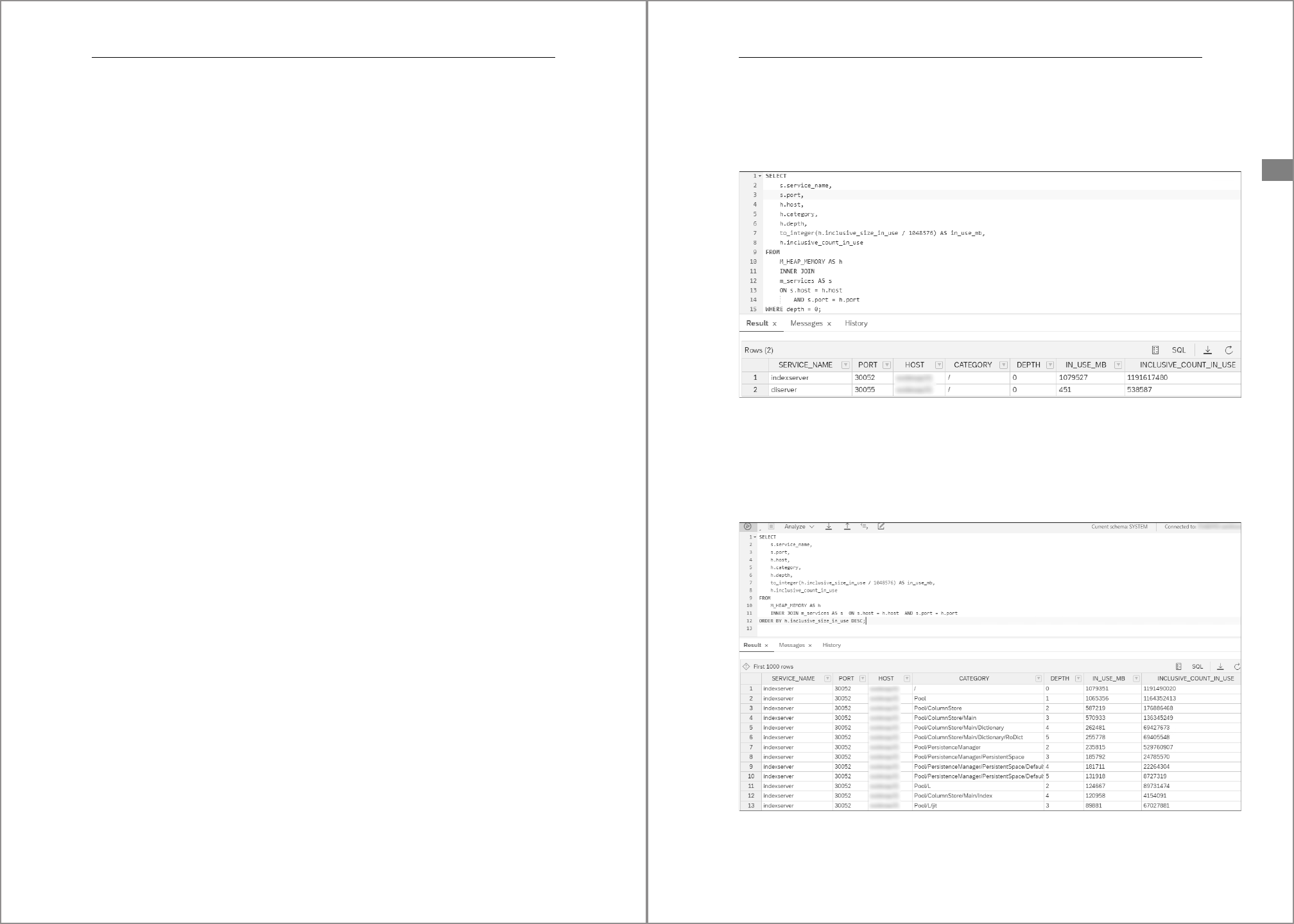
4 Instance Administration
168
it covers a range of techniques that are applied to different memory areas; you can
find more details in SAP Note 2169283. This note documents a long list of parameters
that control the behavior of the various garbage collectors. Perhaps the most
important of these is the memory garbage collector, which is lazy by default and
only kicks in when the instance hits the global allocation limit. This behavior can be
altered, but SAP recommends leaving it alone.
3. Shrink resource containers. One of the most important activities that takes place
here is the unloading of column-store tables. The implication of this is of course that
the next time the unloaded column is accessed, it must be reloaded from per-
sistence, which causes disk I/O and penalizes performance. In deciding which col-
umns to unload, SAP HANA uses a priority scheme (documented in SAP Note
2169283) aimed at keeping the impact as small as possible, but there will always be a
price to pay.
4. Terminate transactions. If SAP HANA can no longer satisfy the memory require-
ments of active transactions, it can decide to forcibly terminate them.
5. Produce an out-of-memory (OOM) dump. Whatever action couldn’t have its mem-
ory requirements met is terminated, and an OOM dump file is written to the trace
directory. We introduced trace files in Section 4.1.8 and describe them in detail in
Chapter 15. The OOM dump is not a dump of the entire memory (fortunately), but a
text file containing the most relevant information about the conditions in which
the dump occurred. The name of the file follows this format:
<processname>_<hostname>.<number>.rtedump.<number>.oom.trc
For example, it could look like this:
indexserver_exphanap1.12345.rtedump.98765.oom.trc
SAP Note 1984422 contains information on how to analyze OOM dumps.
4.4.4 Heap Memory and Shared Memory
Before we explain how you can monitor SAP HANA memory, we must introduce two
new terms: heap memory and shared memory. Heap memory is memory that can only
be accessed by the threads of a single process. For example, the heap memory allocated
by the index server is only usable by the index server threads. Shared memory, on the
other hand, is accessible to several processes. Data structures that must be used by sev-
eral services are stored in shared memory. The memory SAP HANA uses can be divided
into these two categories.
Heap memory is assigned through allocators. Each allocator belongs to a specific ser-
vice; there are numerous allocators (more than 1,000 for the index server alone), orga-
nized in a hierarchical tree with a root allocator at the top. You can find the memory
statistics per allocator in the
M_HEAP_MEMORY monitoring view. Figure 4.25 shows heap
usage statistics for an SAP S/4HANA tenant consolidated by service (
DEPTH = 0 indicates
169
4.4 Managing Memory
4
the top-level allocator record for the service; memory usage at a certain depth is the
sum of usages of all subordinate allocators). As can be expected, the largest memory
consumer, here with over 1 TB, is the index server. The
INCLUSIVE_COUNT_IN_USE column
shows the number of allocations since startup.
Figure 4.25 Heap Memory by Service
Figure 4.26 shows the same view, but sorted by memory usage (keep in mind that the
totals are consolidated at lower depths, so you must not add the usages together). Most
of the allocator names in the screenshot are somewhat comprehensible, but if you
descend further the names will quickly become much more cryptic.
Figure 4.26 Heap Memory Allocators
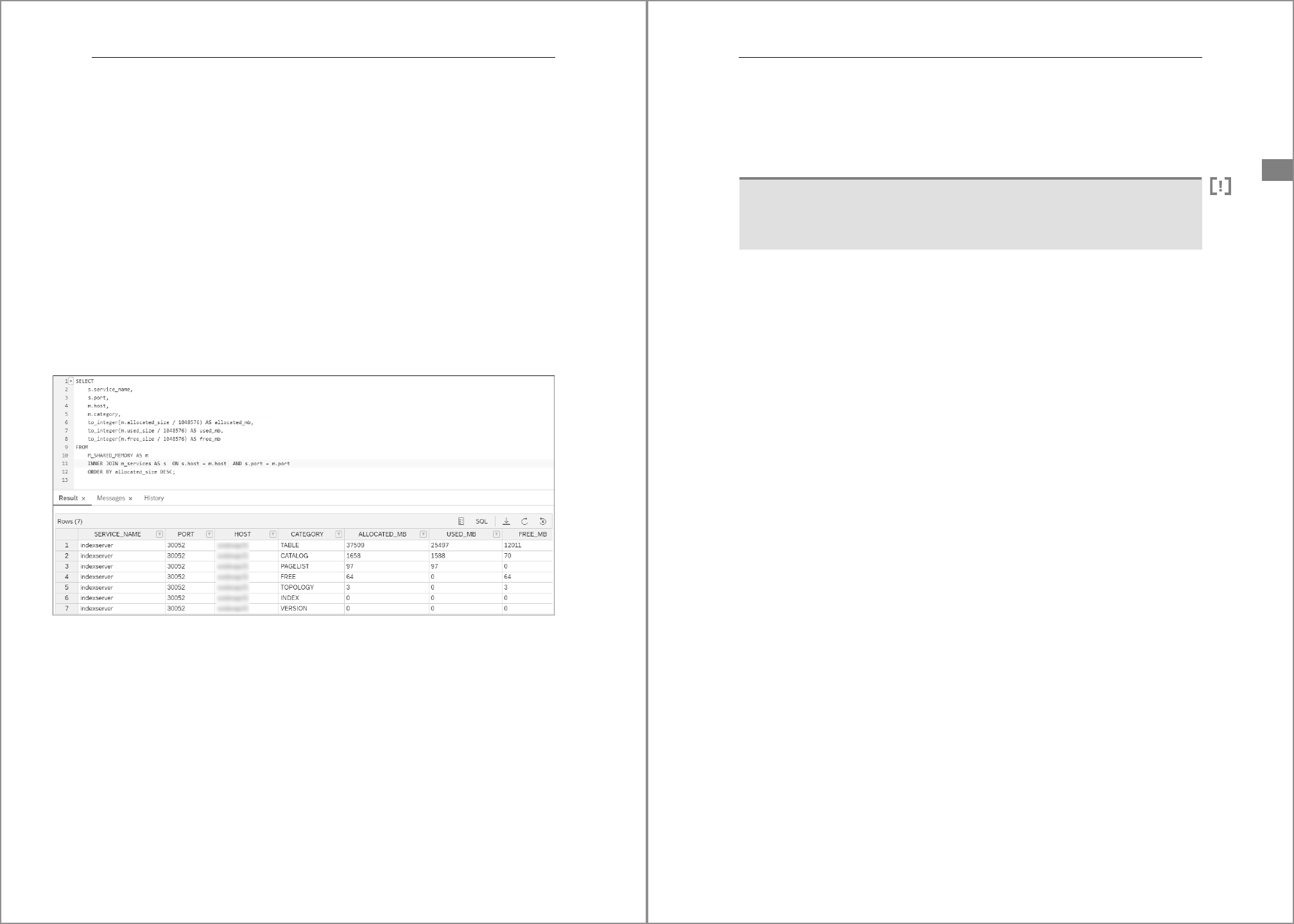
4 Instance Administration
170
It isn’t necessary to know the functions of these allocators, but if you see one that
apparently uses an abnormally large amount of memory, then it’s best to do an SAP
Note search using that allocator name as the search key. SAP Note 1999997 contains a
table that lists known cases of excessive memory usage by specific allocators.
M_HEAP_MEMORY has an accompanying reset view, M_HEAP_MEMORY_RESET; a reset view lets
you collect statistics relative to a chosen point in time instead of since startup. We
describe reset views in Chapter 15. Usage history over a longer period (six weeks by
default) is available in the
_SYS_STATISTICS.HOST_HEAP_ALLOCATORS statistics server view
(we see these views also in Chapter 15).
For shared memory, the monitoring view is
M_SHARED_MEMORY. Figure 4.27 shows the
shared memory statistics for the same SAP S/4HANA tenant. All shared memory areas
in this database are owned by the index server (but are accessible to the other services).
The
TABLE category (which contains the row store) is by far the largest user of shared
memory, but even then it’s more than an order of magnitude smaller than the heap
memory.
Figure 4.27 Shared Memory
4.4.5 Memory for SQL Statements
Complex SQL statements, and especially multitable joins, sometimes do unexpected
things. One of the more unpleasant of these is producing gigantic result sets because of
some flaw in the join logic. Because result sets are memory objects, these out-of-control
monsters can have a serious impact on the memory usage of the instance. Since ver-
sion 1.0 SPS 08, it’s therefore possible to set a limit on the amount of memory that
SQL statements may use. There are two different limits, each controlled via an INI file
parameter in the
[memorymanager] section of the global.ini file. The first of these param-
eters sets the maximum memory for a single statement:
statement_memory_limit.
171
4.4 Managing Memory
4
The second parameter limits memory usage for all SQL statements combined: total_
statement_memory_limit
.
Neither parameter is set by default, which means that no limit on SQL statement mem-
ory applies.
Gigabytes, not Megabytes
Confusingly, the unit for these parameters is gigabytes, not megabytes like for the allo-
cation limits.
Note that to make SAP HANA apply these limits, it’s necessary to enable statement
memory tracking in the
[resource_tracking] section of the global.ini file using the fol-
lowing parameters:
쐍 enable_tracking = 'on'
쐍 memory_tracking = 'on'
With tracking enabled, the memory usage metrics are available in the M_CONTEXT_MEMORY
monitoring view with reset companion M_CONTEXT_MEMORY_RESET.
Setting an absolute value as the memory limit for an SQL statement has a drawback. For
example, suppose that the limit is set to 20 GB. Running a statement that potentially
uses more than this amount of memory is certainly an issue when the system is very
busy and the memory almost full, but running that same statement in the middle of
the night with a terabyte of memory sitting unused shouldn’t be a concern. To enable
making a distinction between these two situations, SAP introduced an additional
parameter:
statement_memory_limit_threshold in the [memorymanager] section.
This parameter sets a percentage of the global allocation limit: only if the total used
memory exceeds that percentage will the statement memory limit be honored. For
example, if the global allocation limit is 500 GB and the threshold parameter is set to
80%, then SQL statements will be allowed to use more memory than the limit as long
as the total used memory is less than 400 GB. Note that by default the parameter is set
to 0, which means that the statement limit is applied unconditionally.
4.4.6 Host Memory Statistics
A final monitoring view we want to present is M_HOST_RESOURCE_UTILIZATION. This view
contains capacity and resource usage information for the database host, as well as
global memory usage data for the SAP HANA instance. Figure 4.28 shows some import-
ant metrics from this view. Here we can see that approximately 2,954 GB of physical
memory was allocated, with 141 GB still free. The SAP HANA instance had allocated
3,094 GB, of which 1,396 GB was currently in use; peak usage since server start was 1,654
GB. It may seem surprising that the memory allocated by SAP HANA is greater than the
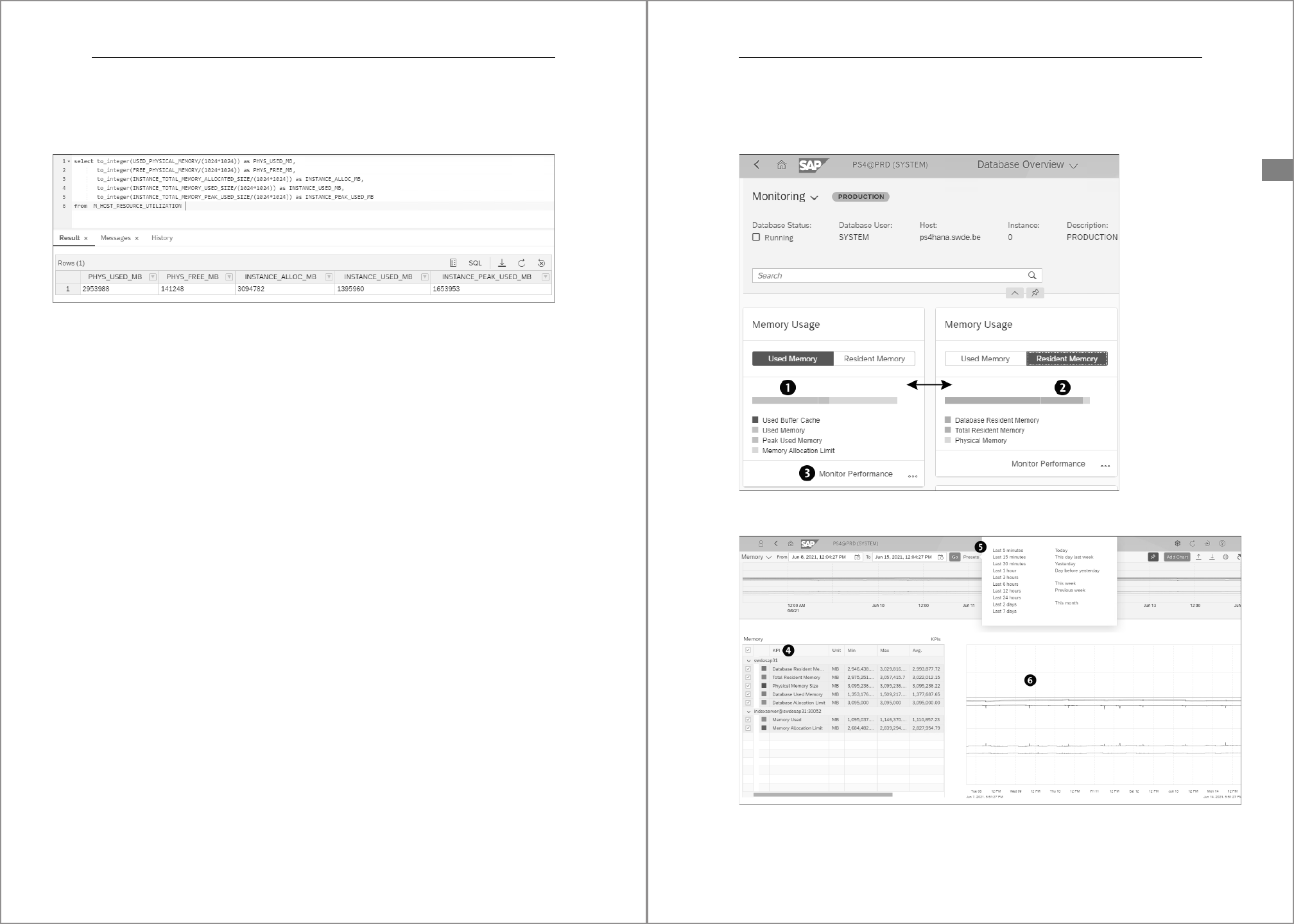
4 Instance Administration
172
amount of physical memory in use, but this is normal because the relatively low usage
rate of memory for SAP HANA means that not all its memory pages need to be present
in main memory.
Figure 4.28 Memory Statistics for Host
Now we need to introduce two more terms (the last ones for now, we promise). First, a
process running on Linux (and from the perspective of Linux, SAP HANA is nothing
more than a bunch of processes) must reserve at the OS the memory that it needs for
code, data, and other purposes (such as the pool, in the case of SAP HANA). The total
size of these reservations is the virtual memory of that process (sometimes also called
the virtual set size [VSS]). Second, not all of this needs to reside in the main memory of
the server all the time. The part of the process’s virtual memory that’s effectively pres-
ent in main memory at a given moment is the resident memory (or resident set size
[RSS]) of that process. In the case shown in Figure 4.28, the virtual memory of the SAP
HANA instance is 3,094 GB, but its resident memory (which the monitoring view
doesn’t show) is smaller. What we do know is that the combined resident memory of all
processes on the server is 2,954 GB.
4.4.7 Monitoring Memory Usage
Now that we’ve introduced the main concepts of memory management in SAP HANA,
let’s look at the functions to obtain memory usage information in the various manage-
ment tools and via SQL statements.
SAP HANA Cockpit
In the SAP HANA cockpit, you’ll find the Memory Management card in the Database
Overview app (Figure 4.29). On the card itself, you can toggle between Used Memory 1
and Resident Memory 2. Both views display a small histogram with the main catego-
ries; hovering the mouse over the histogram shows the corresponding numbers.
Click Monitor Performance 3 to produce the more detailed report shown in Figure 4.30.
The table on the left 4 shows the main memory usage metrics for the server as a whole
and for the index server of the current database (here, the SAP S/4HANA tenant). On
173
4.4 Managing Memory
4
the right 5 is a chart showing the evolution of the memory metrics over a time interval
that you can configure at the top of the window. You can either enter a specific data
range or use the Presets button 6 to choose from a list of predefined intervals.
Figure 4.29 Memory Usage Card in SAP HANA Cockpit
Figure 4.30 Memory Report in SAP HANA Cockpit

4 Instance Administration
174
SAP HANA Studio
SAP HANA Studio shows summary memory statistics in the Overview tab of the
Administration Console (Figure 4.31 1). The first histogram shows key metrics from the
application perspective: the currently used memory, peak used memory (both are
identical in the screenshot), and allocation limit. The second histogram gives a more
server-oriented view, with the resident memory size of the current database, the total
resident memory size, and the physical memory of the server. The instance in this
example has two tenants of roughly equal size, which explains why the database resi-
dent memory is only a little over half the total resident size.
Click the More Information link below one of the histograms to open the Landscape tab
2, which displays the resource usage per service for the current database. The memory
histogram (enlarged, bottom of figure) shows bars with the current memory usage 3
and peak memory usage 4. The thin red line 5 is the effective allocation limit for the
service.
Figure 4.31 Memory Usage Statistics in SAP HANA Studio
DBA Cockpit
In SAP NetWeaver Application Server for ABAP and SAP S/4HANA systems, Transaction
DBACOCKPIT shows summary metrics on the initial screen (see Figure 4.32). Under
Database Memory and CPU, there are two histograms, but they have different mean-
ings than those in SAP HANA Studio: the one at the top shows used and total memory
for the entire multitenant database container (MDC); the bottom one shows this info
only for the SAP tenant.
175
4.4 Managing Memory
4
Figure 4.32 Memory Metrics in DBA Cockpit Overview
Click the title to the left of the histogram to open a detail screen (which is the same in
both cases). This screen (see Figure 4.33) displays the memory statistics per service for
the MDC. The list is so wide that we have split it into two parts. Notice that here you can
see the sizes of the heap memory and shared memory (rightmost two columns of the
lower section).
Figure 4.33 Resources per Service in DBA Cockpit
In contrast to the SAP HANA cockpit and SAP HANA Studio, DBA Cockpit allows you to
drill down to a further level of detail. To do this, click an entry in the Total Memory Used
Size (GB) column. For the selected service, this opens the screen shown in Figure 4.34.
On the left, in tabular form and as a pie chart, you can see the main components that
are using memory for the service. On the right is a detailed list with memory usage per
allocator.

4 Instance Administration
176
Figure 4.34 Memory Details in DBA Cockpit
SQL Statements
In Section 4.4.4, Section 4.4.5, and Section 4.4.6, we showed the monitoring and statis-
tics views for SAP HANA memory. However, querying these views directly isn’t always
simple because in some cases, like, for example, the case of the allocator memory met-
rics in
M_HEAP_MEMORY, the data is organized hierarchically and usage data is consoli-
dated at higher levels. With a simple selection, there would be a risk of counting the
same quantity several times over. To make life easier and to produce more reliable
results, we advise you to use the standard scripts that SAP supplies with SQL statement
collection. In Chapter 15, you’ll learn where to find and how to install and use this col-
lection. The relevant scripts have names starting with
HANA_Memory; SAP Note 1999997
lists the most important of these.
4.5 Sessions and Transactions
All the work that application users do in the database takes place in the context of a
session. To establish a session, the user connects via the database client software to
the SAP HANA server, supplying connection parameters like the name of the tenant
177
4.5 Sessions and Transactions
4
database and valid credentials. After the parameters and credentials have been vali-
dated, the session is created; all the interaction between user and database then takes
place in the context of this session. This interaction takes the form of a series of trans-
actions. A transaction consists of one or more commands. A command is typically a
SQL statement, but other types exist as well; we’ll use command as a generic term for all
requests the user sends to the database. The commands within a single transaction
form a single, nondivisible (atomic) unit, which means that either all of them are exe-
cuted or none of them are. A transaction is started implicitly when the first command
is issued but must be ended explicitly with a commit or rollback.
Figure 4.35 schematically shows the lifetime of a database session. The session starts
when the client connects to the database and a session context is set up. During the ses-
sion, the client executes transactions consisting of commands; the session sends the
command to the database server, which processes it and sends the result set, along
with a return code (success or failure), back to the client. During the transaction, it will
probably be necessary to lock areas of data against concurrent changes. These locks
remain in force until the transaction is explicitly ended with a commit or a rollback. In
case of a rollback, all changes made by the open transaction are undone. This process
repeats until the user ends the session.
Figure 4.35 Sessions and Transactions
Session begins
Session ends
Database ServerDatabase Client
. . .
Commit/Rollback
Transaction 1
Transaction 2
Transaction N
. . .
Command N
Process Result
Command 2
Process Result
Command 1
Process Result
Commit or Rollback
Release Locks
End Transaction
Transaction begins
(implicit)
Transaction ends
(implicit)
Prepare and Execute
Prepare and Execute
Prepare and Execute
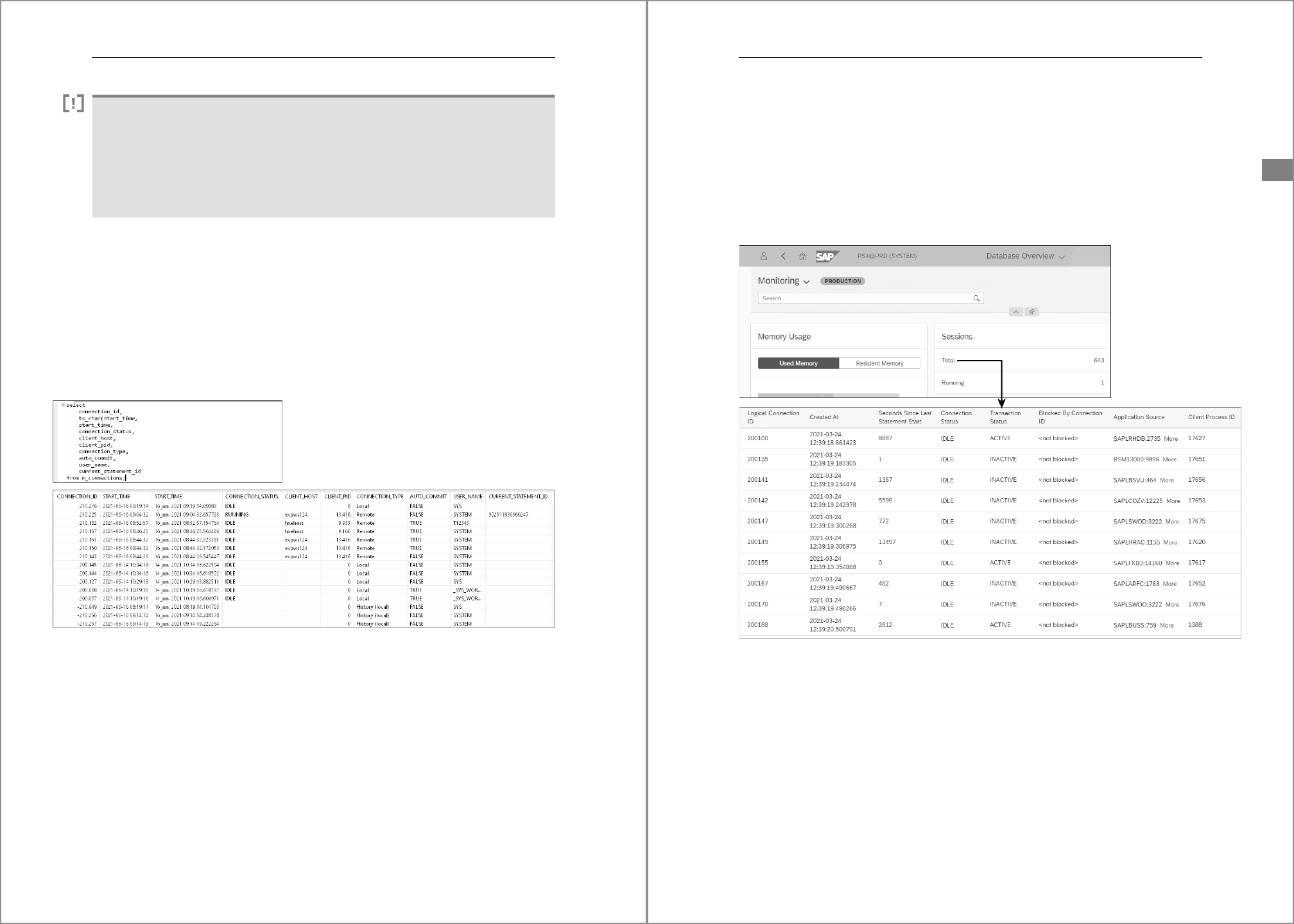
4 Instance Administration
178
Autocommit Mode
A session may also operate in autocommit mode, which means that an implicit com-
mit is executed after each command that makes a change in the database. While fine
for simple tasks, autocommit is not suitable for more complex applications. The SQL
console in the SAP HANA cockpit and SAP HANA Studio and the
hdbsql command line
tool work in autocommit mode by default, but this can be changed.
In Section 4.5.1 and Section 4.5.2, we’ll explain how to monitor sessions and transac-
tions. This is followed by a section about database locks.
4.5.1 Monitoring Sessions
You can find data about sessions in the M_CONNECTIONS and M_CONNECTION_STATISTICS
monitoring views. These views provide a wealth of information and are extremely use-
ful when you want to find out what’s currently happening. Figure 4.36 shows an exam-
ple in which we read some fields of
M_CONNECTIONS.
Figure 4.36 Monitoring View M_CONNECTIONS
Each connection is identified by a numeric CONNECTION_ID code. This ID is positive for
existing connections and negative for connections that no longer exist but whose his-
tory and statistics are kept for a limited period of time. The
connection_history_lifetime
parameter in the [session] section of the indexserver.ini file controls the length of this
period.
The default is 60 minutes. For active sessions (ID > 0), the view also shows the connec-
tion status, which in most cases will be
RUNNING or IDLE. For all sessions, you can see the
database username; for remote sessions (those connected via the database client), the
view also shows the hostname and process ID from where the session was started. For
179
4.5 Sessions and Transactions
4
active sessions, CURRENT_STATEMENT_ID identifies the active SQL statement, the details of
which can be found in the SQL plan cache (covered in Chapter 14).
Instead of using SQL statements, you can also use the standard functionality of the SAP
GUI tools to display session information. In the SAP HANA cockpit, go to the Sessions
card in the Database Overview and click the Total or Running link. Figure 4.37 shows the
first page of the session list for an ABAP system. An interesting extra piece of informa-
tion here is the Application Source column, which shows the location in the ABAP
source code where the SQL statement originates.
Figure 4.37 Session List in SAP HANA Cockpit
In SAP HANA Studio, you find the same information in the Administration Console in
the Performance 폷 Sessions tab, and in DBA Cockpit, it’s in System Information 폷 Connec-
tions.
4.5.2 Monitoring Transactions
The monitoring view for transactions has the hardly surprising name M_TRANSACTIONS.
Figure 4.38 shows the result of a query on this view.
CONNECTION_ID identifies the session
executing the transaction.
TRANSACTION_ID is an identifier for the transaction object;

4 Instance Administration
180
this number remains associated with the session for the entire lifetime for that session
and can be reused afterward. If an open transaction has effectively made changes to the
database that have not yet been committed or rolled back, then you will see a nonzero
value in
UPDATE_TRANSACTION_ID; this number lasts only until the end of the transaction
and is always incremented and never reused. Other columns selected in the example
are for the isolation level (which we discuss in Chapter 12) and the number of locks the
transaction is currently holding.
Figure 4.38 Monitoring View M_TRANSACTIONS
To show the interplay between the different transaction fields, let’s walk through a
small demonstration in
hdbsql. We’ll connect to the database, switch off autocommit,
and determine our connection ID (the system provides a
CURRENT_CONNECTION variable
for this purpose), as shown in Listing 4.11.
hdbsql -i <nr> -d <DB> -u <user> -p <password> -m
\a off
Auto commit mode switched OFF
select current_connection from dummy;
| CURRENT_CONNECTION |
| ------------------- |
| 210736 |
Listing 4.11 Connection ID in hdbsql
A transaction is implicitly active, and our session has been allocated a transaction
object with ID = 17, as shown in Listing 4.12.
select * from icecream;
| ID | FLAVOR | PRICE |
| ----------- | ---------- | ---------- |
181
4.5 Sessions and Transactions
4
| 1 | Vanilla | 4.00 |
| 2 | Strawberry | 4.75 |
| 3 | Chocolate | 4.25 |
select transaction_id, update_transaction_id,
transaction_status as status, acquired_lock_count
from m_transactions where connection_id = 210736;
| TRANSACTION_ID | UPDATE_TRANSACTION_ID | STATUS | ACQUIRED_LOCK_COUNT |
| --------------- | ---------------------- | ------ | -------------------- |
| 17 | 0 | ACTIVE | 0 |
Listing 4.12 Transaction ID in hdbsql
We only queried the database and didn’t make any changes; the state of the transaction
remains unchanged. Now we change a nonexistent row, as shown in Listing 4.13.
update icecream set price = 5.00 where flavor = 'Pistachio';
0 rows affected
select transaction_id, update_transaction_id,
transaction_status as status, acquired_lock_count
from m_transactions where connection_id = 210736;
| TRANSACTION_ID | UPDATE_TRANSACTION_ID | STATUS | ACQUIRED_LOCK_COUNT |
| --------------- | ---------------------- | ------ | -------------------- |
| 17 | 821827 | ACTIVE | 0 |
Listing 4.13 Update Transaction ID Allocated
Because of the update statement, an update transaction ID has been assigned. Because
the statement didn’t actually change any data, the transaction isn’t yet holding any
locks. Now let’s make a real change, as shown in Listing 4.14.
update icecream set price = price + 0.25;
3 rows affected
select transaction_id, update_transaction_id,
transaction_status as status, acquired_lock_count
from m_transactions where connection_id = 210736;
| TRANSACTION_ID | UPDATE_TRANSACTION_ID | STATUS | ACQUIRED_LOCK_COUNT |
| --------------- | ---------------------- | ------ | -------------------- |
| 17 | 821827 | ACTIVE | 3 |
Listing 4.14 Transaction Holding Locks
The transaction now holds a row lock on the three modified rows. The last step is to
commit the changes, as shown in Listing 4.15.

4 Instance Administration
182
commit;
select transaction_id, update_transaction_id,
transaction_status as status, acquired_lock_count
from m_transactions where connection_id = 210736;
| TRANSACTION_ID | UPDATE_TRANSACTION_ID | STATUS | ACQUIRED_LOCK_COUNT |
| --------------- | ---------------------- | ------ | -------------------- |
| 17 | 0 | ACTIVE | 0 |
Listing 4.15 Status after Committing Transaction
The transaction ID remains unchanged, and the update transaction ID is zero again. All
locks have been released.
4.5.3 Monitoring Locks
Locks are a crucial mechanism in every DBMS to manage concurrent access. Locks
ensure that a transaction can never change data that’s already being changed by
another transaction. In this section, we begin by describing the lock types (the type
indicates whether the lock applies to a row or an entire table), the lock modes (a lock
can be exclusive or intentional), and the way these two attributes combine. After that,
we discuss the monitoring views that let you monitor locking activity in the database.
Lock Types and Lock Modes
SAP HANA uses two lock types, distinguished by the scope: table locks and row locks.
With respect to the impact of the lock on concurrent transactions, there are two lock
modes:
쐍 Exclusive (X) locks restrict the right to change the locked row or table to the transac-
tion holding the lock. Other transactions can read the table or row but can’t change
it.
쐍 Intentional exclusive (IX) locks, which only exist for tables, prevent other transac-
tions from setting an exclusive lock on the same table. When a transaction executes
a SQL statement that changes data, it will lock all the rows that it changes, as we saw
in the example in Section 4.5.2. This row-level lock is always exclusive, and other
transactions can’t lock these rows. However, locking purely at the row level isn’t
watertight: another transaction could still set an exclusive lock on the entire table,
causing a conflict. To prevent this, before the first transaction changes any rows, it
sets an IX lock at the table level. This guarantees that no one else can lock the table
exclusively.
Figure 4.39 shows the interaction between the two lock types in a multiconcurrency
situation. Transaction 1 wants to update rows on table
SALESDATA. The first step is to
set an IX lock on the table. The
WHERE clause of the UPDATE statement finds three
matching rows, and an X lock is set on each of these rows. While transaction 1 is active,
183
4.5 Sessions and Transactions
4
transaction 2 executes an UPDATE on the same table. It also sets an IX lock on the table
and then scans for rows that match the
WHERE condition. The two matching rows do not
conflict with those updated by transaction 1, and an X lock is set on these rows. Trans-
action 3 wants to create a new index on table
SALESDATA. DDL statements like CREATE
INDEX
require an exclusive lock on the table. The request to set an X lock on SALESDATA is
rejected because of the active IX locks, and transaction 3 is made to wait. Only when
transactions 1 and 2 are both finished and their locks released will the index creation be
allowed to proceed.
Figure 4.39 Exclusive and Intentional Exclusive Locks
Table 4.6 lists the combinations of lock types and lock modes, the circumstances when
they are used, and the corresponding SQL statements.
Lock Type Lock Mode Use Cases
Table X (exclusive)
쐍 DDL statements
쐍 Truncation
쐍 With explicit table lock statements: ALTER
TABLE, DROP TABLE, CREATE INDEX, DROP INDEX,
TRANCATE TABLE, LOCK TABLE
Table IX (intentional exclusive)
쐍 DML statements that change data
쐍 Delta merges
쐍 With explicit table lock statements: INSERT,
UPDATE, UPSERT, DELETE, SELECT FOR UPDATE,
MERGE DELTA, LOCK TABLE
Row X (exclusive) With DML statements that change data: INSERT,
UPDATE, UPSERT, DELETE, SELECT FOR UPDATE
Table 4.6 Lock Types and Modes
SALESDATA Table
Transaction 1
UPDATE SALESDATA SET …
row 1
row 2
row 3
row 4
row 5
X (row)
X (row)
X (row)
IX (table)
X (row)
X (row)
IX (table)
X (table)
Transaction 2
UPDATE SALESDATA SET …
Transaction 3
CREATE INDEX … ON SALESDATA

4 Instance Administration
184
Table locks can also be set explicitly using the LOCK TABLE SQL statement. This statement
can be used to set both X and IX locks, as in the following examples:
쐍 LOCK TABLE SALESDATA IN EXCLUSIVE MODE
쐍 LOCK TABLE SALESDATA IN INTENTIONAL EXCLUSIVE MODE
쐍 LOCK TABLE SALESDATA IN EXCLUSIVE MODE NOWAIT
쐍 LOCK TABLE SALESDATA IN EXCLUSIVE MODE WAIT 300
The third and fourth statements specify the wait mode: NOWAIT means that the state-
ment will fail immediately if the lock cannot be acquired, and
WAIT specifies how many
seconds to wait for the lock request before timing out.
Lock Waits and Timeouts
If a lock request can’t be granted immediately, then the transaction will wait until the
request either is granted or expires. The default behavior is controlled via the
lock_
wait_timeout parameter in the [transaction] section of the indexserver.ini file.
The default is 1800000, which is equal to 30 minutes. Careful: the unit for this param-
eter is milliseconds, whereas in
LOCK TABLE it’s seconds. Setting the timeout to 0 means
that lock requests will wait indefinitely, meaning, in practice, until the transaction is
canceled.
When a lock request, implicit or explicit, hits the timeout value, the following error is
produced and the open transaction is rolled back:
Error: (dberror) [131]: transaction rolled back by lock wait timeout:
TrexColumnUpdate failed on table '<SCHEMA>'.'<TABLE>' with error: transaction
rolled back by lock wait timeout: Lock-wait time out exceeded
Monitoring Views for Locks
The monitoring views for locks are M_OBJECT_LOCKS and M_RECORD_LOCKS for table and
row locks, respectively. In both views, the owner of the lock can be identified based on
the update transaction ID, from which it’s possible to derive the session.
4.6 Load Management and Distribution
Memory isn’t the only critical resource in an SAP HANA installation. There wouldn’t be
much point in loading huge amounts of data into memory if that data couldn’t then be
processed efficiently. With that goal, your big strapping database server will come not
just with a huge memory but also with an impressive battery of CPUs, and SAP HANA is
designed to profit as much as possible from this CPU capacity, in terms of both speed
and number.
When it comes to optimizing the distribution of the workload, an administrator can
choose to go with the defaults and let SAP HANA figure things out by itself. In an
185
4.6 Load Management and Distribution
4
environment with a relatively homogeneous workload, that can be a viable option
because SAP HANA derives many of its default settings from the actual characteristics
of the server. Often, however, the workload is not homogeneous at all. A good example
is a setup that runs both transactional (OLTP) and analytical (OLAP) loads. On the OLAP
side, there is a further distinction between queries and extract, transform, and load
(ETL) operations, both of which have substantial, and not always compatible, resource
requirements. Another example is an SAP HANA system serving multiple tenants,
where you must prevent one database from monopolizing the resources of the system
at the expense of the others.
In this section, we cover several features and mechanisms to control how the workload is
distributed. With admission control (Section 4.6.1), new requests can be queued or even
rejected when the server is running near its maximum capacity. By configuring proces-
sor affinity (Section 4.6.2), a process can be bound to a processor or group of processors.
It’s possible to control to what degree SQL statements can execute in parallel (Section
4.6.3). You also can define workload classes (Section 4.6.4) and assign specific activities to
these classes. Resource restrictions also can be set for individual users (Section 4.6.5).
Finally, we look at the available metadata for load management in Section 4.6.6.
4.6.1 Admission Control
Admission control is a feature that makes it possible to control how new requests are
handled when the system is at or near peak capacity of either CPU or memory. It uses
two thresholds, soft and hard:
1. When the soft threshold is reached, new requests are queued rather than scheduled
immediately. A request remains in the queue until sufficient capacity is available or
until it times out in the queue, in which case it is rejected.
2. When the instance hits the hard threshold, new requests are rejected. The following
error is returned:
1038: rejected as server is temporarily overloaded
The thresholds are controlled using parameters: one global on/off, two for the CPU, and
two for memory. The global switch is set via the
enable = 'true' | 'false' parameter
found in the
[admission_control] section of the indexserver.ini file.
Don’t Turn Off Admission Control
Turning off admission control can be tempting when users complain about waiting or
rejected commands, but this makes the problem worse and causes even more severe
performance problems.
Soft and hard thresholds for the CPU are handled via the queue_cpu_threshold and re-
ject_cpu_threshold parameters in the [admission_control] section of the indexserver.ini
file.
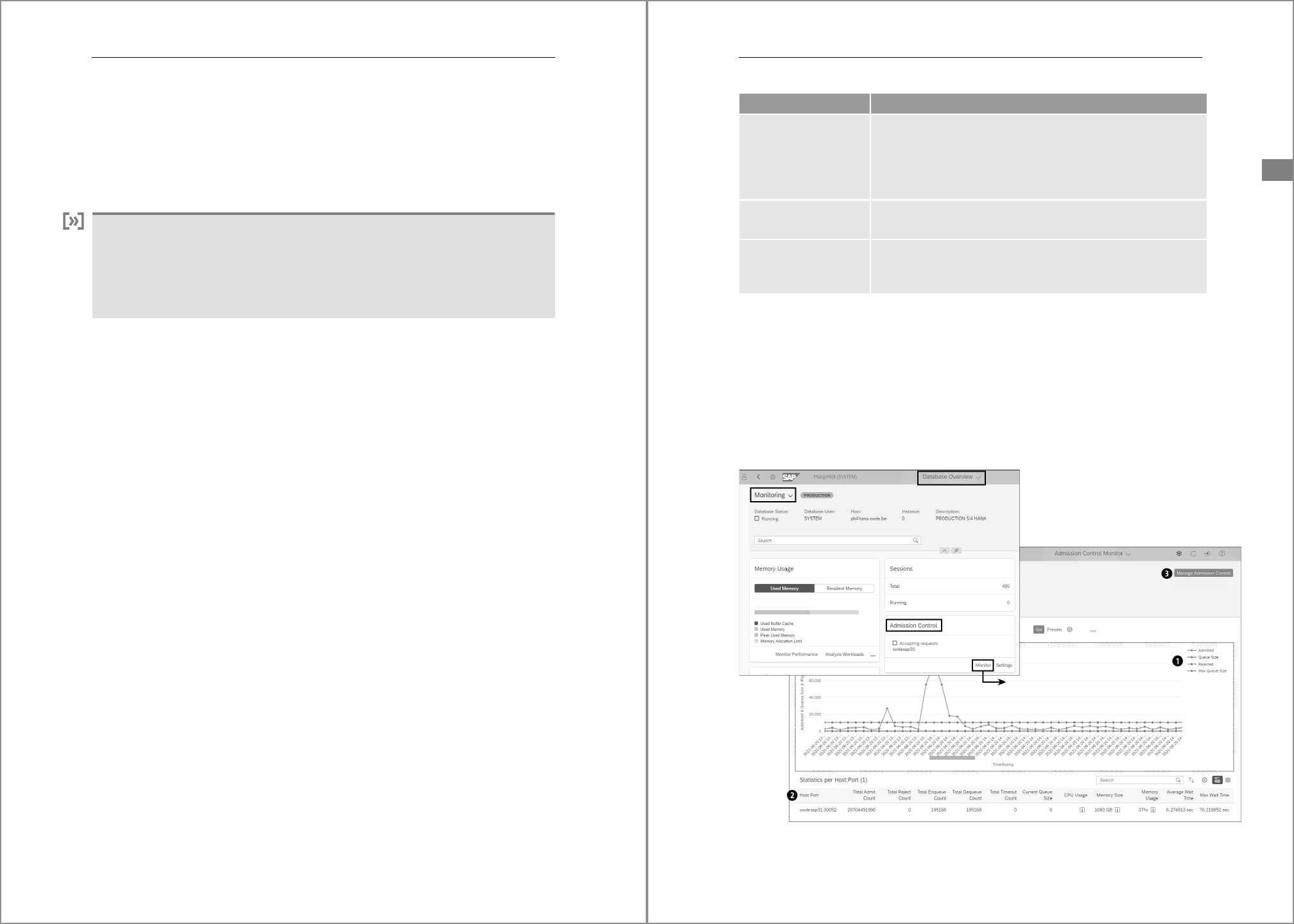
4 Instance Administration
186
Similarly for memory, they are handled via the queue_memory_threshold and reject_
memory_threshold
parameters.
All thresholds are expressed as a percentage. The default for the soft threshold is 90,
which means that queuing will begin when 90% of the resource capacity is used. A
value of 0 or 100 means that no queuing takes place. The default for the hard threshold
is 0; this implies that normally no requests will be rejected.
Soft Threshold for Memory
SAP recommends setting the soft threshold for memory (not CPU!) to 0. This is because
high memory consumption is rarely a cause for concern. As of version 2.00.054, 0 is the
default value, meaning that admission control becomes a function of CPU usage only.
See SAP Notes 2222250 and 2600030.
The instance measures CPU and memory utilization at fixed intervals; the value used is
normally not the latest one but a smoothed moving average. The polling interval and
the degree of smoothing are again controlled with the
statistics_collection_interval
parameter in the [admission_control] section of the indexserver.ini file.
The unit is milliseconds and the default is 1000 (one second). With this frequency, the
performance impact of the check is negligible. It’s possible to set a shorter interval,
down to 100 ms.
In the same section, the smoothing factor can be controlled using these three parameters:
쐍 averaging_factor
쐍 averaging_factor_cpu
쐍 averaging_factor_memory
The first parameter sets the overall smoothing factor; it’s possible to deviate from this
by setting a specific factor for CPU or memory using the second and third parameters,
respectively. The unit is always percent. The lower the percentage, the more smoothing
is applied. An averaging factor of 100 suppresses smoothing, and only the last capacity
measurement is then considered. The overall averaging factor has a default of 70; the
resource-specific factors are 0 by default, which means the global factor is used.
There are numerous parameters for the management of the request queue. They are
documented in the SAP HANA Administration Guide and in SAP Note 2222250. We won’t
describe these parameters here—with two important exceptions. The
queue_timeout_
check_interval parameter defines how long a request can remain on the queue before
being finally rejected. The unit is seconds, and the default is 600 (10 minutes).
Use the following parameter to set the maximum length of the queue:
max_queue_size.
When the queue is full, new requests are rejected. The default queue length is 10,000.
There are three monitoring views that provide useful data about admission control,
which are described in Table 4.7.
187
4.6 Load Management and Distribution
4
Instead of querying the monitoring views, you can also monitor, as well as manage, the
admission control settings in the SAP HANA cockpit (not in SAP HANA Studio). This is
shown in Figure 4.40. In the Database Overview app, in the Monitoring view, locate the
Admission Control card and choose Monitor. The monitor window shows a graph 1 for
the last 60 minutes at 10-second intervals (use the horizontal scroll bar to move
through the displayed data series). Summary data can be found in the table 2 below
the graph. Via Manage Admission Control 3, you can change the settings online.
Figure 4.40 Admission Control Monitor in SAP HANA Cockpit
Monitoring View Description
M_ADMISSION_CONTROL_
EVENTS
Event log for all recent admission control events. An event is only
recorded if the request has been on the queue for five seconds at
least (this time is configurable; see SAP Note 2222250). The maxi-
mum number of logged events is also configurable (see same note). It
used to be one million but has been lowered to 10,000.
M_ADMISSION_CONTROL_
QUEUES
Information about currently queued requests.
M_ADMISSION_CONTROL_
STATISTICS
Admission control statistics. In this view you can, for example, find
the latest CPU and memory measurements, the current queue size,
and the average wait time of requests currently in the queue.
Table 4.7 Monitoring Views for Admission Control
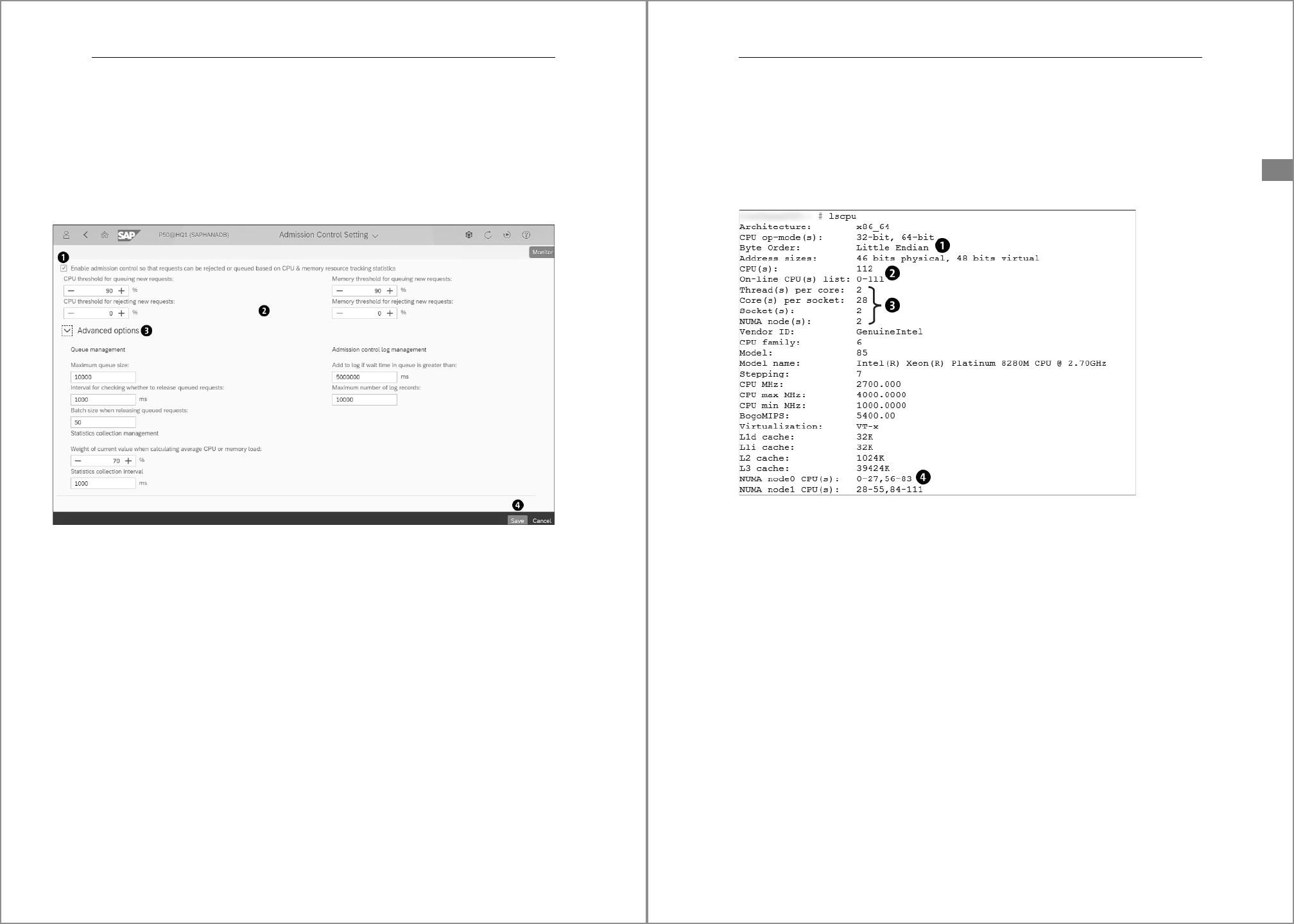
4 Instance Administration
188
Figure 4.41 shows the screen for the admission control settings. The Enable admission
control… checkbox 1 controls the global on/off switch. Initially, only the two CPU and
two memory thresholds are displayed 2. Click Advanced Options 3 to show an addi-
tional set of parameters; here you can change things like the averaging factor and col-
lection interval, as well as various queue parameters (although not the maximum time
a request can spend in the queue before it’s rejected). Choose Save 4 to make the new
settings operational.
Figure 4.41 Admission Control Settings in SAP HANA Cockpit
4.6.2 Processor Affinity
The term processor affinity means binding a process to a specific CPU or group of CPUs.
Normally, all the CPUs of a server form one pool and any process or thread can run on
any CPU. While this is generally good to achieve a balanced use of the processor capac-
ity, there are circumstances when it can be advantageous to take firmer control of the
CPU scheduling process. For example, processors have a local cache memory that pre-
serves data about the processes that previously ran on them. When the same process
runs again on the same CPU, the presence of the data in the cache will speed up execu-
tion. If any process on the server can use that CPU, the probability of an (expensive)
cache miss increases. The advantage of process affinity becomes even more significant
with nonuniform memory access (NUMA) processors; a NUMA processor has a local
memory of its own, which it can access faster than the memory shared among all the
processors. In the next two sections, we first see how to determine the processor topol-
ogy and then we explain how processor affinity can be configured.
189
4.6 Load Management and Distribution
4
Processor Topology
Before considering affinity, it’s necessary to know what number and type of processors
the server has and how they are identified (the processor topology). A good way to find
out is to run the
lscpu Linux command, which displays all relevant information about
the processors. Figure 4.42 shows an example of the output. Here you can see the fol-
lowing elements:
Figure 4.42 CPU Topology with lscpu Command
1 The processor architecture is x86_64 with little-endian bit order (that last fact is log-
ical because SAP HANA 2.0 no longer supports big-endian).
2 There are 112 logical CPUs, numbered from 0 to 111.
3 There are two sockets, each with 28 processor cores. The cores are multithreaded
with two threads per core; the total number of threads must of course match the
number of logical processors (2 x 2 x 28 = 112). There are two NUMA nodes.
4 The NUMA nodes each contain half of the number of logical processors. The first
node includes processors 0–27 and 56–83; the second node consists of processors
28–55 and 84–111.
Configuring Affinity
Processor affinity for a service process is configured by setting a parameter called affin-
ity in the section of that service in the daemon.ini file. Affinity can be set for the follow-
ing services, where the first three run only in the system database and last two in the
tenant databases.
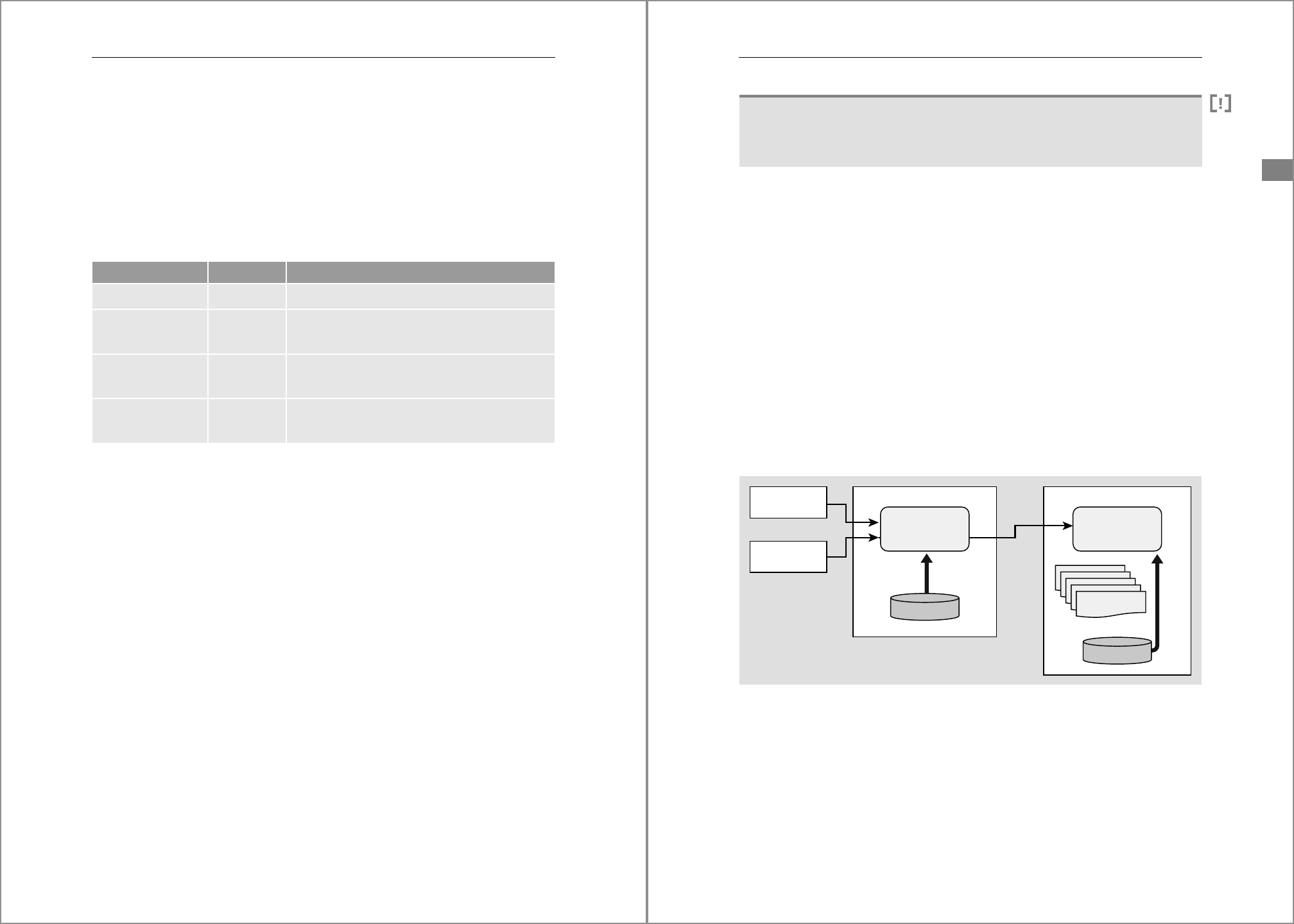
4 Instance Administration
190
쐍 nameserver
쐍 compileserver
쐍 preprocessor
쐍 indexserver
쐍 xsengine
Suppose that the SAP HANA instance on the 112 logical CPU server shown in Figure 4.42
has two tenant databases, PR1 and PR2. PR1 is used somewhat more heavily than PR2,
and we decide to set up affinity based on the distribution shown in Table 4.8.
Listing 4.16 shows the corresponding SQL commands; you must be in the system data-
base to execute them. Notice the use of the
.SID suffix to refer to the service in a spe-
cific tenant.
alter system alter configuration ('daemon.ini','SYSTEM')
SET ('nameserver', 'affinity') = '0,56';
alter system alter configuration ('daemon.ini','SYSTEM')
SET ('compileserver', 'affinity') = '1-3,57-59';
alter system alter configuration ('daemon.ini','SYSTEM')
SET ('preprocessor', 'affinity') = '1-3,57-59';
alter system alter configuration ('daemon.ini','SYSTEM')
SET ('indexserver.PR1', 'affinity') = '28-55,84-111';
alter system alter configuration ('daemon.ini','SYSTEM')
SET ('xsengine.PR1', 'affinity') = '28-55,84-111';
alter system alter configuration ('daemon.ini','SYSTEM')
SET ('indexserver.PR2', 'affinity') = '4-27,60-83';
alter system alter configuration ('daemon.ini','SYSTEM')
SET ('xsengine.PR2', 'affinity') = '4-27,60-83';
Listing 4.16 Setting Processor Affinity
Service No. of CPUs Assigned CPUs
nameserver 2 0 and 56 (NUMA group 1)
compileserver
preprocessor
6 1–3 and 57–59 (NUMA group 1)
indexserver PR1
xsengine PR1
56 28–55 and 84–111 (complete NUMA group 2)
indexserver PR2
xsengine PR2
48 4–27 and 60–83 (remainder of NUMA group 1)
Table 4.8 Example of Processor Affinity and NUMA Groups
191
4.6 Load Management and Distribution
4
Restart Needed to Enable Affinity Settings
The affinity settings are not dynamic; they only take effect when the processes are
restarted.
4.6.3 Parallel Execution of SQL Statements
When an SQL statement is submitted to SAP HANA, that statement can be picked up by
two types of thread:
쐍 An SqlExecutor thread handles incoming requests and executes simple SQL state-
ments, defined as statements with short run times and limited resource usage, com-
mon in OLTP applications. When such a statement is received, it’s picked up by a
single
SqlExecutor thread from a precreated thread pool.
쐍 For complex operations (OLAP but also sometimes OLTP), the request is passed to
the
JobExecutor, which manages a pool of JobWorker threads. Rather than scheduling
one thread, the
JobExecutor will assign the task to multiple JobWorkers.
Figure 4.43 shows this schematically. Both incoming requests are handled by an
SqlEx-
ecutor. If it’s a simple statement, the SqlExecutor thread executes the statement itself.
A complex statement, on the other hand, is passed on to the
JobExecutor, which
launches a series of
JobWorkers that process the statement in parallel.
Figure 4.43 SQLExecutor and JobExecutor
You can influence parallelism by controlling the size of the two thread pools. For
instance, in a system with a heterogeneous workload comprising both OLAP and OLTP,
you might find that the OLAP load tends to dominate the system, starving the OLTP
load of resources. To remedy this imbalance, you could reduce the size of the
JobExec-
utor
thread pool.
JobExecutor
JobWorker
Simple SQL
Complex SQL
Thread Pool
Thread Pool
SqlExecutor

4 Instance Administration
192
As you probably expect, thread pools are managed using parameters. By default none
of these parameters are set (but see the note below referring to SAP Note 3011056),
which means that either pool is allowed to use as many processors as it needs. For the
SqlExecutor, you can set following parameters in the [sql] section of the indexserver.ini
file; the value of both is the number of logical CPUs:
쐍 sql_executors
쐍 max_sql_executors
The first parameter sets a soft limit: the instance precreates this number of SqlExecutor
threads in the thread pool. If demand exceeds the size of the pool, then extra threads
are created and deleted as needed. If the parameter is not set (the default situation),
then the number of threads in the pool is equal to the number of logical CPUs. While
setting a smaller pool will not directly affect parallelism because extra threads can be
created, it does reduce the overhead (e.g., memory use) of the idle threads.
The second parameter is a hard limit: the number of
SqlExecutor threads can’t exceed
this value. Incoming requests for which no thread is available are rejected.
The parameters for the
JobExecutor pool can be set in global.ini or at tenant level in
indexserver.ini in the
[execution] section. There are three of them, and like the SqlExec-
utor
parameters, the value represents a number of logical processors:
쐍 max_concurrency
쐍 max_concurrency_hint
쐍 default_statement_concurrency_limit
The first parameter sets the soft limit for the size of the thread pool. If the JobExecutor
receives additional requests beyond the capacity of the pool, it creates and delete extra
threads as needed. There is no hard limit for the
JobExecutor; this is because its threads
are also used for other operations, such as garbage collection, and forbidding the cre-
ation of extra threads might cause the instance to malfunction.
The second parameter defines the number of
JobWorker threads to handle one paral-
lelized operation. Note that this is the number per operation and not per statement; a
single SQL statement may consist of multiple operations.
The third parameter is the maximum number of parallel threads for a single database
request. If set, it should have a value equal to or greater than the per-operation limit set
with
max_concurrency_hint.
Default Value of default_statement_concurrency_limit
As of version 2.00.056, the default for the default_statement_concurrency_limit
parameter is no longer 0 but 25% of the number of logical processors (if at least 16 logi-
cal CPUs are available). See SAP Note 3011356 for details. This stricter setting prevents
highly parallelized statements from consuming all available CPU resources.
193
4.6 Load Management and Distribution
4
4.6.4 Workload Classes
Workload classes are a means to limit the resources that a related group of activities in
SAP HANA are able to use at any given time. When using workload classes, the first step
is to create classes and set resource limits for them; the second step is to link database
activities to these classes using workload mappings.
Creating Workload Classes
To create a workload class, you use the CREATE WORKLOAD CLASS SQL statement. When you
create a workload class, you must assign properties to it. There are eight properties,
which we list in Table 4.9.
Property Description
STATEMENT THREAD
LIMIT
The maximum number of JobWorker threads that can work on a
statement in parallel. A value of 0 removes any limit on parallelism.
If set, the value must be between 1 and the number of logical CPUs.
If the parameter is not set for the workload class, the value of the
default_statement_concurrency_limit parameter (Section 4.6.3)
is used.
STATEMENT MEMORY
LIMIT
Maximum amount of memory a statement can use; the unit is giga-
bytes.
TOTAL STATEMENT
THREAD LIMIT
Instead of setting a limit per statement, you can also set a global
limit on all statements in the class. This creates an application-level
workload class as opposed to a statement-level class. Using
STATE-
MENT
THREAD LIMIT and TOTAL STATEMENT THREAD LIMIT are mutually
exclusive; you can only set one or the other. If you set this property,
you must also set
PRIORITY and TOTAL STATEMENT MEMORY LIMIT.
TOTAL STATEMENT
MEMORY LIMIT
Memory limit for an application-class group. The same consider-
ations apply as for
TOTAL STATEMENT THREAD LIMIT.
PRIORITY Priority given to the execution of the statement. The priority goes
from 0 (lowest) to 9 (highest). The default is 5. Specifying this prop-
erty is mandatory for an application-class group.
STATEMENT TIMEOUT Statement here specifically means query. This parameter sets the
maximum runtime for a query. If the query hasn’t completed within
the timeout interval, it is aborted. The unit is seconds and the default
is 0 (no timeout).
WRITE TRANSACTION
LIFETIME
Maximum runtime for uncommitted write transactions. After the
specified time, the system will terminate the connection. Unlike the
statement timeout, the unit here is minutes. The default is 0 (no
limit). The system only checks for write transaction exceeding the
lifetime limit every hour; therefore a transaction may run for up to
60 minutes longer than the value set in the parameter.
Table 4.9 Workload Class Properties

4 Instance Administration
194
Let’s go through a few examples. First, we create a workload class simply for requests
with the highest priority:
create workload class HIGH_PRIORITY set 'PRIORITY' = '9';
A statement-level class with limits for parallel threads and memory usage per state-
ment and a query timeout is set in Listing 4.17.
create workload class myclass1
set 'STATEMENT THREAD LIMIT' = '40',
'STATEMENT MEMORY LIMIT' = '16',
'STATEMENT TIMEOUT' = '3600';
Listing 4.17 Create Workload Class
An application-level class with overall limits for parallel threads and memory usage is
set in Listing 4.18.
create workload class appl_cls1
set 'TOTAL STATEMENT THREAD LIMIT' = '64',
'TOTAL STATEMENT MEMORY LIMIT' = '100';
Error: (dberror) [8]: invalid argument: application-level workload class always
has all properties
-- For application-level class we must also specify PRIORITY
create workload class appl_cls1
set 'TOTAL STATEMENT THREAD LIMIT' = '64',
'TOTAL STATEMENT MEMORY LIMIT' = '100',
'PRIORITY' = '5';
Listing 4.18 Application-Level Workload Class
Changing and Dropping Workload Classes
You can use ALTER WORKLOAD CLASS to change properties of the class or to enable/disable
the class. First, let’s add a write transaction timeout of two hours to the statement-level
class:
alter workload class myclass1 set 'WRITE TRANSACTION LIFETIME' = '120';
IDLE CURSOR
LIFETIME
Maximum lifetime for an idle database cursor. This parameter is also
specified in minutes and the default is 0 (no limit). Like write transac-
tions, the actual cursor lifetime may exceed the parameter setting by
up to 60 minutes.
Property Description
Table 4.9 Workload Class Properties (Cont.)
195
4.6 Load Management and Distribution
4
Then, let’s decide to shorten the write transaction lifetime to 60 minutes and to
remove the statement thread and memory limits:
alter workload class myclass1
set 'WRITE TRANSACTION LIFETIME' = '60'
unset 'STATEMENT MEMORY LIMIT','STATEMENT THREAD LIMIT';
By default, a workload class becomes active immediately when it’s created, but you can
also create it in an initially disabled state:
create workload class HIGH_PRIORITY set 'PRIORITY' = '9' DISABLE;
To enable the class later:
alter workload class HIGH_PRIORITY ENABLE;
It’s also possible to enable and disable all classes collectively:
alter workload class all disable;
alter workload class all enable;
Dropping the class is easy, but do read the warning ahead if the class has any workload
mappings:
drop workload class myclass1;
Deleting Workload Classes
When you delete a workload class with DROP WORKLOAD CLASS, all mappings to that class
are silently deleted as well.
Creating Workload Mappings
A workload mapping defines the link between a specific database activity and the work-
load class to which that activity must be assigned. Workload mappings also have their
own SQL statement,
CREATE WORKLOAD MAPPING, with companion statements ALTER WORK-
LOAD MAPPING and DROP WORKLOAD MAPPING. We know of no better way to explain this topic
than to begin straight away with an example. Suppose we have a
SAP_ERP workload class
and we want to map all connections by the SAP ERP system PR1 to this class. An ABAP
system identifies itself to SAP HANA with the application name
SAP:<SID> (we’ll explain
in a moment how you can find out attributes like application names). Do this as follows:
create workload mapping SAP_ERP_WLMAP workload class SAP_ERP
set 'APPLICATION NAME' = 'SAP:PR1';
Here the mapping is based on just one attribute, the application name, but there are
others as well. Listing 4.19 shows the complete list.

4 Instance Administration
196
APPLICATION NAME
APPLICATION COMPONENT NAME
APPLICATION COMPONENT TYPE
APPLICATION USER NAME
CLIENT
USER NAME(see note 1)
USERGROUP NAME (see note 1)
SCHEMA NAME (see note 2)
OBJECT NAME (see note 2)
XS APPLICATION USER NAME
Listing 4.19 Attributes of Workload Mappings
Note the following for the list:
쐍 USER NAME and USERGROUP NAME are mutually exclusive.
쐍 SCHEMA NAME and OBJECT NAME must always be specified together. The object here is a
stored procedure, package, or application function library.
This looks very flexible, enabling you to define the contents of a workload class with
great precision—but how can you find out the values of these attributes for a given ses-
sion? Most of the information can be found in monitoring view
M_SESSION_CONTEXT,
which contains the session variables of every session. Figure 4.44 shows an example for
a session opened by an ABAP work process. The session variable
APPLICATION has the
value
SAP:<SID>; APPLICATIONCOMPONENT contains the name of the ABAP report (here
RSM13000, the program used by update processes). Other attributes that can be used
for the workload mapping are
APPLICATIONUSER (here the SAP User ID), CLIENT, and XS_
APPLICATIONUSER
.
Figure 4.44 Session Context for ABAP Connection
197
4.6 Load Management and Distribution
4
Note that not every application defines the same set of session variables, as we’ll
explain ahead. It’s therefore important always to inspect the record of a session in
M_
SESSION_CONTEXT to determine which attributes to use for a mapping.
CLIENT Attribute
The CLIENT attribute refers to the client number in ABAP systems. It has nothing to do
with the hostname or network address of the database client.
In the following example, we want to create a workload class with the appropriate map-
pings for the management tools (the SAP HANA cockpit, SAP HANA Studio, and
hdbsql).
Statements executed from these three programs must run at the highest priority. We
begin by creating the workload class:
create workload class MGMT_CLASS set 'PRIORITY' = '9';
The next step is to map the three management tools to the new class. To do this, we first
run each tool, open an SQL console, and examine the session context. The results are
shown in Figure 4.45 for the SAP HANA cockpit 1, SAP HANA Studio 2, and
hdbsql 3.
Figure 4.45 Session Context for Management Tools

4 Instance Administration
198
The APPLICATION variable clearly is suitable to identify the program, so we use that as
the attribute for the workload mapping of each tool (see Listing 4.20).
create workload mapping MAP_COCKPIT workload class MGMT_CLASS
set 'APPLICATION NAME' = 'sap_xsac_hrtt';
create workload mapping MAP_STUDIO workload class MGMT_CLASS
set 'APPLICATION NAME' = 'HDBStudio';
create workload mapping MAP_HDBSQL workload class MGMT_CLASS
set 'APPLICATION NAME' = 'hdbsql';
Listing 4.20 Workload Mappings Based on Application Name
To check whether the mapping works and sessions are indeed assigned to the workload
class, we open a new session (the mapping applies only to sessions opened after the
workload mapping was created) and check the
WORKLOAD_CLASS_NAME column in M_CON-
NECTIONS
. We do this in all three programs, and the workload class is as expected (Figure
4.46). For sessions not mapped to a workload class, the column has the value
_SYS_
DEFAULT
.
Figure 4.46 Workload Class Mapping
You’re also allowed to use wildcards in an attribute string (but only at the end of the
string, not at the beginning or in the middle). For example, you could create a workload
199
4.6 Load Management and Distribution
4
mapping for all ABAP systems like this. You must add the option WITH WILDCARD to indi-
cate that a character (default is
%) must be interpreted as a wildcard:
create workload mapping MAP_ABAP workload class SAP_ABAP_CLASS
set 'APPLICATION NAME' = 'SAP:%' WITH WILDCARD;
This matches any application name that begins with SAP:. You can change the wildcard
character, which might be useful if the attribute value already contains
%. In the follow-
ing example, a mapping is created for an application
xyz%agent followed by a suffix (like
xyz%agent1, xyz%agent2, etc.):
create workload mapping MYMAP1 workload_class MYCLASS1
set 'APPLICATION NAME' = 'xyz%agent*' with wildcard '*';
Changing and Dropping Workload Mappings
Use ALTER WORKLOAD MAPPING to change the definition of a mapping. In the following
example, we decided that it would be better to identify use of the SAP HANA cockpit by
a username rather than an application name, as follows:
alter workload mapping MAP_COCKPIT workload class MGMT_CLASS
unset 'APPLICATION NAME' set 'USER NAME' = 'HDBCOCKPIT';
This disables the attribute APPLICATION NAME and replaces it with USER NAME (if we hadn’t
disabled the application name, then both attributes would be used). It may seem sur-
prising that the workload class has to be specified, but this is indeed mandatory,
although redundant (you’re not allowed to create a mapping with the same name in a
different class). Consider this a quirk of the statement.
To drop a workload mapping, use the following statement:
drop workload mapping MAP_COCKPIT;
In contrast to the ALTER statement, there’s no need to also specify the workload class in
the
DROP. (We’re sure there must be a logic to this, but it’s evading us!)
Workload Hints
Even if a session doesn’t belong to a workload class based on its attributes, it can still
request executing a statement in that class by adding a statement hint, as follows:
select * from bigtable WITH HINT(WORKLOAD_CLASS("WLCLASS1") );
By default, however, this is allowed only if it results in more restrictive conditions for
the statement. We’ll explain this with an example. We have two workload classes,
SMALL
and LARGE, distinguished by the maximum statement memory, as follows:
create workload class SMALL set 'STATEMENT MEMORY LIMIT' = '10';
create workload class LARGE set 'STATEMENT MEMORY LIMIT' = '100';

4 Instance Administration
200
We map a user MOUSE to the SMALL class, as follows:
create workload mapping MAP_MOUSE workload class SMALL set 'USER NAME' =
'MOUSE';
We connect to the database as MOUSE and execute a query that consumes more than 10
GB of memory, as follows:
select * from bigtable;
Error: (dberror) [4]: cannot allocate enough memory: OOM. Please check traces
for further information.
MOUSE
is aware that the LARGE class has a higher memory quota, and thinks there’s a neat
way to circumvent the limitation—but tough luck:
select * from bigtable WITH HINT(WORKLOAD_CLASS("LARGE") );
Error: (dberror) [4]: cannot allocate enough memory: OOM. Please check traces
for further information.
Because the workload class specified in the hint has weaker restrictions than the user’s
natural class, SAP HANA ignores the hint and still applies the conditions of the
SMALL
class. The opposite would have been allowed: a session mapped to the LARGE class could
specify
WITH HINT(WORKLOAD_CLASS("SMALL")), for instance, to ensure that a query that is
known to sometimes get out of control is properly reined in.
It’s possible to disable this rule and allow workload hints even if these cause the state-
ment to use less restrictive conditions than it would normally be subject to in its own
class. This is done by setting the
allow_more_resources_by_hint parameter to true in the
[session_workload_management] section of the indexserver.ini file.
MOUSE persuades the database administrator to change the parameter and retries the
statement with the hint to use the
LARGE workload class—and this time it works:
select * from bigtable WITH HINT(WORKLOAD_CLASS("LARGE") );
987654321 rows selected (overall time 1234.5 seconds) -- Success!
Whether this is a good idea is of course something we leave to the discretion of the
administrator.
Invalid Hints Are Ignored
If the hint is against the rules, then it’s silently ignored, and execution of the statement
is still attempted. An incorrect or unacceptable hint by itself doesn’t result in an SQL
error. In our example, we used the statement memory limit because this is a case in
which ignoring the hint results in a visible error (out of memory). Had we used a
property like
PRIORITY, then the statement would simply have run at the priority of
the
SMALL group without giving any feedback to the user that the hint hadn’t been
honored.
201
4.6 Load Management and Distribution
4
4.6.5 Workload Settings for Users
Some of the restrictions set for a workload class can also be set for an individual user.
This applies to the statement memory limit, statement thread limit, and priority. For
an example, see Listing 4.21.
alter user saphanadb
set parameter statement memory limit = '1',
statement thread limit = '4',
priority = '3';
Listing 4.21 Workload Restrictions for User
To remove restrictions, use CLEAR instead of UNSET, as follows:
alter user saphanadb
clear parameter statement memory limit, statement thread limit, priority;
Simple Models Are Best
The interactions between the different levels where workload limits can be configured
(global, workload class, user) can become quite intricate, which may lead to situations
that are hard to comprehend without forensic analysis. We generally recommend
keeping the model as simple as possible—for instance, by only using workload classes.
4.6.6 Metadata
Metadata regarding workload management and workload classes is available in the cat-
alog and monitoring views listed in Table 4.10.
View Contents
WORKLOAD_CLASSES Workload classes.
WORKLOAD_MAPPINGS Workload mappings.
M_CONNECTIONS Column WORKLOAD_CLASS_NAME shows the workload class of the
session. Contains
_SYS_DEFAULT if the session is not assigned to
a workload class.
M_ACTIVE_STATEMENTS
M_EXPENSIVE_STATEMENTS
M_PREPARED_STATEMENTS
Column WORKLOAD_CLASS_NAME shows the workload class
passed as a hint for the statement. If the statement was exe-
cuted without hint from a session assigned to a workload class,
then this column contains
_SYS_DEFAULT and not the class of
the session.
USER_PARAMETERS Lists all user parameters including those related to workload
control (priority, thread limit, and memory limit).
Table 4.10 Metadata for Workload Management

4 Instance Administration
202
4.7 Special Utilities
In this section, we take a brief look at three utilities in the SAP HANA kernel: the data-
base server management console
hdbcons; the program hdbrsutil, which keeps row-
store tables in memory when the instance is stopped; and its near namesake,
hdbn-
sutil, which is used specifically in the context of replication.
4.7.1 hdbcons
The hdbcons program is the SAP HANA database server management console. It’s an
expert tool that lets you do uncommon things (and suitably impress your colleagues,
provided of course that you use it correctly). The tool has its own FAQ in SAP Note
2222218. That note begins by warning you that you should only run it under guidance
of SAP, but then continues to describe it in detail; there are numerous mentions of
hdb-
cons
in other SAP Notes as well. Nevertheless, we recommend heeding SAP’s advice and
only using it when SAP asks you to do so or when you find its usage properly described
in SAP documentation.
There are two ways to run
hdbcons: from the command line and from SAP HANA Studio.
To learn how to run it from the command line, use the
-help argument, as shown in
Listing 4.22.
hdbcons -help
SAP HANA DB Management Client Console (type '\?
' to get help for client commands)
Usage: hdbcons [<options>] [<command> [<repeat_freq_in_seconds>]]
Default connection: hdbindexserver, system HXE, instance 90
Available options:
-h: print the help
-n: prevent autoconnect
-s: set system name to use (default read from environment)
-i: set instance ID to use (default read from environment)
-e: set executable to connect to (default hdbindexserver)
-d <dirname>: open persistency in <dirname> for diagnose
-p <pid>: attach to process with given <pid>
-t <timeoutSec>: connection timeout in seconds
-r remove IPMM shared memory
Listing 4.22 Arguments of hdbcons Program
What this already tells you is that hdbcons connects to a database process, which is
hdbindexserver by default (the index server process). If you want to connect to a differ-
ent service, you can do so by specifying either its name with
-e <program> or its process
ID with
-p <pid>. You can find both in the output of HDB info. For example, if you want
to connect to the name server of the system database and you find that its PID is 1840,
then use either of these commands:
203
4.7 Special Utilities
4
hdbcons -e hdbnameserver
hdbcons -p 1840
This opens an interactive dialog in which you can enter commands; type help for a
complete list or
help <command> for help on a specific command.
You can also pass the
hdbcons command directly in the OS command line, as follows:
hdbcons -p 5413 'transaction c 13'
Obviously, we aren’t going to describe all the commands here (nor are we going to pre-
tend that we know what they’re all doing). Refer to the “What Are the Most Important
hdbcons Functionalities?” section in SAP Note 2222218 for a list of the most common or
useful commands. Whenever it’s relevant to mention
hdbcons (as we did in the sections
about canceling or disconnecting sessions or aborting transactions earlier in this chap-
ter, for instance), we will of course do so.
SAP HANA Studio has a dedicated tab for
hdbcons, but it isn’t enabled by default. To acti-
vate it, proceed as follows (see Figure 4.47):
1 Choose Window 폷 Preferences.
2 In the Preferences window, open SAP HANA 폷 Global Settings and enable the Show
Management Console for hdbcons option.
3 The Administration Console now shows a new Console tab where you can type the
hdbcons commands.
Figure 4.47 Enable hdbcons Console in SAP HANA Studio

4 Instance Administration
204
4.7.2 hdbrsutil
Looking at the output of HDB info, you may spot a process called hdbrsutil. That process
is there regardless of whether SAP HANA is running (Figure 4.48 1) or stopped 2.
Figure 4.48 hdbrsutil Process
The role of this process is to keep the row store in memory even when SAP HANA is
down. Because the row store is always loaded in its entirety at startup (we discuss the
row and column store extensively in Chapter 12), having it already in memory will
reduce start times. There are parameters that control this process, but the functionality
is enabled by default and should remain so. There are more details in SAP Note 2159435.
Sometimes it’s necessary to manually shut down hdbrsutil, such as when you have to
unmount the file systems that contain the SAP HANA persistent data. In that case, use
the following command:
(as user <hsid>adm)
hdbrsutil --stop --port <port>
Here, <port> is the port number used by the active process (30101 in the example
shown in Figure 4.48).
4.7.3 hdbnsutil
There’s only a one letter difference from hdbrsutil, but hdbnsutil is a completely differ-
ent program. It’s used in the context of system replication, providing functionality
such as registering, enabling, and disabling replication or initiating a takeover between
replication nodes. Run the command without parameters to display a complete list of
205
4.8 Managing Redo Logs
4
all parameters. A commonly used command is the one that checks the current replica-
tion status of the system:
hdbnsutil -sr_state
System replication is covered in Chapter 6.
4.8 Managing Redo Logs
Redo logs are database objects, and in that sense, they really belong in the next chapter
on database management. However, monitoring the logs is one of the routine tasks of
the SAP HANA administrator, and for that reason we decided to encroach a little on
database territory and make this subject part of the chapter on instance management.
Together with the data, the redo logs form the persistence layer (disk files) of SAP
HANA. Whenever a transaction that has changed data in the database commits, a
record of those changes is written to the redo logs. These writes happen asynchro-
nously (the session that has committed the transaction doesn’t have to wait for confir-
mation that the log has been written), but they happen more frequently than data
writes from memory to disk (which are grouped into periodic savepoints, something
we describe in more detail in Chapter 12). Redo logs serve two important purposes:
쐍 If the database or instance terminates abnormally, it’s likely that not all data
changes have been written to disk. In that case, the redo log will be used at startup to
recover the changes made by committed transactions.
쐍 With system replication, the logs are used to keep the standby copies of the primary
system synchronized.
Terminology
Depending on the database system, the terms transaction log and redo log are com-
monly used to designate the logging system. In the context of SAP HANA, both terms
appear, but there seems to be a preference for redo log. We will therefore use this term
throughout the book.
In Section 4.1.5, we showed where the log volumes are located on disk and told you in
no uncertain terms that you should leave those files well alone. That doesn’t mean that
redo logs must not be managed at all, only that you should do so using only the appro-
priate instruments. In this section, we examine SAP HANA logging and redo logs in
detail. In Section 4.8.1, we introduce log segments, which are really storage units for
redo log data. We then discuss in Section 4.8.2 the very important concept of log
modes; the log mode determines whether in case of trouble a database can be restored
up to the latest committed change or only up to the time of the most recent data
backup. In exceptional circumstances, it’s possible to completely disable logging,

4 Instance Administration
206
something we explain in Section 4.8.3. Section 4.8.4 shows how to deal with the situa-
tion where the redo log becomes full, which you might hope will not happen to you
(spoiler: one day it will). The problem isn’t hard to solve, but mistakes can be fatal. In
Section 4.8.5, we see how you can monitor redo logging in the various administration
tools.
4.8.1 Log Segments
Redo log data is written to files on disk called log segments. We already saw in Section
4.1.5 that these are numbered sequentially; when a log segment reaches its configured
size limit, the system automatically creates the next one in the series.
The size of a log segment is configured with the
log_segment_size_mb parameter in the
[persistence] section of the service INI file.
Here, the service INI file is either global.ini or the INI file of the service that performs
redo logging (which several services do, not just the ones that serve user transactions).
The default values are as follows:
쐍 global.ini: 1,024 MB
쐍 nameserver.ini: 64 MB
쐍 dpserver.ini, scriptserver.ini, xsengine.ini: 8 MB
Notice that the parameter isn’t defined for the index server—that is, for transactions in
the tenant databases. The index server uses the size set in global.ini.
4.8.2 Log Modes
A crucial aspect of the configuration of a database is its log mode. There are two different
log modes, overwrite and normal. The all-important parameter that sets the log mode is
the
log_mode global parameter found in the [persistence] section of the global.ini file.
Possible values are
'normal' and 'overwrite'. The default is 'normal'. A newly installed
system initially runs in log overwrite mode, but this changes automatically to normal
mode after the first backup.
In overwrite mode, data in log segments is overwritten as soon as the periodic save-
point (described in Chapter 12) has written all changed data in memory to the data vol-
ume. In overwrite mode, the log segments can’t be backed up. In case of a crash, it’s still
possible to bring the database to a consistent state, but it will be the state at the time of
the most recent data backup. It isn’t possible to do a forward recovery to a more recent
point in time because the redo logs needed for this no longer exist, which inevitably
implies that some data is lost.
Log overwrite mode should only be used for databases in which the possible loss of
recent data doesn’t present a problem, which is typically true for test and sandbox
207
4.8 Managing Redo Logs
4
systems (perhaps less so for development systems). According to SAP, running a pro-
duction system in log overwrite mode is not recommended—but we would go further
and say that a production system should never run in this mode.
In normal log mode, log segments are only overwritten when they have been backed
up and no longer need to be kept online to use for instance recovery. When a log seg-
ment fills up, the system closes that segment and switches to another one that is free
(or creates a new one if none is currently free). If log backups are enabled (which in nor-
mal log mode they should be), the segment is backed up and removed from the log
directory. Normal log mode permits recovering the database to any point in time after
a data backup, because an uninterrupted sequence of redo log records is available to
reconstruct the data exactly as it was at that point in time.
If there is an exceptionally high number of changes and segments cannot be freed up
in a timely fashion, then segments will accumulate in the file system that contains the
log directories. The same can occur if there is some problem, such as log backups fail-
ing. In the worst case, this can lead to the file system becoming full, preventing further
logging. When that happens, the database no longer accepts requests and all activity
freezes. Later in this section, we’ll explain what to do if such a situation arises.
Backup Required after Switch to Normal Log Mode
If you’ve manually switched the system to overwrite log mode and now want to switch
back to normal, then it’s mandatory to immediately make a full data backup; other-
wise, it won’t be possible to recover to the most recent point in time.
4.8.3 Running with Logging Disabled
It’s possible to completely disable logging with the following SQL statement:
alter system LOGGING OFF;
With logging switched off, no redo log writes occur at all and only savepoints write
changes to disk. This means that if the system fails between savepoints, data from com-
mitted transactions will almost certainly be lost, forcing you to restore the latest data
backup. Running with logging off should only be done in very rare circumstances; a
typical case is a very large data upload done without concurrent activity in the system.
In such a context, logging would not be useful because if the load fails, the most likely
course of action is to truncate the data (or restore a backup) and to start over. In normal
multiuser operation, though, you should never run the system without logging.
The statement may take some time because it will wait for all active write transactions
to commit or roll back (on the other hand, if there are any active transactions, then dis-
abling logging is probably not a good idea).

4 Instance Administration
208
To reenable logging use, use this statement:
alter system LOGGING ON;
After this you must immediately trigger a savepoint and start a data backup to ensure
that the database is again recoverable.
4.8.4 Handling a Full Log Situation
With a properly sized file system for the redo logs and a correctly configured log
backup, full log situations shouldn’t occur—but bad things do happen sometimes, so
it’s best to be prepared. For this section, we artificially created a full log state in one of
our test systems, and we start by explaining how we did this. Now, why would we tell
you how to create a problem rather than how to solve it? The reason is that if you have
a test environment available where you can play around with things (and occasionally
break them), then we recommend that you use that test system to practice handling a
full log situation. The procedure isn’t difficult, but you’ll feel much more comfortable
applying it in a critical system if you have prior experience.
There are many ways to create a full log, but this is what we did:
1. Make sure the database is in normal log mode, not overwrite.
2. Disable automatic log backups, as follows:
alter system alter configuration ('global.ini','SYSTEM') set ('persistence','
enable_auto_log_backup') = 'false' with reconfigure;
3. Determine the free space in the file system of the log volumes, as follows:
df -m <log_directory>
4. Create a large dummy file that almost fills the file system, leaving less space than the
size of a new log segment (see Section 4.8.1). Linux has a very nice command for this,
as follows:
fallocate -l <file_size> <file_name>(example: "fallocate -l 6500M BIGFILE")
5. Create database activity. You can do this, for instance, by creating a dummy table
and then repeatedly filling it with a large number of rows and deleting those rows
again. Listing 4.23 shows an easy way to do this.
create table TESTTABLE (COL varchar(70));
insert into TESTTABLE select top 1000000 sysuuid||sysuuid
from objects cross join objects;
delete from TESTTABLE;
Listing 4.23 Causing Massive Database Changes
209
4.8 Managing Redo Logs
4
6. Repeat these INSERT and DELETE statements continuously until the log fills up, at
which point the statement will stop responding. To check how close you are to run-
ning out of log space, you can use the query on
M_LOG_SEGMENTS described in Section
4.8.5.
When the log becomes full and SAP HANA is no longer able to write redo log data to an
available segment, the visible symptom is that activities will freeze: statements that
change data hang and it’s impossible to open a new connection to the database. When
users experience such behavior, your first reaction should be to suspect that redo log-
ging is stuck and to follow the procedure described in the next points.
Figure 4.49 shows the environment for the example. The /hana/log/HDB file system is
100% full; at least 2 GB of space is needed in another file system, and in this case that
space is available in the /hana/data/HDB file system (other file systems would do as
well).
Figure 4.49 Environment for Full Log Example
The procedure frees up space in the full file system by moving a log volume to a tempo-
rary location and then backing up the logs and reclaiming log space. When this is done,
the log volume is moved back to its standard location, as follows:
1. Verify free space in the file system of the log volumes:
df -m /hana/log/HDB
There are other circumstances that can make the database freeze up, but a log full
situation is by far the most probable.
/hana/log/HDB/mnt00001
hdb00001
hdb00002.00003
FULL
/hana/data/HDB
Free
Space

4 Instance Administration
210
2. There should also be "log full" messages in the trace files of the tenant database:
cdtrace
cd DB_<tenant>
grep "DiskFull" *.trc
3. Log into the database server as <hsid>adm and stop the system. Use the sapcontrol
command directly, not HDB stop:
-- Caution: "HDB" is a literal string, not the system name
sapcontrol -nr $TINSTANCE -function StopSystem HDB
4. Locate a file system that has at least 2 GB free space and create a temporary direc-
tory there. In our example, we have enough space in the data file system:
mkdir /hana/data/HDB/log_temp
5. Move at least 2 GB from the log file system to this temporary directory; this is nec-
essary to have enough free space for the database to start. To find the space occu-
pied by each log volume, use this command:
du -m /hana/log/HDB/mnt00001/*
6. Here we move the log volume hdb00002.00003:
mv /hana/log/HDB/mnt00001/hdb00002.00003 /hana/data/HDB/log_temp
7. Create a symbolic link so that the system is still able to locate the log segments in
the volume just moved:
ln -s /hana/data/HDB/log_temp/hdb00002.00003 /hana/log/HDB/mnt00001/
hdb00002.00003
8. Do another df -m /hana/log/HDB execution to ensure there is now enough free space.
9. Start the system:
-- Caution: "HDB" is a literal string, not the system name
sapcontrol -nr $TINSTANCE -function StartSystem HDB
10. Check that automatic log backups are enabled (set 'enable_auto_log_backup' =
'true'
; see Section 4.8.2 for the parameter location).
11. Wait for the log backups to complete:
cdtrace
cd DB_<tenant>
tail backup.log
12. Clean up the log volumes:
hdbsql -I $TINSTANCE -d <tenant> -u SYSTEM -p <passwd>
ALTER SYSTEM RECLAIM LOG
211
4.8 Managing Redo Logs
4
13. It’s now time to return to the normal directory structure. The system must again be
stopped for this:
-- Caution: "HDB" is a literal string, not the system name
sapcontrol -nr $TINSTANCE -function StopSystem HDB
14. Move the temporary log volume directory back to its normal location. The sym-
bolic link must first be removed:
cd /hana/log/HDB/mnt00001
rm -f hdb00002.00003
mv /hana/data/HDB/log_temp/hdb00002.00003 .
15. Remove the temporary directory:
rm -rf /hana/data/HDB/log_temp
16. Restart the system:
-- Caution: "HDB" is a literal string, not the system name
sapcontrol -nr $TINSTANCE -function StartSystem HDB
Do Not Delete Log Segments
Please don’t think we’re hectoring you, but this bears repeating: do not delete log seg-
ments!
4.8.5 Information about Log Segments
In this section, we first look at the M_LOG_SEGMENTS monitoring view, which provides
important data about the redo logging process, and then we describe how to monitor
log segments in the SAP HANA cockpit and in SAP HANA Studio and in Transaction
DBACOCKPIT.
M_LOG_SEGMENTS Monitoring View
The M_LOG_SEGMENTS monitoring view is the most important source of information
about the state of the redo log. This view contains one record per log segment for all
services in the current database that use redo logging. A useful query is the one shown
in Listing 4.24; we join
M_LOG_SEGMENTS with M_SERVICES in order to display not only the
port but also the associated service name.
SELECT
L.PORT, S.SERVICE_NAME, L.FILE_NAME, L.STATE,
to_int(L.TOTAL_SIZE/(1024*1024 )) AS "Total Size (MB)",
to_decimal(L.USED_SIZE / ( 1024 * 1024 ), 6, 1) AS "Used Size (MB)"
FROM
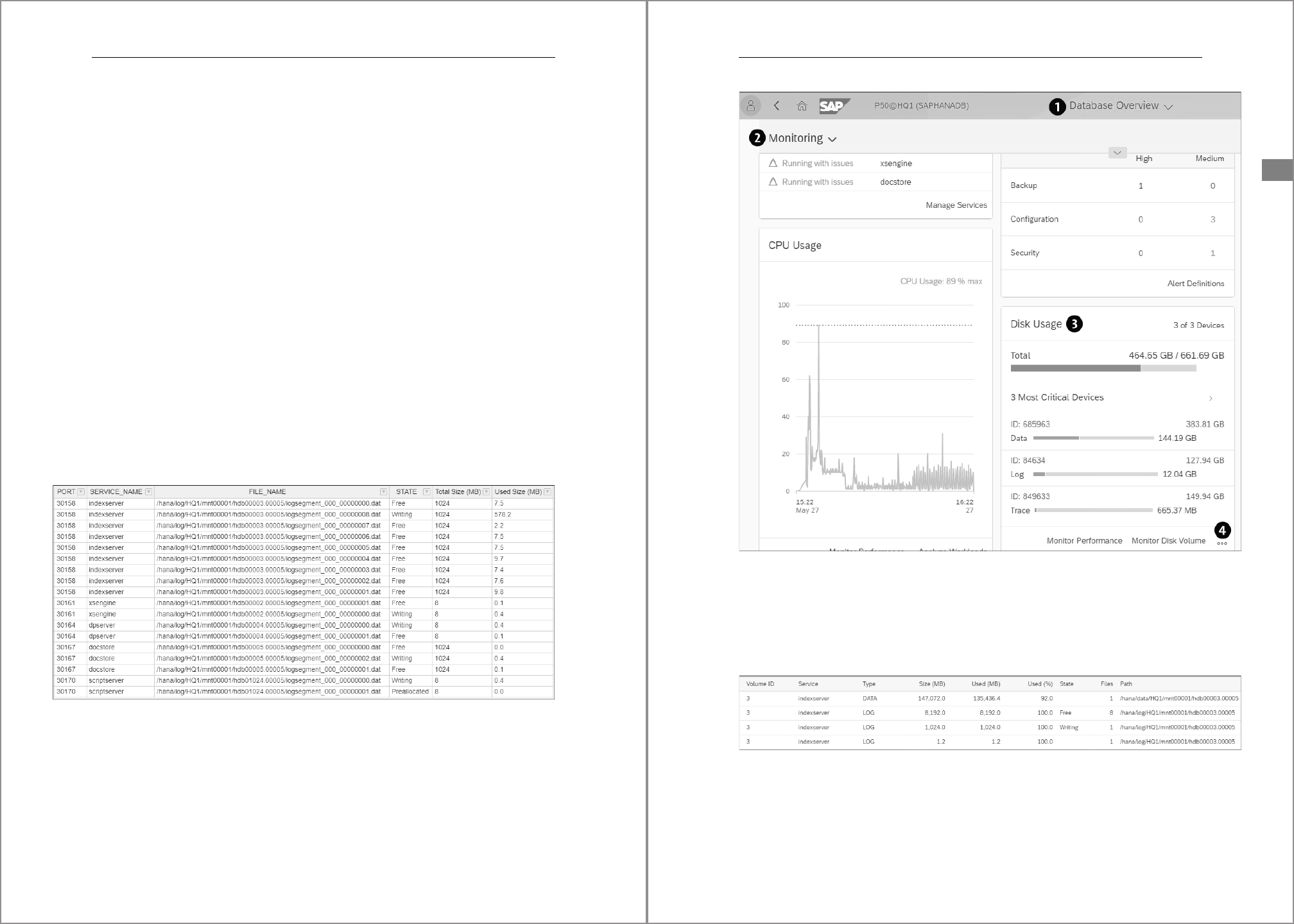
4 Instance Administration
212
m_log_segments AS L
INNER JOIN m_services AS S ON s.host = l.host AND s.port = l.port
ORDER BY L.port ASC;
Listing 4.24 Querying M_LOG_SEGMENTS
Figure 4.50 shows the output of the statement. We describe the segment states in the
STATE column later at the end of Section 4.8.5. The TOTAL_SIZE and USED_SIZE columns
give the total size of the segment and the space currently used inside it. As mentioned
earlier, the
indexserver service, which is by far the most important in terms of data vol-
ume handled, takes its segment size from the
global.ini setting, which is 1,024 MB by
default. The other services (except for
docstore, which also uses the global value) allo-
cate segments of a size set in their own parameter files.
You can also see in the output that the effectively used space is in almost all cases far
smaller than the physical size of the segments. For instance, the
indexserver log seg-
ment currently in use is segment 8, but the previous segments 1–7 hardly contain any
data. This is because the system will switch to a new segment not only when the current
segment is full but also at regular time intervals. The interval is set with the
log_backup_
timeout_s parameter in the [persistence] section of the global.ini file.
The default is 900 seconds (15 minutes). This is an important fact to keep in mind
because it implies that even in databases with very little activity, log segments of pos-
sibly large sizes are created continuously.
Figure 4.50 Redo Log Information in M_LOG_SEGMENTS
Monitoring Log Segments in SAP HANA Cockpit
In the SAP HANA cockpit, open the Database Overview (Figure 4.51 1); select the Moni-
toring view 2. In the Disk Usage section 3, choose Monitor Disk Volume 4.
213
4.8 Managing Redo Logs
4
Figure 4.51 Monitor Disk Volume in SAP HANA Cockpit
The upper part of the next window (not shown) is a graph of the total data and log space
usage. The part we are interested in is the report at the bottom of the screen, shown in
Figure 4.52. Initially, the report lists all services, but in Figure 4.52 we have filtered on
the
indexserver service only.
Figure 4.52 Data and Log Report in SAP HANA Cockpit
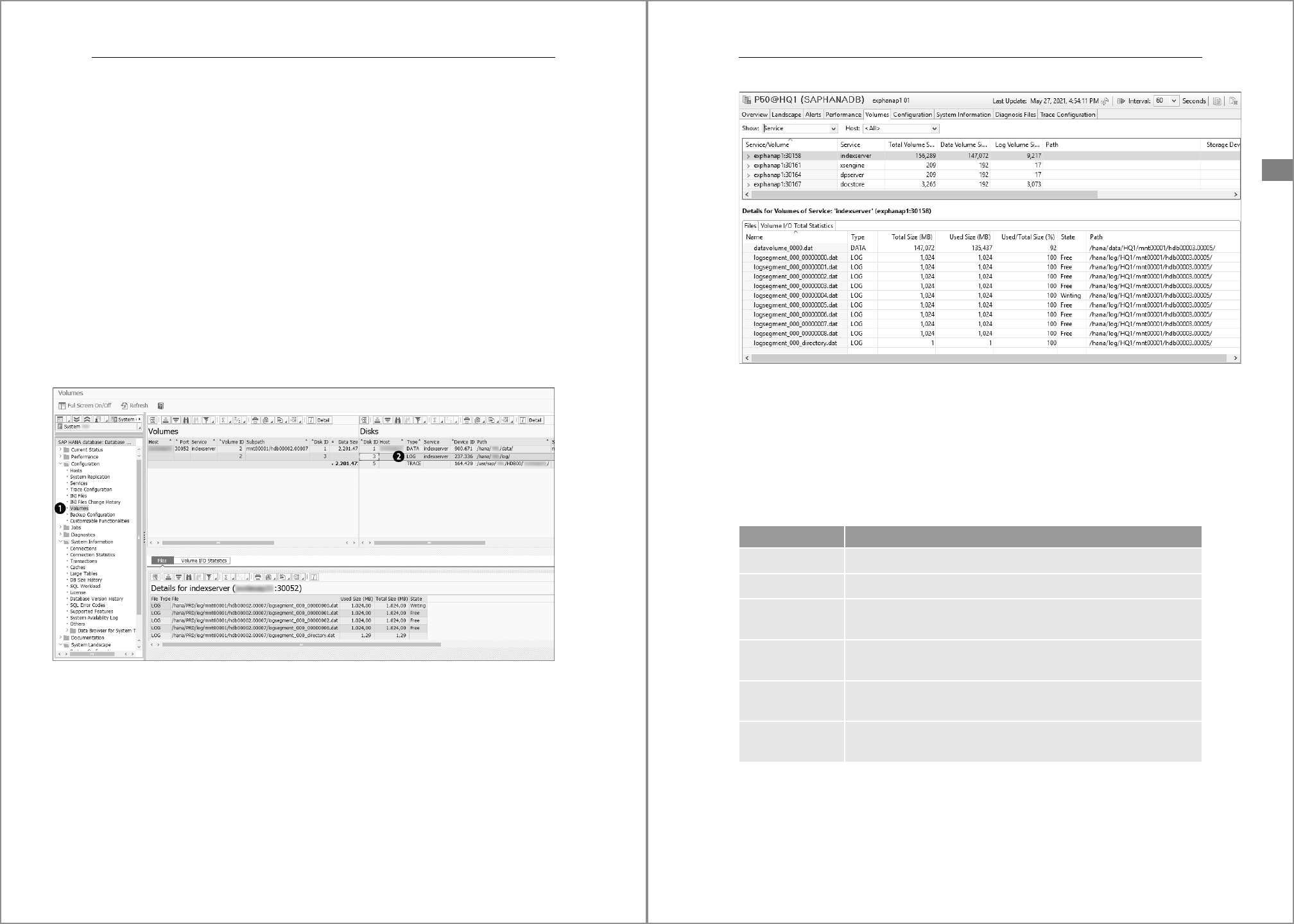
4 Instance Administration
214
The list shows one line for the data and one line for all log segments in a given state (the
last line, with the State column empty, is for the logsegment_000_directory.dat file).
This is a useful summary, although you have to be careful with the Used(%) column,
which always shows 100% here, whereas we clearly saw in Figure 4.50 (a screenshot
from the same database and made at the same time) that the log segments were any-
thing but full. The reason is that this used space metric comes not from
M_LOG_SEGMENTS
but from another monitoring view, M_DISKS, which provides disk space data. In M_DISKS,
the physical size and used space only differ for data volumes; for log segments they’re
identical, resulting in a 100% usage rate.
Monitoring Log Segments in Transaction DBACOCKPIT
In DBA Cockpit, choose Volumes in the left-hand pane (Figure 4.53 1). Under Disks, dou-
ble-click the LOG entry 2. The log segments are then listed at the bottom of the screen.
In contrast with the cockpit, the information is shown per log segment instead of being
summarized. The column for the used size shows 100% here as well, but you know the
cause of that now.
Figure 4.53 Data and Log Report in Transaction DBACOCKPIT
Monitoring Log Segments in SAP HANA Studio
In SAP HANA Studio, you can find information about the log segments under the Vol-
umes tab of the Administration Console (Figure 4.54). Click a service in the upper part
of the window to list the log segments that belong to it.
215
4.8 Managing Redo Logs
4
Figure 4.54 Data and Log Report in SAP HANA Studio
As in DBA Cockpit, the list is per log segment and not summarized, with the Used/Total
Size (%) metric again at 100% for all log segments.
Log Segment States
We still need to look at the different states of a log segment, as shown in the STATE col-
umn of
M_LOG_SEGMENTS. The possible states are shown in Table 4.11.
Log Segment State Description
Formatting The segment is being formatted and not yet ready for use.
Preallocated The segment has been allocated but has not yet been used.
Writing The log segment is being written. This state identifies the currently
active log segment of the service.
Closed The log segment is no longer in active use. It has not yet been backed up
and is still required in case of a restart.
Truncated The log segment is no longer in active use. It has not yet been backed up
and is no longer required for restart.
BackedUp The log segment has been backed up but cannot be removed yet
because it is still needed in case of a restart.
Table 4.11 Log Segment States

4 Instance Administration
216
4.9 Summary
In this chapter, we made a detailed profile of the SAP HANA instance: how it’s orga-
nized, which processes it runs, and where it stores its critical files. You’ve learned how
to start and stop the instance and how to maintain its parameters. We presented the
memory management model and explained how you can manage and monitor the
way SAP HANA uses its ample memory. We took a closer look at sessions, transactions,
and locks, described several features that enable you to manage the workload in the
SAP HANA system, and talked about some special utility programs. Finally, we intro-
duced transaction logging and log modes. That last subject brought us to the gates of
the database realm, and that is where the next chapter will take you.
RetainedFree This state only appears in replicated systems. This means that the seg-
ment has been backed up and is no longer needed for a restart, but it is
required for the synchronization of the replication sites.
Free The log segment has been backed up and is no longer required for
restart. Its present contents can be overwritten.
Log Segment State Description
Table 4.11 Log Segment States (Cont.)

7
Contents
Preface ....................................................................................................................................................... 23
1 SAP HANA Overview 33
1.1 The Column Store .................................................................................................................. 33
1.2 Hardware Requirements .................................................................................................... 36
1.3 Editions ...................................................................................................................................... 37
1.3.1 SAP HANA, Platform Edition ............................................................................... 37
1.3.2 SAP HANA, Express Edition ................................................................................. 39
1.3.3 SAP HANA, Developer Edition ............................................................................ 39
1.3.4 SAP HANA Cloud ..................................................................................................... 39
1.4 Use Cases ................................................................................................................................... 40
1.4.1 SAP HANA as the Primary Database for the ABAP Platform and
SAP NetWeaver ....................................................................................................... 41
1.4.2 SAP HANA as a Data Mart .................................................................................... 42
1.4.3 SAP liveCache on SAP HANA ............................................................................... 43
1.4.4 SAP HANA Accelerators ........................................................................................ 43
1.4.5 SAP HANA as a Development Platform ........................................................... 44
1.5 Data Provisioning .................................................................................................................. 46
1.5.1 SAP Landscape Transformation Replication Server .................................... 46
1.5.2 Mobilink ..................................................................................................................... 48
1.5.3 Direct Extractor Connection ............................................................................... 49
1.5.4 SAP Data Services for ETL-Based Replication ................................................ 49
1.5.5 SAP Replication Server for Log-Based Replication ....................................... 50
1.6 Advanced Analytics .............................................................................................................. 50
1.6.1 Machine Learning and SAP HANA, Predictive Option ................................ 51
1.6.2 SAP HANA, Spatial and Graph Option ............................................................. 51
1.6.3 Text Analytics and Search .................................................................................... 52
1.6.4 SAP HANA, Streaming Analytics Option ......................................................... 53
1.7 Data Integration .................................................................................................................... 54
1.7.1 SAP HANA Smart Data Access ............................................................................ 54
1.7.2 SAP HANA Smart Data Integration and SAP HANA Smart Data
Quality ........................................................................................................................ 55
1.8 Summary ................................................................................................................................... 55

Contents
8
2 Architecture of the SAP HANA System 57
2.1 The Basics .................................................................................................................................. 57
2.1.1 System Database .................................................................................................... 58
2.1.2 Tenant Databases .................................................................................................. 59
2.1.3 SAP HANA License Keys ........................................................................................ 61
2.1.4 Cross-Database Access ......................................................................................... 62
2.1.5 Database Isolation ................................................................................................. 62
2.2 Services and Processes ........................................................................................................ 63
2.3 SAP HANA XSA Runtime Platform ................................................................................. 67
2.4 Data Persistency ..................................................................................................................... 70
2.5 Multihost or Distributed SAP HANA Systems ........................................................... 71
2.5.1 Data and Table Partitioning ................................................................................ 73
2.5.2 Single-Level Partitioning ...................................................................................... 75
2.5.3 Multilevel Partitioning .......................................................................................... 75
2.5.4 Heterogeneous Partitioning ............................................................................... 76
2.6 High Availability .................................................................................................................... 76
2.7 Backup and Recovery ........................................................................................................... 78
2.8 Summary ................................................................................................................................... 80
3 Administration Tools 81
3.1 SAP HANA Cockpit ................................................................................................................. 81
3.1.1 Navigation ................................................................................................................ 81
3.1.2 Setup and Configuration ..................................................................................... 85
3.1.3 Monitoring and Administration ........................................................................ 91
3.1.4 Starting and Stopping Instances and Databases ......................................... 94
3.1.5 Configuring the System ....................................................................................... 96
3.1.6 Monitoring Performance ..................................................................................... 99
3.1.7 Installing the SAP HANA License ....................................................................... 101
3.1.8 Executing SQL Statements .................................................................................. 102
3.2 SAP HANA Studio ................................................................................................................... 103
3.2.1 Setup and Configuration ..................................................................................... 104
3.2.2 Monitoring and Administration ........................................................................ 105
3.2.3 Starting and Stopping Instances and Databases ......................................... 108
3.2.4 Configuring the System ....................................................................................... 109
3.2.5 Monitoring Performance ..................................................................................... 111
9
Contents
3.2.6 Installing the SAP HANA License ....................................................................... 112
3.2.7 Executing SQL Statements .................................................................................. 112
3.3 Command-Line Tools ........................................................................................................... 113
3.3.1 Starting and Stopping Instances and Databases ......................................... 114
3.3.2 Monitoring and Administration ........................................................................ 115
3.3.3 Configuring the System ....................................................................................... 117
3.3.4 Executing SQL Statements .................................................................................. 119
3.3.5 Using hdbsql ............................................................................................................ 121
3.4 DBA Cockpit for SAP HANA ............................................................................................... 124
3.5 Additional Tools ..................................................................................................................... 127
3.5.1 SAP Solution Manager .......................................................................................... 127
3.5.2 SAP Landscape Management ............................................................................. 128
3.6 Summary ................................................................................................................................... 128
4 Instance Administration 131
4.1 Structure of an SAP HANA Instance .............................................................................. 132
4.1.1 SAP HANA System ID and Instance Number ................................................. 133
4.1.2 Users and Groups ................................................................................................... 133
4.1.3 Directory Structure ................................................................................................ 134
4.1.4 Process Tree .............................................................................................................. 135
4.1.5 Services and Ports ................................................................................................... 136
4.1.6 SAP HANA Database Directories ....................................................................... 137
4.1.7 INI Files: Database Parameters .......................................................................... 141
4.1.8 Trace Files .................................................................................................................. 143
4.1.9 Command Aliases for Directory Navigation .................................................. 144
4.2 Starting and Stopping the Instance .............................................................................. 145
4.2.1 With the Command Line ...................................................................................... 145
4.2.2 With SAP HANA Studio ......................................................................................... 145
4.2.3 With SAP HANA Cockpit ....................................................................................... 148
4.2.4 Starting and Stopping Tenant Databases ...................................................... 148
4.2.5 Checking the Instance and Database Status ................................................ 150
4.2.6 Managing the SAP Start Service ........................................................................ 150
4.3 Maintaining Parameters .................................................................................................... 152
4.3.1 With SQL Statements ............................................................................................ 153
4.3.2 With the SAP HANA Cockpit ............................................................................... 157
4.3.3 With Transaction DBACOCKPIT ......................................................................... 159
4.3.4 With SAP HANA Studio ......................................................................................... 161

Contents
10
4.3.5 With setParameter.py ........................................................................................... 162
4.3.6 Protecting against Unsupported Parameter Values ................................... 164
4.4 Managing Memory ............................................................................................................... 165
4.4.1 Memory Layout ....................................................................................................... 165
4.4.2 When and How Memory Is Allocated .............................................................. 166
4.4.3 Memory Shortages ................................................................................................. 167
4.4.4 Heap Memory and Shared Memory ................................................................. 168
4.4.5 Memory for SQL Statements .............................................................................. 170
4.4.6 Host Memory Statistics ........................................................................................ 171
4.4.7 Monitoring Memory Usage ................................................................................. 172
4.5 Sessions and Transactions ................................................................................................. 176
4.5.1 Monitoring Sessions .............................................................................................. 178
4.5.2 Monitoring Transactions ..................................................................................... 179
4.5.3 Monitoring Locks .................................................................................................... 182
4.6 Load Management and Distribution ............................................................................ 184
4.6.1 Admission Control .................................................................................................. 185
4.6.2 Processor Affinity ................................................................................................... 188
4.6.3 Parallel Execution of SQL Statements ............................................................. 191
4.6.4 Workload Classes ................................................................................................... 193
4.6.5 Workload Settings for Users ............................................................................... 201
4.6.6 Metadata ...................................................................................................................201
4.7 Special Utilities ....................................................................................................................... 202
4.7.1 hdbcons ..................................................................................................................... 202
4.7.2 hdbrsutil .................................................................................................................... 204
4.7.3 hdbnsutil ................................................................................................................... 204
4.8 Managing Redo Logs ............................................................................................................ 205
4.8.1 Log Segments ........................................................................................................... 206
4.8.2 Log Modes ................................................................................................................. 206
4.8.3 Running with Logging Disabled ........................................................................ 207
4.8.4 Handling a Full Log Situation ............................................................................. 208
4.8.5 Information about Log Segments ..................................................................... 211
4.9 Summary ................................................................................................................................... 216
5 Database Administration 217
5.1 Managing Tenant Databases ........................................................................................... 218
5.1.1 Creating a Tenant Database ............................................................................... 218
5.1.2 Starting and Stopping Tenants .......................................................................... 220
11
Contents
5.1.3 Renaming a Tenant ................................................................................................ 221
5.1.4 Deleting Tenant Databases ................................................................................ 222
5.1.5 Working with Fallback Snapshots .................................................................... 223
5.1.6 Working with Services .......................................................................................... 224
5.1.7 Working with Alerts ............................................................................................... 226
5.1.8 Preventing System Changes in Tenant Databases ..................................... 228
5.1.9 Restricting and Disabling Features on Tenant Databases ........................ 231
5.2 Managing Data and Log Volumes .................................................................................. 231
5.2.1 Data and Log Volumes Overview ...................................................................... 232
5.2.2 Savepoint Operation ............................................................................................. 233
5.2.3 Data Volumes .......................................................................................................... 235
5.2.4 Partitioning of the Data Volumes ..................................................................... 238
5.2.5 Log Volumes ............................................................................................................. 241
5.2.6 Reclaiming Space .................................................................................................... 246
5.3 Database Corruptions .......................................................................................................... 248
5.3.1 Verifying Logical Consistency ............................................................................. 249
5.3.2 Verifying Physical Consistency ........................................................................... 254
5.4 Backup and Recovery ........................................................................................................... 256
5.4.1 What Is Disaster Recovery? ................................................................................. 256
5.4.2 Savepoints and Redo Logs ................................................................................... 258
5.4.3 Backup Types ........................................................................................................... 259
5.4.4 Backup Targets ........................................................................................................ 273
5.4.5 Backup Configuration ........................................................................................... 282
5.4.6 Running Backups .................................................................................................... 284
5.4.7 Database Recoveries ............................................................................................. 290
5.4.8 Diagnostic Files for Backup and Recovery ...................................................... 315
5.5 Landscape Management .................................................................................................... 316
5.5.1 Moving or Cloning an SAP HANA System Using SAP HANA Lifecycle
Manager Tools ......................................................................................................... 316
5.5.2 Renaming an SAP HANA System ....................................................................... 318
5.5.3 Copying a System Using System Replication ................................................ 318
5.5.4 Copying and Moving Tenant Databases Using Database
Replication ................................................................................................................ 319
5.5.5 Copying a Database Using Backup and Restore .......................................... 330
5.6 Network Configuration ....................................................................................................... 334
5.6.1 Network Zones ........................................................................................................ 334
5.6.2 Ports and Connections .......................................................................................... 335
5.6.3 Client Connections ................................................................................................. 338
5.7 Summary ................................................................................................................................... 339

Contents
12
6 System Replication 341
6.1 Architecture ............................................................................................................................. 343
6.1.1 Storage Replication ................................................................................................ 343
6.1.2 System Replication Overview ............................................................................. 345
6.1.3 Storage versus System Replication ................................................................... 354
6.1.4 Backup and Recovery ............................................................................................. 355
6.1.5 Hostname Resolution ........................................................................................... 356
6.1.6 System Replication Parameters ......................................................................... 360
6.2 Configuring and Monitoring System Replication ................................................... 365
6.2.1 Prerequisites and Process Overview ................................................................ 366
6.2.2 Using the SAP HANA Cockpit .............................................................................. 369
6.2.3 Using SAP HANA Studio ....................................................................................... 373
6.2.4 Using the Command Line .................................................................................... 376
6.3 Takeover and Failback ......................................................................................................... 381
6.3.1 Using the SAP HANA Cockpit .............................................................................. 383
6.3.2 Using SAP HANA Studio ....................................................................................... 384
6.3.3 Using the Command Line .................................................................................... 385
6.4 Disable System Replication ............................................................................................... 386
6.4.1 Using the SAP HANA Cockpit .............................................................................. 387
6.4.2 Using SAP HANA Studio ....................................................................................... 387
6.4.3 Using the Command Line .................................................................................... 389
6.5 Multitier System Replication ............................................................................................ 390
6.5.1 Architecture .............................................................................................................. 390
6.5.2 Multitier via the SAP HANA Cockpit ................................................................. 394
6.5.3 Multitier via SAP HANA Studio .......................................................................... 397
6.5.4 Multitier via the Command Line ....................................................................... 399
6.5.5 Performing a Takeover .......................................................................................... 401
6.5.6 Restore to the Original Configuration ............................................................. 404
6.6 SAP HANA, Active/Active Read-Enabled Option ..................................................... 406
6.7 Secondary Time Travel ........................................................................................................ 410
6.8 Zero-Downtime Maintenance with SAP Solutions ................................................. 414
6.9 Hardware Exchange via System Replication ............................................................. 417
6.10 Summary ................................................................................................................................... 418
13
Contents
7 Scale-Out Systems and High Availability 419
7.1 Architecture ............................................................................................................................. 419
7.1.1 Scale Up Versus Scale Out ................................................................................... 419
7.1.2 Multiple Node System Overview ....................................................................... 421
7.1.3 Host Grouping to Separate Hot and Warm Data ........................................ 425
7.1.4 Host Roles .................................................................................................................425
7.1.5 File System Layout .................................................................................................. 427
7.2 Network Layout ...................................................................................................................... 428
7.2.1 Host Name Resolution .......................................................................................... 428
7.2.2 Client Connections ................................................................................................. 431
7.2.3 Application Connection after Takeover .......................................................... 432
7.3 Host Autofailover .................................................................................................................. 433
7.3.1 Network-Attached Storage ................................................................................. 434
7.3.2 Storage Area Network ........................................................................................... 435
7.4 Administration and Monitoring ...................................................................................... 436
7.4.1 Starting and Stopping ........................................................................................... 436
7.4.2 Monitoring ................................................................................................................ 437
7.4.3 Configure Host Failover ........................................................................................ 443
7.5 Configuration and Setup .................................................................................................... 445
7.5.1 Adding Hosts ............................................................................................................ 445
7.5.2 Distributing Tenant Databases ......................................................................... 449
7.5.3 Data Redistribution ............................................................................................... 451
7.5.4 Removing Hosts ...................................................................................................... 455
7.5.5 Adding/Removing Host Roles ............................................................................ 457
7.6 Takeover and Failback ......................................................................................................... 457
7.6.1 Host Takeover Detection ..................................................................................... 458
7.6.2 Takeover Execution ................................................................................................ 459
7.6.3 Failback Execution ................................................................................................. 464
7.7 Summary ................................................................................................................................... 464
8 Data Tiering 465
8.1 Data Tiering Options ............................................................................................................ 466
8.2 Persistent Memory ................................................................................................................ 470
8.2.1 Persistent Memory Overview ............................................................................. 470
8.2.2 Configuration Parameters ................................................................................... 472
8.2.3 Enabling Persistent Memory on Database Objects .................................... 473

Contents
14
8.2.4 Unloading Tables from Memory ....................................................................... 474
8.2.5 Monitoring Views ................................................................................................... 474
8.2.6 Persistent Memory Monitor ............................................................................... 475
8.3 Native Storage Extensions ................................................................................................ 476
8.4 SAP HANA Extension Node ............................................................................................... 480
8.4.1 Architecture .............................................................................................................. 481
8.4.2 Configuration .......................................................................................................... 482
8.4.3 Backup and Recovery ............................................................................................. 483
8.4.4 High Availability ...................................................................................................... 483
8.5 SAP HANA Dynamic Tiering .............................................................................................. 484
8.5.1 Dynamic Tiering Overview .................................................................................. 484
8.5.2 Architecture .............................................................................................................. 485
8.5.3 Configuration .......................................................................................................... 487
8.5.4 Database Backup and Recovery ......................................................................... 488
8.5.5 High Availability ...................................................................................................... 488
8.6 Integration with SAP IQ ...................................................................................................... 489
8.7 Integration with Hadoop ................................................................................................... 491
8.8 Summary ................................................................................................................................... 493
9 Planning and Setting Up the SAP HANA
Landscape 495
9.1 Architecture ............................................................................................................................. 495
9.2 Cloud Deployments .............................................................................................................. 496
9.3 On-Premise Deployments .................................................................................................. 498
9.3.1 The Appliance .......................................................................................................... 500
9.3.2 SAP HANA Tailored Data Center Integration ................................................ 501
9.3.3 Appliance versus SAP HANA Tailored Data Center Integration .............. 503
9.3.4 Scale Up versus Scale Out .................................................................................... 505
9.3.5 SAP HANA Hardware Directory .......................................................................... 505
9.3.6 Deployment Options ............................................................................................. 506
9.3.7 Software and Hardware Virtualization ........................................................... 512
9.3.8 Codeployment of SAP HANA with SAP NetWeaver AS ABAP/Java on
One System ............................................................................................................... 515
9.3.9 Deployment Options Compared ....................................................................... 517
9.4 Capacity Planning .................................................................................................................. 519
9.4.1 Quick Sizer ................................................................................................................519
15
Contents
9.4.2 Sizing Reports .......................................................................................................... 520
9.4.3 T-Shirt Sizing ............................................................................................................ 533
9.4.4 Easy and Lazy Sizing .............................................................................................. 533
9.5 Infrastructure Design ........................................................................................................... 536
9.5.1 Appliance ................................................................................................................... 536
9.5.2 SAP HANA Tailored Data Center Integration ................................................ 537
9.6 Network Layout ...................................................................................................................... 540
9.6.1 Client Zone ................................................................................................................542
9.6.2 Internal Zone ............................................................................................................ 543
9.6.3 Storage Zone ............................................................................................................ 545
9.6.4 Backup Zone ............................................................................................................. 546
9.7 High-Availability Clusters .................................................................................................. 547
9.8 Virtualization .......................................................................................................................... 550
9.8.1 Virtualization on VMware ................................................................................... 551
9.8.2 Virtualization on IBM Power VM ....................................................................... 555
9.9 Operating System Platforms ............................................................................................ 557
9.10 Reference Architecture ....................................................................................................... 557
9.11 Summary ................................................................................................................................... 561
10 Installation and Updates 563
10.1 Release Cycle of SAP HANA ............................................................................................... 563
10.2 Preparing for Installation and Upgrades .................................................................... 565
10.2.1 Hardware Requirements ...................................................................................... 566
10.2.2 Software Requirements ....................................................................................... 566
10.2.3 SAP Hardware and Cloud Measurement Tool .............................................. 584
10.3 Using Lifecycle Management Tools ............................................................................... 588
10.3.1 SAP HANA Lifecycle Manager ............................................................................. 589
10.3.2 Graphical User Interface ...................................................................................... 591
10.3.3 Command Line Interface ..................................................................................... 592
10.3.4 Web User Interface ................................................................................................ 593
10.3.5 Executing Tasks in a Distributed System ....................................................... 596
10.3.6 Optimized or Flexible Downtime ...................................................................... 597
10.4 Downloading the Software ............................................................................................... 598
10.5 Installing an SAP HANA System ...................................................................................... 600
10.5.1 Users and Configuration Files Created during the Installation .............. 600
10.5.2 Preparing the Installation Media ...................................................................... 601

Contents
16
10.5.3 Installing a Single System .................................................................................... 603
10.5.4 Installing a Multiple-Host System .................................................................... 612
10.5.5 Postprocessing Actions ......................................................................................... 617
10.6 Updating an SAP HANA System ...................................................................................... 620
10.6.1 Preparing the Update Media .............................................................................. 621
10.6.2 Updating a Single System .................................................................................... 626
10.6.3 Updating a Multiple Host System .................................................................... 634
10.6.4 Updating Using System Replication and Zero-Downtime
Maintenance ............................................................................................................ 635
10.6.5 Postprocessing Actions ......................................................................................... 637
10.7 Uninstalling SAP HANA ....................................................................................................... 639
10.8 Installing and Updating the SAP HANA Client ......................................................... 640
10.8.1 Installation on UNIX, Linux, and macOS ......................................................... 641
10.8.2 Installation on Microsoft Windows ................................................................. 642
10.9 Installing and Updating the SAP HANA Cockpit ...................................................... 644
10.10 Installing and Updating SAP HANA Studio ................................................................ 648
10.11 Summary ................................................................................................................................... 651
11 Database Objects 653
11.1 Object Attributes ................................................................................................................... 654
11.1.1 Database Catalog ................................................................................................... 654
11.1.2 Schemas, Users, and Ownership ....................................................................... 655
11.1.3 Object Names .......................................................................................................... 657
11.1.4 The Object ID ............................................................................................................ 658
11.1.5 Object Dependencies ............................................................................................ 658
11.2 Tables .......................................................................................................................................... 659
11.2.1 Row Store and Column Store ............................................................................. 660
11.2.2 Table Columns ......................................................................................................... 662
11.2.3 Displaying the Structure of a Table .................................................................. 665
11.3 Indexes ....................................................................................................................................... 667
11.4 Triggers ...................................................................................................................................... 668
11.5 Constraints ............................................................................................................................... 669
11.6 Views ........................................................................................................................................... 670
11.6.1 SQL Views .................................................................................................................. 670
11.6.2 Column Views .......................................................................................................... 674
17
Contents
11.7 Sequences ................................................................................................................................. 676
11.7.1 Usage Example ........................................................................................................ 677
11.7.2 Numbering Gaps and Chronology .................................................................... 679
11.8 Stored Procedures ................................................................................................................. 680
11.8.1 Creating a Stored Procedure ............................................................................... 680
11.8.2 Calling the Stored Procedure .............................................................................. 682
11.9 Functions ................................................................................................................................... 682
11.9.1 Creating a Function ............................................................................................... 683
11.9.2 Using the Function ................................................................................................. 684
11.10 Synonyms .................................................................................................................................. 686
11.11 Summary ................................................................................................................................... 687
12 Working with Tables 689
12.1 The Storage Models: Row and Column Stores ......................................................... 691
12.1.1 Row-Store Tables .................................................................................................... 691
12.1.2 Column Store Tables ............................................................................................. 693
12.1.3 Usage Guidelines: Row Store or Column Store? .......................................... 694
12.2 Compression ............................................................................................................................ 695
12.2.1 Dictionary Compression ....................................................................................... 696
12.2.2 Optimized Compression ...................................................................................... 698
12.2.3 When Is Compression Used? .............................................................................. 702
12.3 Delta Store and Delta Merge ............................................................................................ 703
12.3.1 The Delta Merge Process ...................................................................................... 704
12.3.2 When Does a Delta Merge Happen? ................................................................ 706
12.4 Partitioning .............................................................................................................................. 711
12.4.1 Partition Placement ............................................................................................... 712
12.4.2 Single-Level Partitioning ...................................................................................... 712
12.4.3 Multilevel Partitioning .......................................................................................... 723
12.4.4 Special Operations on Partitioned Tables ...................................................... 727
12.4.5 Heterogeneous Partitioning ............................................................................... 732
12.4.6 How Many Partitions Should a Table Have? ................................................. 733
12.5 Table Classification and Distribution ........................................................................... 734
12.5.1 Table Classification ................................................................................................ 734
12.5.2 Table Placement Rules .......................................................................................... 736
12.5.3 Table Placement Location .................................................................................... 737
12.5.4 Example of Table Placement .............................................................................. 739

Contents
18
12.6 Memory and Persistence Layer
....................................................................................... 745
12.6.1 Loading Data into Memory ................................................................................. 746
12.6.2 Preloading Tables ................................................................................................... 746
12.6.3 Loading and Unloading Tables .......................................................................... 747
12.6.4 Savepoints ................................................................................................................748
12.7 Special Table Types ............................................................................................................... 749
12.7.1 Temporary Tables ................................................................................................... 749
12.7.2 Temporal Tables ..................................................................................................... 756
12.7.3 Flexible Schema Tables ........................................................................................ 764
12.7.4 Table DUMMY ......................................................................................................... 766
12.8 Indexes ....................................................................................................................................... 768
12.8.1 Row-Store Index Types ......................................................................................... 769
12.8.2 Column-Store Index Types .................................................................................. 771
12.8.3 Index Persistence to Disk ..................................................................................... 777
12.9 Multiversion Concurrency Control ................................................................................. 778
12.9.1 Read Stability and MVCC ..................................................................................... 779
12.9.2 Row-Store Garbage Collection ........................................................................... 780
12.9.3 MVCC in the Column Store ................................................................................. 781
12.10 Export and Import ................................................................................................................. 781
12.10.1 Output Formats ...................................................................................................... 782
12.10.2 Export ......................................................................................................................... 782
12.10.3 Import ......................................................................................................................... 787
12.10.4 Export and Import with SAP HANA Cockpit .................................................. 787
12.10.5 Export and Import with SAP HANA Studio .................................................... 790
12.11 Consistency Checks ............................................................................................................... 794
12.11.1 Stored Procedures .................................................................................................. 794
12.11.2 Manual Consistency Checks ............................................................................... 795
12.11.3 Automatic Table Consistency Check ................................................................ 796
12.11.4 Results of the Checks ............................................................................................ 796
12.11.5 Consistency Checks at Startup ........................................................................... 797
12.12 Metadata ................................................................................................................................... 797
12.12.1 Row and Column Store ......................................................................................... 797
12.12.2 Compression ............................................................................................................ 797
12.12.3 Delta Merge ..............................................................................................................798
12.12.4 Partitioning ............................................................................................................... 799
12.12.5 Table Classification and Distribution .............................................................. 800
12.12.6 Persistence ................................................................................................................ 801
12.12.7 Temporary Tables ................................................................................................... 801
12.12.8 Temporal Tables ..................................................................................................... 802
12.12.9 Indexes ....................................................................................................................... 803
19
Contents
12.12.10 Multiversion Concurrency Control ................................................................ 803
12.12.11 Export and Import ............................................................................................... 804
12.12.12 Consistency Checks ............................................................................................. 805
12.13 Summary ................................................................................................................................... 805
13 Security 807
13.1 Security Patches ..................................................................................................................... 809
13.2 User Management ................................................................................................................ 810
13.2.1 Standard Database Users .................................................................................... 811
13.2.2 Restricted User Accounts ..................................................................................... 812
13.2.3 Internal User Accounts ......................................................................................... 812
13.2.4 Creating and Managing User Accounts .......................................................... 814
13.2.5 The SYSTEM User .................................................................................................... 822
13.2.6 User Groups .............................................................................................................. 824
13.3 Database Privileges .............................................................................................................. 826
13.3.1 Privileges Managed in the Catalog ................................................................... 828
13.3.2 Privileges Managed in the Repository of SAP HANA .................................. 833
13.3.3 Privilege Types ......................................................................................................... 834
13.4 Database Roles ....................................................................................................................... 842
13.4.1 Creating and Maintaining Roles ........................................................................ 843
13.4.2 Catalog and Repository Roles ............................................................................. 844
13.4.3 Standard Catalog Roles ........................................................................................ 847
13.5 Troubleshooting Authorization Issues ......................................................................... 848
13.5.1 Finding Information on Granted Privileges and Roles ............................... 848
13.5.2 Tracing Missing Authorizations ......................................................................... 849
13.6 Authentication Methods .................................................................................................... 854
13.6.1 Username and Password Authentication ...................................................... 855
13.6.2 LDAP Authentication ............................................................................................. 861
13.6.3 Supported Third-Party Authentication Providers ........................................ 862
13.7 Auditing the Database ........................................................................................................ 863
13.7.1 Audit Policies ............................................................................................................864
13.7.2 System-Wide Audit Policies ................................................................................ 866
13.7.3 Default Audit Policies ............................................................................................ 867
13.7.4 Configuration and Audit Policy Management .............................................. 867
13.7.5 Recommended Audit Policies and Best Practices ........................................ 875
13.8 Encryption ................................................................................................................................. 877
13.8.1 Server-Side Data Encryption ............................................................................... 877

Contents
20
13.8.2 Persistency Encryption .......................................................................................... 890
13.8.3 Client Encryption Settings ................................................................................... 894
13.8.4 Managing Certificates .......................................................................................... 900
13.9 Increase the System Isolation Level .............................................................................. 902
13.10 Cross-Database Authorizations ...................................................................................... 906
13.11 Summary ................................................................................................................................... 909
14 Performance Analysis 911
14.1 System Performance Monitoring ................................................................................... 912
14.1.1 SAP HANA Cockpit .................................................................................................. 912
14.1.2 SAP HANA Studio .................................................................................................... 915
14.1.3 DBA Cockpit .............................................................................................................. 915
14.1.4 SQL Statements ....................................................................................................... 916
14.2 SQL Statement Analysis ...................................................................................................... 917
14.2.1 EXPLAIN PLAN .......................................................................................................... 918
14.2.2 SQL Plan Cache and Expensive SQL Statements .......................................... 922
14.2.3 PlanViz ........................................................................................................................ 930
14.2.4 DBA Cockpit .............................................................................................................. 937
14.2.5 SQL Trace: Transaction ST05 ............................................................................... 939
14.3 Optimizer Statistics .............................................................................................................. 946
14.4 Summary ................................................................................................................................... 948
15 Monitoring and Troubleshooting 949
15.1 Monitoring Views .................................................................................................................. 950
15.1.1 Views in the SYS_DATABASES Schema ........................................................... 951
15.1.2 Reset Points for Monitoring Views ................................................................... 952
15.2 Statistics Service Views ....................................................................................................... 953
15.3 Displaying System Views ................................................................................................... 955
15.4 Diagnostic Files ....................................................................................................................... 955
15.4.1 Trace Files .................................................................................................................. 955
15.4.2 Dump Files ................................................................................................................958
15.4.3 Additional Files ........................................................................................................ 960
15.4.4 Viewing Diagnostic Files ...................................................................................... 960
21
Contents
15.5 Alerts ........................................................................................................................................... 966
15.5.1 Statistics Views for Alerts .................................................................................... 966
15.5.2 Displaying and Managing Alerts ....................................................................... 968
15.6 SAP’s SQL Statement Collection ...................................................................................... 978
15.6.1 Installing the Scripts .............................................................................................. 979
15.6.2 Structure of the SQL Scripts ................................................................................ 980
15.6.3 Editing Scripts .......................................................................................................... 981
15.6.4 Version and Feature-Dependent Scripts ........................................................ 983
15.6.5 Running the Scripts ............................................................................................... 983
15.7 Mini Checks .............................................................................................................................. 991
15.8 SQL Trace ................................................................................................................................... 994
15.8.1 Activating the Trace ............................................................................................... 995
15.8.2 Displaying the Trace .............................................................................................. 998
15.9 Additional Traces ................................................................................................................... 1002
15.9.1 Database Trace ........................................................................................................ 1002
15.9.2 User-Specific and End-to-End Traces ............................................................... 1004
15.9.3 Kernel Profile Trace ................................................................................................ 1004
15.9.4 Kernel Sentinel ........................................................................................................ 1004
15.9.5 Client-Side Traces ................................................................................................... 1004
15.10 Summary ................................................................................................................................... 1005
Appendices 1007
A Setting Up Your Trial System ........................................................................................... 1009
B References and Further Reading ..................................................................................... 1023
CThe Authors.............................................................................................................................. 1035
Index .......................................................................................................................................................... 1037

1037
Index
_SYS_STATISTICS schema ................................. 953
A
ABAP ............................................................................. 41
ABAP parameters
/dbs/hdb/quiesce_check_enable ............... 415
/dbs/hdb/quiesce_sleeptime ....................... 415
rdisp/max_wprun_time ................................ 524
ABAP platform .......................................................... 42
ABAP reports
/SDF/HANA_BW_SIZING .............................. 527
/SDF/HDB_SIZING ........................................... 521
ZNEWHDB_SIZE ................................................ 521
Accelerators ............................................................... 43
Active statements ................................................. 939
Admission control ...................................... 185, 188
Advanced analytics ................................................. 50
Advanced DSOs (aDSOs) .................................... 483
Alert Definitions app ........................................... 228
Alerts ......................................................... 94, 226, 966
alter schedule ..................................................... 977
change threshold .............................................. 978
check times ......................................................... 974
command line ................................................... 976
configure ............................................................. 975
configure e-mail ............................................... 972
configure properties ........................................ 971
DBA Cockpit ....................................................... 974
deactivate ........................................................... 977
definition ................................................... 227, 969
display .................................................................. 968
display and manage ....................................... 968
email recipient .................................................. 970
example ............................................................... 967
history ................................................................... 973
SAP HANA cockpit ........................................... 968
SAP HANA Studio ............................................. 973
statistics view .................................................... 966
thresholds ............................................................ 973
Alerts app ................................................................. 228
Aliases ........................................................................ 144
for cd ..................................................................... 144
for directory navigation ................................ 144
Allocators ................................................................. 168
Analytic privileges ...................................... 829, 840
Appliance ....................................................... 500, 536
Application privileges ......................................... 838
Application time-period tables ....................... 761
Architecture ............................................................... 57
ARRAY type ............................................................. 665
Assign Privileges app .......................................... 842
Atomicity, consistency, isolation, and
durability (ACID) ................................................. 36
Attributes ................................................................ 654
Auditing ................................................................... 864
base setup ........................................................... 869
best practices ..................................................... 875
configuration ........................................... 867, 874
default policies ................................................. 867
enable ................................................................... 872
grants and revokes .......................................... 876
policies ........................................................ 864, 873
policy management ....................................... 872
system-wide policies ....................................... 866
trails ................................................... 865, 870, 874
Authentication ...................................................... 854
JSON ...................................................................... 863
Kerberos .............................................................. 862
LDAP
..................................................................... 861
SAML ..................................................................... 862
SAP Logon ........................................................... 863
third-party .......................................................... 862
username and password .............................. 855
X.509 ..................................................................... 863
Authorizations ...................................................... 848
cross-database .................................................. 906
missing ................................................................. 849
Auto restart ............................................................. 342
Autocommit mode .............................................. 178
Automated Predictive Library (APL) ................ 51
Automatic Bug Reporting Tool ....................... 575
Automerge .............................................................. 707
B
Backint ...................................................... 80, 266, 275
Backup and recovery .............................................. 78
Backup catalog .................................... 266–267, 302
settings ................................................................ 282
snapshot .............................................................. 280
Backup Configuration app ................................ 282
Backups .......................................... 78, 256, 355, 620
Backint ................................................................. 275
configuration files ........................................... 272
consistency ......................................................... 296

Index
1038
Backups (Cont.)
diagnostic files .................................................. 315
disk space ............................................................ 539
file systems ......................................................... 273
naming conventions ....................................... 262
options compared ............................................ 281
run .......................................................................... 284
SAP HANA cockpit ........................................... 285
SAP HANA Studio ............................................. 288
schedule ..................................................... 286–287
sizing ..................................................................... 274
snapshots ............................................................ 276
to file system ......................................................... 79
types ...................................................................... 259
verify in verbose mode ................................... 298
Base path .................................................................. 240
Basepath ................................................................... 138
BI Content ................................................................... 49
Binary data .............................................................. 665
Binary export/import ......................................... 782
Binary exports ....................................................... 784
Bind variables ......................................................... 944
Bitemporal tables .................................................. 763
Blocked Transactions app ..................................... 99
Boolean ..................................................................... 664
Buffer Cache Monitor app ................................. 479
Build packs .................................................................. 68
Bullion S .................................................................... 514
Business continuity ............................................. 341
C
Capacity planning ................................................. 519
Capture and replay ............................................... 621
Cards ............................................................................. 92
Catalog objects .................................... 102, 827, 829
functions .............................................................. 828
indexes ................................................................. 827
procedures .......................................................... 828
schemas ............................................................... 827
sequences ............................................................ 827
synonyms ............................................................ 827
tables ..................................................................... 827
triggers ................................................................. 827
views ...................................................................... 827
Catalog roles ........................................ 829, 845, 847
Catalog views ................................................ 132, 654
CONSTRAINTS ................................................... 670
OBJECT_DEPENDENCIES ............................... 658
REFERENTIAL_CONSTRAINTS ..................... 670
TABLE_COLUMNS ......................... 665, 766, 797
TABLE_GROUPS ................................................ 800
Catalog views (Cont.)
TABLE_PARTITIONS ......................................... 799
TABLE_PLACEMENT_RULES ......................... 736
TABLES .............................................. 665, 797, 799
CDS views ................................................................. 675
Central services instance ................................... 134
Certificate Collections app ................................. 901
Certificates ..................................................... 324, 900
Character datatype ............................................... 766
Character strings ................................................... 664
Charts ......................................................................... 914
CHECK_CATALOG ................................................. 795
CHECK_TABLE_CONSISTENCY ........................ 795
Client connections ............................ 338–339, 431
Client zones ............................................................. 335
Client-side traces ................................................ 1004
Cloud deployments .............................................. 496
Clustered encoding ............................................... 699
Cockpit Manager app ............................................. 86
Code pushdown ....................................................... 41
Codeployment of SAP HANA ............................ 515
Cold data ............................................... 467–468, 490
Column store ...................... 33, 660–662, 691, 693
efficiency ................................................................ 35
example .................................................................. 35
tables ....................................................................... 74
when to use ......................................................... 694
Column views ......................................................... 675
Command line
add host ................................................................ 447
disable system replication ............................ 389
enable_session_recovery .............................. 635
executing SQL statements ............................ 119
GetSystemInstanceList ................................... 117
HDB ........................................................................ 113
HDB info ............................................................... 115
hdbaddhost ......................................................... 595
hdbbackupcheck ..................................... 118, 296
hdbbackupcheckpack ........................... 118, 297
hdbbackupdiag ............................. 118, 270, 294
hdbcons ...................................................... 115, 118
hdbinst ..................................... 595, 642–643, 648
hdbkeystore ........................................................ 118
hdblcm .................................................................. 592
hdblcmweb .......................................................... 593
hdblogdiag .......................................................... 118
hdbltracediag ..................................................... 118
hdbmdcutil ................................................ 118, 301
hdbmodify
........................................................... 595
hdbnsutil .................................................... 118, 356
hdbodbc_cons .................................................... 118
hdbpersdiag .............................................. 118, 256
1039
Index
Command line (Cont.)
hdbreg ................................................................... 595
hdbremovehost ................................................. 595
hdbrename ......................................................... 595
hdbsdautil ........................................................... 118
hdbsetup ........................................... 642–643, 648
hdbsql ................................................ 118–119, 899
hdbsqldbc_cons ................................................ 118
hdbuninst ............................................................ 595
hdbupd ................................................................. 595
hdbupdprep ........................................................ 595
hdbuserstore ................................... 118, 432, 898
hdbwlreplayer ................................................... 118
install single system ........................................ 608
libsapcrypto.so .................................................. 625
monitor system replication ......................... 379
monitoring and administration ................ 115
multitier system replication ........................ 399
register secondary system ............................ 377
rsecssfx ................................................................. 883
SAPCAR ................................................................. 626
sapcontrol ................................................. 114, 116
start instance ..................................................... 114
start/stop instance .......................................... 145
start/stop tenant database .......................... 149
system configuration ..................................... 117
system replication ........................................... 376
takeover and failback ..................................... 385
tools ....................................................................... 113
unregister secondary system ....................... 389
updates ................................................................. 630
verify replication .............................................. 377
xs ............................................................................. 647
Commands .............................................................. 177
Comma-separated values (CSV) ...................... 782
CommonCryptoLib .............................................. 644
Composite index ................................................... 774
Compression ........................................ 363, 695, 797
clustered encoding .......................................... 699
dictionary ............................................................ 696
indirect encoding ............................................. 700
optimized ............................................................ 698
prefix encoding ................................................. 701
RLE ......................................................................... 698
sparse encoding ................................................ 700
where to use ....................................................... 702
Concat attribute .......................................... 771, 775
Configuration parameters ................................ 472
*_audit_trail_type ........................................... 866
alert_audit_trail_type ................................... 868
allowed_sender ................................................. 360
audit_statement_length ............................... 868
Configuration parameters (Cont.)
authentication_methods ............................. 854
backup_encryption ......................................... 888
basepath_catalogbackup ................... 267, 276
basepath_databackup .................................. 261
basepath_datavolume .................................. 239
basepath_datavolumes ....................... 233, 584
basepath_logbackup ............................ 264, 276
basepath_logvolumes .......................... 233, 584
basepath_persistent_memory_
volumes .......................................................... 472
catalog_backup_parameter_file .............. 267
catalog_backup_using_backint ................ 276
check_max_concurrency ............................. 253
check_max_concurrency_percent ........... 253
consistency_check_at_startup .................. 253
critical_audit_trail_type .............................. 868
cross_failover_group ............................ 441, 460
data_backup_buffer_size ............................ 271
data_backup_max_chunk_size ................ 261
database_isolation ................................ 322, 904
datashipping_logsize_threshold .............. 360
datashipping_min_time_interval ............ 360
datashipping_parallel_channels .............. 363
datashipping_snapshot_max_retention_
time ......................................................... 350, 360
datavolume_striping_size_gb ................... 239
default_audit_trail_path ............................. 868
default_audit_trail_type ..................... 868, 872
detailed_error_on_connect ........................ 858
emergency_audit_trail_type ...................... 868
enable ................................................................... 365
enable_auto_log_backup ......... 242, 246, 265
enable_automatic_unload .......................... 253
enable_data_compression .......................... 362
enable_full_sync ..................................... 356, 361
enable_log_compression ............................. 361
enable_log_retention ................. 350, 362, 392
enable_parallel_backup_encryption ...... 271
enable_session_recovery ............................. 364
enable_startup_consistency_check ......... 252
encryption_config_control ......................... 888
enforce_ssl_database_replication ........... 322
force_first_password_change .................... 858
global_allocation_limit ....................... 365, 619
global_auditing_state ................................... 868
internal_check_max_concurrency .......... 253
internal_hostname_resolution ................. 429
large_job_threshold ....................................... 253
last_used_passwords ..................................... 858
listeninterface ....................... 323–324, 357, 429
log_backup_interval_mode ........................ 265

Index
1040
Configuration parameters (Cont.)
log_backup_timeout_s .............. 242, 246, 265
log_backup_using_backint ......................... 276
log_encryption .................................................. 888
log_mode ............................... 241, 246, 264, 325
log_preformat_segment_count ................ 246
log_recovery_resume_point_interval ..... 315
log_segment_size_mb ................................... 246
logshipping_async_buffer_size ................. 361
logshipping_async_wait_on_buffer_
full ..................................................................... 361
logshipping_max_retention_size ... 350, 362
logshipping_timeout ...................................... 361
max_duration ................................................... 253
max_log_backup_size ................................... 265
max_num_large_jobs .................................... 253
max_size .............................................................. 477
max_size_rel ...................................................... 477
max_trace_file_size ........................................ 316
max_trace_files ................................................ 316
maximum_invalid_connect_attempts ... 858
maximum_password_lifetime ................... 858
maximum_unused_initial_password_
lifetime ............................................................ 858
maximum_unused_productive_password_
lifetime ............................................................ 858
minimal_password_length .......................... 857
minimal_retention_period .......................... 865
minimum_password_lifetime .................... 858
operation_mode ..................................... 348, 362
parallel_data_backup_backint_
channels .......................................................... 276
password_expire_warning_time .............. 858
password_layout ............................................. 857
password_lock_for_system_user .... 824, 858
password_lock_time ...................................... 858
PERSISTENCE_DATAVOLUME_PARTITION_
MULTIPATH ................................................... 239
persistence_encryption ................................. 888
preload_column_tables ................................ 360
reconnect_time_interval .............................. 361
replicate ............................................................... 365
reserved_instance_numbers ....................... 336
savepoint_interval_s ............................ 232, 234
sr_audit_trail_type_cstable_override .... 868
sr_enable_tracking ......................................... 408
sr_memory_tracking ...................................... 408
sr_total_statement_memory_limit ......... 408
ssl .................................................................. 322, 895
startup_consistency_check_timeout ...... 253
startup_error_restart_retries ..................... 458
startup_error_shutdown_instance .......... 458
Configuration parameters (Cont.)
systemdb_separated_sql_port ................... 338
table_default ...................................................... 472
table_unload_action ...................................... 473
targets_for_'database name' ...................... 908
timetravel_call_takeover_hooks ............... 412
timetravel_max_retention_time ............... 411
timetravel_snapshot_creation_
interval ............................................................. 411
usage ....................................................................... 82
Configuration System Properties app .......... 282
Consistency checks ..................................... 794, 805
at startup ............................................................. 797
automatic table checks .................................. 796
manual ................................................................. 795
results .................................................................... 796
Constraints .............................................................. 669
Converged infrastructure .................................. 499
Core-to-memory ratio ......................................... 420
Corruptions ............................................................. 248
logical .................................................................... 249
physical ................................................................. 254
Cost calculator ..................................................... 1018
CPU ............................................................... 36, 94, 419
monitoring .......................................................... 912
sizing ..................................................................... 535
Crash dump files .................................................... 958
SAP HANA Studio ............................................. 962
Cross-database access ............................................ 62
Cross-takeover groups ........................................ 441
Current Table Distribution app ....................... 451
D
Data aging ................................................................ 466
Data anonymization ............................................ 901
Data archiving ........................................................ 466
Data Encryption app .................................. 271, 901
Data footprint ......................................................... 425
Data integration ...................................................... 54
Data Lifecycle Manager ............................. 485, 491
Data mart .................................................................... 42
Data masking .......................................................... 901
Data persistency ............................................ 70, 342
Data provisioning ................................................... 46
Data replication ....................................................... 46
Data statistics .......................................................... 946
Data tiering .............................................................. 465
options ........................................................ 466, 469
Data types ................................................................. 662
Data volumes ................... 138, 231, 235, 238, 581
disk space ............................................................. 537
1041
Index
Data volumes (Cont.)
partitioning ........................................................ 238
unusable .............................................................. 292
verify ..................................................................... 255
Data warehouses ................................................... 480
Database administration ................................... 217
Database as a service (DBaaS) ............................. 39
Database backups ................................................. 260
Database Backups app ........................................ 268
Database catalog ............................................ 60, 654
Database directory .................................................. 60
Database Directory app ........................ 83, 94, 157
Database disk usage alert .................................. 970
Database Explorer app ........................................ 315
Database exports .................................................. 540
Database groups ............................................... 87, 90
Database isolation ................................................... 62
Database Licenses app ........................................ 101
Database Management app ......... 92–93, 95, 823
activities ................................................................. 96
create tenant database ..................................... 97
Database objects .................................................... 653
Database Overview app ............ 91, 158, 426, 968
database configuration .................................... 97
Database recovery ......................................... 78, 290
command line ................................................... 310
considerations ................................................... 291
encrypted backup ............................................. 333
point in time recovery .................................... 299
preparation ........................................................ 294
required files ...................................................... 294
resume canceled recovery ............................ 314
SAP HANA cockpit ................................. 301, 307
SAP HANA Studio ................................... 304, 311
scenarios .............................................................. 292
sequence .............................................................. 292
system database ............................................... 301
tenant databases ............................................. 306
Database replication
configure ............................................................. 322
data copied ......................................................... 321
postprocessing .................................................. 329
prerequisites ....................................................... 322
select source and target ................................ 323
statuses ................................................................ 328
tenant databases ................................... 325–326
tenant replication ............................................ 324
Database status ......................................................... 93
Database trace ..................................................... 1002
Database-aware snapshot .................................. 278
Database-unaware snapshot ............................ 278
Date and time data ............................................... 664
DBA Cockpit ................................................... 124, 937
functionalities ................................................... 125
load monitor ..................................................... 127
manage parameteres ..................................... 159
monitor memory usage ................................ 174
overview screen ................................................ 124
SQL editor ........................................................... 126
threads ................................................................. 937
DBA Planning Calendar ..................................... 252
Delimited name .................................................... 657
Delta backups ............................... 78, 260, 302, 308
Delta merge .................................. 74, 703, 740, 798
automerge .......................................................... 707
critical merge .................................................... 708
forced merge ...................................................... 709
hard merge ......................................................... 709
memory merge
................................................. 710
new delta store ................................................. 704
process ........................................................ 704–705
smart merge ...................................................... 709
Delta shipping ....................................................... 348
Delta store ............................................................... 703
Deployment options ........................................... 506
compared ............................................................ 517
MCOD ................................................................... 509
MCOS .................................................................... 510
MDC ...................................................................... 508
SCOS ...................................................................... 507
virtualization .................................................... 512
Design-time objects ............................................ 838
Development platform ......................................... 44
Diagnostic files ...................................................... 955
autorefresh ......................................................... 962
DBA Cockpit ....................................................... 966
merge .................................................................... 962
SAP HANA cockpit ........................................... 960
SAP HANA Studio ............................................ 962
support information ............................. 964–965
view ....................................................................... 960
Dictionary ............................................................... 697
Differential backup .............................. 78, 260, 263
Direct Extract Connection ................................... 49
Directories ............................................................... 134
database .............................................................. 137
INI files ................................................................. 142
Dirty read ................................................................. 779
Disaster recovery ......................................... 256, 342
Disk usage .................................................................. 94
Disk Volume Monitor app ....................... 236, 242
Distributed scenario ........................................... 357
Distributed systems ..................................... 71, 427
executing tasks ................................................. 596

Index
1042
Documentation ...................................... 1024, 1027
Double-buffering method ................................. 704
Download manager .......................................... 1011
Downloading software ....................................... 598
Dual-stack system ................................................... 42
DUMMY table ...................................... 684, 766–767
Dump files ..................................................... 958, 960
Dynamic random-access memory
(DRAM) ................................................................. 470
E
Eager eviction ......................................................... 923
Eclipse ........................................................................ 104
Editions ........................................................................ 37
Embedded statistics server ............................... 252
Encryption ..................................................... 618, 877
activate root keys ............................................. 886
backups ................................................................ 270
client settings ..................................................... 894
configure ............................................................. 881
configure default settings ............................. 888
data and log volumes ..................................... 891
disable .................................................................. 893
enable services .................................................. 888
JDBC and ODBC drivers .................................. 897
persistency .......................................................... 890
root keys .............................................................. 884
server-side ........................................................... 877
settings for tenant database ....................... 888
SSFS master keys .................................... 882–883
End-to-end trace ................................................. 1004
Enforced license key ............................................... 61
Enqueue replication server ............................... 558
Enqueue server ...................................................... 558
Enterprise network .............................................. 502
Enterprise storage ................................................ 502
Environment variables ....................................... 642
HDB_INSTALLER_TRACE_FILE ......... 603, 612
LD_LIBRARY_PATH ......................................... 642
LIBPATH ............................................................... 642
SHLIB_PATH ...................................................... 642
Execution plans ..................................................... 918
display .................................................................. 944
example ............................................................... 919
how to read ......................................................... 920
result ..................................................................... 920
size and cost ....................................................... 921
SQL plan cache .................................................. 928
Expensive SQL statements ...................... 922, 925
DBA Cockpit ....................................................... 938
SAP HANA cockpit ........................................... 928
Explain plan ............................................................. 917
EXPLAIN_PLAN_TABLE ....................................... 918
Export data .................................................... 781–782
catalog only ........................................................ 786
export multiple objects .................................. 784
identify objects .................................................. 786
parallel .................................................................. 786
partial .................................................................... 786
scrambling .......................................................... 785
single object ........................................................ 783
to compressed archive .................................... 786
Extended tables ...................................................... 485
Extension nodes .......................................... 480, 533
External Machine Learning Library (EML) .... 51
Extract, transform, and load (ETL) .................... 49
F
Failback ...................................................................... 381
Failback execution ................................................ 464
Failover ...................................................................... 549
Fallback snapshots ..................... 94, 223, 278, 367
FAQ notes ................................................................. 967
Fault tolerance ........................................................ 553
Fencing ...................................................................... 433
Fiber Channel Storage Connector ................... 435
File system layout ................................................. 583
File system recommendations ........................ 581
File-based backups ................................................ 261
Flexible schema tables ........................................ 764
Flight data model .................................................. 918
Fujitsu physical partitioning ............................ 514
Full backup ................................................................. 78
Full-text index ........................................................ 777
Functions .................................................................. 682
aggregation statements ................................ 685
create ..................................................................... 683
DML ........................................................................ 685
example ................................................................ 683
in queries .............................................................. 685
use ........................................................................... 684
G
gawk command ...................................................... 957
General Data Protection Regulation
(GDPR) ................................................................... 877
Geographic information system (GIS) ............ 52
GET_CHECK_ACTIONS ........................................ 795
GET_NUM_SERVERS() function ...................... 714
Global allocation limit .............................. 166, 619
Global temporary tables ........................... 750–751
1043
Index
Globally unique ID (GUID) ................................ 853
Graph data processing ........................................... 52
Graph database ......................................................... 52
Groups ....................................................................... 133
H
Hadoop ........................................................... 491–492
Hadoop Cluster ...................................................... 493
Hadoop Distributed File System (HDFS) ..... 491
Hard shutdown ...................................................... 147
Hard stop ..................................................................... 94
Hardware requirements .............................. 36, 566
Hardware virtualization ..................................... 513
Hash key ................................................................... 715
HDB
info ......................................................................... 150
start ....................................................................... 145
hdbcons .................................................................... 202
hdbdaemon process ............................................ 458
hdblcm ...................................................................... 137
hdbnsutil .................................................................. 204
hdbrsutil ................................................................... 204
hdbsql ........................................................................ 119
aligned output ................................................... 122
autocommit ....................................................... 124
command line ................................................... 991
display session information ........................ 122
multiline input .................................................. 123
turn off pager ..................................................... 123
use .......................................................................... 121
Heap memory ........................................................ 168
Heartbeats ............................................................... 433
High availability .......................... 76, 341–342, 419
cluster ................................................................... 547
DNS binding ....................................................... 550
IP redirection ..................................................... 550
High isolation ......................................................... 134
High isolation mode ............................................ 446
History tables ............................................... 756, 759
Hitachi Advanced Server DS7000 ................... 514
Hitachi LPAR ........................................................... 513
Hive MetaStore ...................................................... 493
Host autofailover ........................................... 72, 433
Host autotakeover ...................................... 422, 433
Host failover ........................................................... 443
groups ................................................................... 448
Host Failover app .................................................. 438
Host grouping ........................................................ 425
Host layer .................................................................... 98
Host name resolution ......................................... 428
Host roles ....................................................... 425, 440
Host takeover detection .................................... 458
Host worker group ............................................... 448
HOST_LOAD_HISTORY_HOST ........................ 916
HOST_LOAD_HISTORY_SERVICE .................. 916
Hostname resolution ................................ 356, 358
Hosts .......................................................................... 419
adding .................................................................. 445
layer ...................................................................... 163
parameters ......................................................... 614
remove ........................................................ 455–456
Hot data .................................................................... 467
HPE nPartitions ..................................................... 514
Huawei Virtualization ........................................ 513
Hyperconverged infrastructure ..................... 499
Hypervisor ............................................................ 1011
I
IBM Power VM
Live Partition Mobility .................................. 556
LPARS .......................................................... 513, 556
Import data .................................................... 781, 787
Imported packages .............................................. 839
Incremental backup ............................ 78, 260, 263
Index server .................................. 66, 426, 449–450
roles ....................................................................... 440
Indexes ........................................... 36, 667, 768, 803
BTREE .................................................................... 769
BTREE CPB .......................................................... 770
column store ...................................................... 771
full-text ................................................................ 776
inverted ................................................................ 771
number ................................................................ 668
persistence to disk ........................................... 777
row-store ............................................................. 769
size ......................................................................... 667
types ...................................................................... 769
Indirect encoding ................................................. 700
Infrastructure
architecture ........................................................ 495
design ................................................................... 536
standardization ............................................... 504
Infrastructure as a service (IaaS) ........... 495–496
Input and output (I/O) ....................................... 667
Installation .............................................................. 563
check ..................................................................... 617
create database admin ................................. 618
deactive SYSTEM user .................................... 619
disk space requirements ............................... 539
multiple host system ............................. 612–616
postprocessing actions .................................. 617
prepare ................................................................. 565
prepare media ................................................... 601

Index
1044
Installation (Cont.)
SAP HANA system ............................................ 600
single system ...... 603, 605–606, 609, 611–612
user and configuration files ......................... 600
verify process list .............................................. 617
Instance ............................................................. 63, 131
administration .................................................. 131
check status ........................................................ 150
number ................................................................. 133
start and stop .................................................... 145
structure .............................................................. 132
Inter Process Memory Management
(IPMM) .................................................................. 959
Internal networks ....................................... 430, 544
Internal user accounts ........................................ 812
Inverted hash index ............................................. 772
Inverted individual indexes ............................. 772
Inverted value index ........................................... 772
Isolation level ......................................................... 780
high ........................................................................ 903
revert ..................................................................... 905
J
Java ................................................................................ 41
Java Database Connectivity (JDBC) ......... 44, 432
Java SDK ................................................................. 1010
JDBC trace ............................................................. 1005
JobExecutor ............................................................. 191
JobWorker thread ................................................. 191
Join engine ............................................................... 935
Join statistics ........................................................... 946
K
Kernel profile trace ........................................... 1004
Kernel sentinel ........................................... 781, 1004
Key performance indicators (KPIs) ................ 914
Knowledge base articles (KBAs) ................... 1028
L
Landscape management .................................... 316
Large objects (LOBs) ................................... 665, 691
Latency ...................................................................... 356
Layers ............................................................................ 98
Lazy loading ............................................................ 747
LDAP ........................................................................... 815
Least recently used (LRU) algorithm ... 165, 745
Lenovo FlexNode .................................................. 514
License keys ........................................... 61, 112, 291
after deregistering ........................................... 390
install .................................................................... 619
Lifecycle management tools ............................. 588
Linux kernel parameters .................................... 578
Load balancing ............................................... 73, 725
Load graph ............................................................... 915
Load management ................................................ 184
Load Unit Configuration app ............................ 479
Loading ...................................................................... 746
column store ....................................................... 746
row store .............................................................. 746
Local temporary tables ....................................... 751
Locks ........................................................................... 182
modes .................................................................... 183
types ....................................................................... 182
waits and timeouts .......................................... 184
Log backups ......................................... 264–265, 305
Log files
backint.log ........................................................... 261
backintcheck.log ............................................... 297
backup.log ................................................. 261, 314
backupcheck.log ............................................... 297
Log modes ................................................................ 206
Log segments ............................. 140, 211, 243, 264
DBA Cockpit ........................................................ 214
monitor ................................................................. 212
SAP HANA cockpit ............................................ 212
SAP HANA Studio ............................................. 214
states ..................................................................... 215
Log volumes ............................... 139, 231, 241, 581
disk space ............................................................. 538
full ........................................................................... 244
no free space ....................................................... 245
unusuable ............................................................ 293
Log-based data replication .................................. 50
Logging ...................................................................... 205
disable ................................................................... 207
full log ................................................................... 208
log modes ............................................................ 206
log volumes ......................................................... 209
normal mode ...................................................... 207
overwrite mode ................................................. 206
segments .............................................................. 206
Logical consistency ............................................... 249
Logical error ............................................................. 293
Logreplay .................................................................. 348
lscpu (command) ................................................... 189
M
Machine learning .................................................... 51
Maintenance revisions ....................................... 564
Manage Database Configuration app ........... 230
Manage Services app ................. 94, 224, 337, 451
1045
Index
Management zones ............................................. 335
Master host takeover ................................ 461–462
Master name server ................................... 426, 458
Materialization ...................................................... 921
Memory ............................................................. 94, 745
allocation .................................................. 166, 605
allocators ............................................................ 168
for SQL statement ............................................ 170
heap and shared ............................................... 168
host statistics ..................................................... 171
layout .................................................................... 165
loading data ....................................................... 746
management ..................................................... 165
monitor usage ................................................... 172
monitoring ......................................................... 912
pool ........................................................................ 166
resident ................................................................ 172
shortage ............................................................... 167
sizing ..................................................................... 534
SQL scripts for monitoring ........................... 176
threshold .............................................................. 926
tracking ................................................................ 926
virtual ................................................................... 172
Merge motivations ............................................... 706
Merge tokens .......................................................... 706
mergedog ....................................................... 702, 707
Message server ....................................................... 558
Metadata .................................................................. 797
Mini checks ............................................................. 991
configuration category .................................. 993
multitenant configuration ........................... 992
SAP Notes ............................................................ 992
Mobilink ...................................................................... 48
Monitoring ....................................................... 91, 949
Monitoring views ........... 132, 241, 246, 916, 950
M_ADMISSION_CONTROL_EVENTS ........ 187
M_ADMISSION_CONTROL_QUEUES ....... 187
M_ADMISSION_CONTROL_
STATISTICS ..................................................... 187
M_CONFIGURATION_PARAMETER_
VALUES ............................................................ 138
M_CONNECTION_STATISTICS .................... 178
M_CONNECTIONS ................................. 178, 198
M_CONTEXT_MEMORY ................................ 171
M_CONTEXT_MEMORY_RESET ................. 171
M_CS_ALL_COLUMNS ................................... 774
M_DATABASES .................................................. 150
M_DELTA_MERGE_STATISTICS ................. 798
M_EXPENSIVE_STATEMENTS ..................... 927
M_HEAP_MEMORY ......................................... 168
M_HOST_RESOURCE_UTILIZATION ........ 171
M_INIFILE_CONTENT_HISTORY ................ 157
Monitoring views (Cont.)
M_INIFILE_CONTENTS .................................. 157
M_INIFILES ......................................................... 143
M_LOAD_HISTORY_HOST .......................... 916
M_LOAD_HISTORY_INFO ............................ 917
M_LOAD_HISTORY_SERVICE ..................... 916
M_LOG_SEGMENTS ........................................ 211
M_OBJECT_LOCKS .......................................... 184
M_RECORD_LOCKS
........................................ 184
M_SAVEPOINTS ............................................... 801
M_SEQUENCES ................................................. 676
M_SERVICES ...................................................... 951
M_SHARED_MEMORY .................................. 170
M_SYSTEM_DATA_STATISTICS ................. 948
M_TABLE_PARTITION_STATISTICS ......... 800
M_TABLE_PARTITIONS .............. 713, 726, 800
M_TABLES ................................................. 797, 799
M_TRANSACTIONS ......................................... 179
Monitoring views
M_SQL_PLAN_CACHE .............................. 924
Multidatabase containers (MDCs) ........ 507, 517
Multi-Host Health app ....................................... 437
Multilevel partitioning ............................... 75, 723
Multiple components on one system
(MCOS) ........................................................ 507, 518
Multiple components one database
(MCOD) ....................................................... 507, 518
Multiple node systems ....................................... 421
architecture ........................................................ 422
Multiple-host systems .............................. 419–420
administration and monitoring ................ 436
file system layout ............................................ 427
monitoring ......................................................... 437
start and stop .................................................... 436
Multiplex grid option for SAP IQ ................... 490
Multitier system replication ............................ 390
architecture ........................................................ 390
command-line interface ............................... 399
monitor ................................................................ 399
replication mode .............................................. 391
restore .................................................................. 404
SAP HANA cockpit ........................................... 394
SAP HANA Studio ............................................ 397
takeover ............................................................... 401
three-tier ............................................................. 393
two-tier ................................................................ 396
Multitiered replication ......................................... 77
Multivalued types ................................................ 665
Multivolume concurrency control
(MVCC) .............................................. 690, 778, 803
column store ...................................................... 781
read stability ..................................................... 779
row store ............................................................. 780

Index
1046
N
Name server ........................................... 66, 426, 458
roles ....................................................................... 440
Native catalog objects ......................................... 826
Native packages ..................................................... 839
Near-line storage ................................................... 489
Network bandwith ............................................... 356
Network configuration ....................................... 334
Network layout ............................................ 428, 540
for internal communication ........................ 429
Network performance ........................................ 356
Network ports ........................................................ 335
Network Time Protocol (NTP) .......................... 580
Network zones ............................................. 334, 540
backup zone ....................................................... 546
client zone ........................................................... 542
internal zone ...................................................... 543
storage zone ....................................................... 545
Network-attached storage (NAS) ......... 334, 422,
434
Networked file system (NFS) .................. 428, 435
No-logging retention tables ............................. 754
No-logging tables .................................................. 752
Nonuniform memory access
(NUMA) ...................................................... 188, 575
NULL ........................................................................... 662
Numeric data types .............................................. 663
Nutanix Acropolis Hypervisor ........................ 513
O
Object privileges .................................................... 837
CREATE ANY ON OWN SCHEMA ................ 811
SELECT ..................................................................... 88
Objects ....................................................................... 653
attributes ............................................................. 654
dependencies ..................................................... 658
indirect dependency .............................. 658–659
naming rules ...................................................... 657
OID ......................................................................... 658
owners ........................................................ 655–656
ownership ............................................................ 814
schemas ............................................................... 655
ODBC trace ........................................................... 1005
On-demand software .......................................... 497
Online analytical processing (OLAP) ................ 33
query ........................................................................ 34
Online transaction processing (OLTP) ............ 33
On-premise deployments ................................. 498
Open Database Connectivity (ODBC) .... 44, 432
Operating system platforms ............................ 557
Optimized or flexible downtime .................... 597
Optimizer statistics .............................................. 946
maintain .............................................................. 946
metadata views ................................................. 947
plan pinning ....................................................... 947
sketch .................................................................... 947
statement hints ................................................. 947
Oracle VirtualBox .................................................... 39
OS commands
getenforce ............................................................ 574
groupadd ............................................................. 903
ulimit ..................................................................... 573
unzip ...................................................................... 601
useradd ................................................................. 903
OS process .................................................................. 63
hdbcompileserver ............................................... 64
hdbcontroller ........................................................ 68
hdbdaemon ........................................................... 63
hdbdiserver ........................................................... 68
hdbdocstore .......................................................... 64
hdbdpserver .......................................................... 65
hdbesserver ........................................................... 65
hdbindexserver .................................................... 64
hdbiserver .............................................................. 65
hdbnameserver .................................................... 63
hdbpreprocessor ................................................. 64
hdbscriptserver .................................................... 64
hdbstreamingserver .......................................... 65
hdbwebdispatcher .............................................. 64
hdbxcontroller ..................................................... 65
hdbxsengine ......................................................... 65
hdbxsexeagent .................................................... 65
hdbxsexecagent .................................................. 68
hdbxsuaaserver ............................................ 65, 68
sapstartsrv ............................................................ 64
P
Package privileges ....................................... 829, 838
Page management ................................................ 234
Page sizes .................................................................. 692
Pages ........................................................................... 692
Parameters ..................................................... 141, 186
DBA Cockpit ........................................................ 159
layers ..................................................................... 141
maintenance ...................................................... 152
SAP HANA cockpit ............................................ 157
SAP HANA Studio ............................................. 161
setParameter.py ................................................ 162
SQL statements .................................................. 153
unsupported values ......................................... 164
Partition handling .................................................. 74
1047
Index
Partitioning ................................................................ 72
hash .......................................................................... 75
heterogenous ........................................................ 76
multilevel ................................................................ 75
range ........................................................................ 75
round robin ........................................................... 75
single level .............................................................. 75
Partitioning key ..................................................... 716
Partitions ........................................................ 711, 799
add new ................................................................ 239
adding ................................................................... 729
dropping .............................................................. 731
dynamic range partitioning ........................ 721
hash partitioning ............................................. 714
hash-hash ............................................................ 726
hash-range partitioning ................................ 724
heterogeneous partitioning ......................... 732
moving between nodes .................................. 730
multilevel ............................................................. 723
number of ............................................................ 733
OTHERS (with dynamic range) ................... 722
OTHERS partition (range) ............................. 719
placement ........................................................... 712
pruning ....................................................... 711, 721
range conditions .............................................. 718
range partitioning ........................................... 718
range-range ........................................................ 727
repartitioning .................................................... 730
round-robin partitioning .............................. 712
round-robin-range ........................................... 726
row migration ................................................... 728
SAP BW systems ................................................ 734
single-level partitioning ................................ 712
tables ..................................................................... 727
Password policies .................................................. 855
blacklist ................................................................ 859
user group level ................................................. 856
Passwords ................................................................ 618
Performance ........................................................... 363
Performance analysis .......................................... 911
Performance Monitor ............................................ 99
Persistence ............................................................... 801
Persistence layer ................................................... 745
Persistency files ..................................................... 548
Persistent memory ........................... 470–471, 878
database objects ............................................... 473
monitoring views ............................................. 474
overview ............................................................... 470
parameters ......................................................... 472
sizing ..................................................................... 471
unloading tables .............................................. 474
Persistent Memory Monitor ............................ 475
Personal security environment
(PSE) ............................................................. 321, 900
PKI SSFS store ......................................................... 367
Placement rules .................................................... 736
Plan pinning ........................................................... 947
PlanViz ............................................................. 929–930
executed plan .................................................... 933
export plan to file ............................................ 933
export to graphics file .................................... 934
operator list
....................................................... 936
performance trace ........................................... 937
Plan operator .................................................... 934
PLV file ................................................................. 933
sample query ..................................................... 930
tables used .......................................................... 936
time metrics ....................................................... 935
timeline ................................................................ 935
Platform as a service (PaaS) ..................... 495, 497
Point-in-time recovery ...................................... 303
Port numbers ................................................ 137, 337
Ports ........................................................................... 136
Predictive Analysis Library (PAL) ...................... 51
Predictive analytics ................................................ 51
Prefix encoding ..................................................... 701
Primary application server ............................... 559
Primary key constraints ........................... 758, 775
Primary system ..................................................... 394
automatically register ................................... 404
Primary tables ....................................................... 759
Privilege Assignment app ................................. 829
Privileges ................................................................. 826
analytic ................................................................ 840
application ......................................................... 838
CREATE SCHEMA ............................................. 835
granting ............................................................... 828
managed in catalog ....................................... 828
managed in repository .................................. 833
object .................................................................... 837
on users ............................................................... 842
package ............................................................... 839
revoking .............................................................. 831
system .................................................................. 834
types ...................................................................... 834
Process list ............................................................... 617
Process tree ............................................................. 135
Processor affinity ................................................. 188
configure ............................................................. 189
Processor topology .............................................. 189
Product Availability Matrix (PAM) ......... 37, 567
Program text .......................................................... 165
Proxy schemas ...................................................... 381
PUBLIC schema ..................................................... 655

Index
1048
PUBLIC synonyms ................................................ 686
Python scripts
convertMDC.py ................................................. 904
getTakeoverRecommendation.py ............. 382
hdbrecovercheck.py ........................................ 299
landscapeHostConfiguration.py .... 381–382,
442
recoverSys.py ..................................................... 303
setParameter.py ............................................... 119
systemReplicationStatus.py .............. 381–382
Q
Query isolation ......................................................... 74
Quick Sizer ............................................................... 519
R
READ COMMITTED .............................................. 780
Reclaiming space .................................................. 246
Recovery Database app ...................................... 310
Recovery point objective (RPO) ... 256, 258, 342
zero ........................................................................ 379
Recovery procedures ........................................... 290
Recovery time objective (RTO) ..... 256, 258, 342
Red Hat Enterprise Linux for
SAP Solutions .............................. 566, 574, 1009
abrt ........................................................................ 575
abrt-addon-ccpp ............................................... 575
additional packages ....................................... 577
automatic NUMA balancing ....................... 575
configure C-states for lower latency ........ 576
kernel samepage merging ............................ 577
SELinux ................................................................. 574
Transparent Huge Pages ............................... 576
tuned-profiles-sap-hana ............................... 574
Red Hat Enterprise Linux High Availability
add-on .................................................................. 549
Red Hat Virtualization KVM ............................. 513
Redo logs ................................................. 36, 205, 258
Reference architecture ....................................... 557
Registered databases .............................................. 86
Relational database management system
(RDBMS) .......................................................... 36, 46
Release cycles ......................................................... 563
Relocation ................................................................ 316
Remote data sources .............................................. 54
Remote identity .................................................... 908
Renaming ................................................................. 318
Reorganization plan ............................................ 741
REPEATABLE READ ............................................... 780
Repository catalog objects ................................ 827
Repository roles ........................................... 820, 845
Reset points ............................................................. 952
create ..................................................................... 952
Reset views ............................................................... 952
Retention periods ................................................. 865
Retention policy .................................................... 284
Revisions ......................................................... 564, 809
Role Assignment app ........................................... 816
Role Management app ........................................ 843
Roles
catalog .................................................................. 845
CONTENT_ADMIN ........................................... 847
create and maintain ........................................ 843
database ............................................................... 842
design-time objects .......................................... 846
MODELLING ........................................................ 848
MONITORING ..................................................... 847
PUBLIC .................................................................. 847
repository ............................................................ 845
RESTRICTED_USER_JDBC_ACCESS ............ 848
RESTRICTED_USER_ODBC_ACCESS .......... 848
SAP HANA Studio ............................................. 844
SAP_INTERNAL_HANA_SUPPORT ............ 848
Root backup keys ........................................ 333, 893
Root user ............................................... 448, 573, 608
Round-robin partitioning .................................. 713
Row store .......................................... 33, 35, 660, 691
when to use ......................................................... 694
ROWID ....................................................................... 692
Run-length encoding (RLE) ................................ 698
S
SAP Business Technology Platform
(SAP BTP) .............................................................. 498
SAP Business Warehouse (SAP BW) ..... 483, 735
SAP BusinessObjects ....................................... 42, 49
SAP BW/4HANA ..................................................... 482
SAP Central Services ............................................. 558
SAP Cloud Appliance Library ......................... 1013
accounts ............................................................ 1017
cost forecast ..................................................... 1018
instance operation ........................................ 1020
options ............................................................... 1015
overview ............................................................ 1014
private key ........................................................ 1019
setup ................................................................... 1016
solution overview .......................................... 1017
virtual machine .............................................. 1018
SAP control connection ........................................ 88
SAP Data Services .................................................... 49
SAP EarlyWatch Alert ................................... 83, 128
1049
Index
SAP ERP ........................................................................ 44
SAP Fiori ...................................................................... 81
SAP HANA Application Function Library
(AFL) .......................................................................... 67
SAP HANA client ......................................... 428, 640
installation on Linux and macOS .............. 641
installation on Windows ............................... 642
SAP HANA Cloud ...................................................... 39
SAP HANA cockpit ........................................... 60, 81
add roles .............................................................. 457
add service ................................................ 225, 449
alerts ..................................................................... 226
auditing ............................................................... 868
authorization dependency viewer ............ 838
backup schedules ............................................. 285
blacklisted parameters .................................. 229
certificate store ................................................. 900
change port ........................................................ 338
configuration ........................................................ 85
configuration parameters ............................... 98
configure host failover ................................... 443
configure persistent memory ...................... 475
configure tenant replication ....................... 322
connection URLs ............................................... 647
copy database ................................................... 330
create database groups .................................... 91
create empty tenant ....................................... 330
create tenant database ........................ 219–220
create tenant using replication .................. 325
create users ............................................................ 87
data encryption ...................................... 888, 892
database backup location ............................ 331
database licenses ............................................. 619
Database Management page ......................... 84
Database Overview page ................................. 84
disable system replication ............................ 387
disk volume monitor ...................................... 450
enable system replication ............................. 369
executing SQL statements ............................ 102
export data ......................................................... 787
fallback snapshot ............................................. 223
import data ........................................................ 789
install and update ............................................ 644
install license ..................................................... 101
insufficient privilege details ........................ 853
maintenance strategy .................................... 645
manage database configuration ............... 239
Manage Landscape section ............................. 83
manage parameters ....................................... 157
manage services .................................................. 94
memory paging monitor .............................. 478
monitor disk volume ............................ 236, 242
SAP HANA cockpit (Cont.)
monitor memory usage ................................ 172
monitor persistent memory usage ........... 475
monitoring and administration ................... 91
Monitoring Landscape section ..................... 82
multiple-host system ..................................... 437
multitier system replication ........................ 394
navigation ............................................................. 81
network configuration .................................. 647
network monitor .............................................. 431
password blacklist ........................................... 860
password policy ............................................... 856
performance monitoring ................................. 99
platform lifecycle management ................ 595
reclaim space .................................................... 247
recover database ............................................. 301
recover tenant ................................................... 307
register database ................................................ 88
reinitialize secondary system ..................... 372
remove services ................................................ 450
reset system password .................................. 823
restricted features ........................................... 231
security and user management ................. 810
security checklist .............................................. 809
start/stop instance .......................................... 148
stop database ....................................................... 94
system configuration ........................................ 96
system replication ........................................... 369
system replication overview ....................... 370
table distribution ............................................. 451
takeover and failback .................................... 383
tenant using backup ...................................... 330
unreigster tenant database ......................... 223
user group management .............................. 825
users ......................................................................... 87
SAP HANA cockpit manager ........................ 84, 86
SAP HANA data warehousing
foundation ...................................... 466, 485, 491
SAP HANA database ..................................... 70, 557
SAP HANA database explorer ................. 102, 960
trace configuration ......................................... 852
SAP HANA deployment infrastructure
(HDI) ........................................................................ 45
SAP HANA dynamic tiering .............. 76, 468, 484
architecture ........................................................ 485
backup and recovery ...................................... 488
common database .......................................... 486
configuration .................................................... 487
dedicated server ............................................... 486
high availability ............................................... 488
overview .............................................................. 484
use case ................................................................ 485

Index
1050
SAP HANA extension node ............................... 480
architecture ........................................................ 481
backup .................................................................. 483
configuration ..................................................... 482
hardware guidelines ....................................... 483
high availability ............................................... 483
SAP HANA hardware and cloud measurement
tool ......................................................................... 584
create system ..................................................... 587
install .................................................................... 585
measurement analysis ................................... 587
space requirements ......................................... 586
start via command line ................................. 586
SAP HANA Hardware Directory ...................... 505
SAP HANA instance ................................................ 57
SAP HANA Interactive Education (SHINE) ..... 45
SAP HANA lifecycle manager ....... 137, 316, 428,
430, 471, 589, 603, 623
command-line interface ...................... 592, 608
configuration options .................................... 591
GUI ......................................................................... 591
installation medium ....................................... 590
remove hosts ...................................................... 456
resident version ................................................ 590
upload archives ................................................ 624
web user interface ............................................ 593
wrapper ................................................................ 595
SAP HANA native storage extension .... 468, 476
advisor .................................................................. 479
hot and warm data ......................................... 477
page loadable .................................................... 477
SAP S/4HANA ..................................................... 478
SAP HANA One ......................................................... 39
SAP HANA remote data sync .............................. 48
SAP HANA smart data access .......... 54, 492–493
SAP HANA smart data integration .................... 55
SAP HANA smart data quality ............................ 55
SAP HANA start sequence .................................... 95
SAP HANA Studio .......................................... 65, 103
activities .............................................................. 107
administration .................................................. 106
auditing ............................................................... 871
backup and recovery ...................................... 288
backup console ....................................... 268, 296
check for SAP HANA component
updates ............................................................ 623
client encryption .............................................. 895
configure host failover ................................... 444
configure system replication ....................... 373
connect third to secondary system ........... 398
deprecated .......................................................... 651
diagnosis files .................................................... 850
SAP HANA Studio (Cont.)
disable system replication .................. 387–388
editor area ........................................................... 107
enable system replication ............................. 398
export data ......................................................... 790
folder structure .................................................. 105
hdbcons ................................................................ 203
hosts ....................................................................... 439
import data ......................................................... 793
install and update
............................................ 648
install licenses .................................................... 112
install on Windows .......................................... 648
logical system .................................................... 373
manage parameters ........................................ 161
manage services ................................................ 108
monitor memory usage ................................. 174
monitoring and administration ................. 105
multitier system replication ......................... 397
number of rows ................................................. 931
parameter configuration .............................. 109
password blacklist ............................................ 860
performance monitoring ............................... 111
platform lifecycle management ................. 595
primary system ................................................. 375
recover system database ............................... 304
recover tenant database ................................ 311
register secondary system ............................ 374
register system ................................................... 104
restart instance ................................................. 147
security editor .................................................... 868
service market place ........................................ 622
setup and configuration ................................ 104
SQL console ......................................................... 112
start instance ..................................................... 146
start/stop instance ........................................... 145
stop instance ...................................................... 147
stop system ......................................................... 108
system configuration ...................................... 109
system monitor ................................................. 106
system replications .......................................... 373
table distribution .............................................. 451
takeover and failback ..................................... 384
toolsets ................................................................. 103
trace configuration .......................................... 849
trace files .............................................................. 148
unregister secondary system ....................... 387
users ............................................................. 817–818
workspace ............................................................ 650
SAP HANA tailored data center
integration ...................................... 501, 503, 537
SAP HANA Web-Based Development
Workbench ................................................ 817, 833
1051
Index
SAP HANA XS .................................. 45, 67, 485, 838
engine ...................................................................... 67
SAP HANA XSA .......................................................... 45
application instances ........................................ 69
backing services ................................................... 70
controller ................................................................ 68
execution agent ................................................... 68
platform router .................................................... 69
runtime platform ................................................ 67
scale out .................................................................. 68
service ...................................................................... 87
user account and authentication ................. 69
SAP HANA, active/active read-enabled
option .................................................. 38, 406, 636
activate ................................................................ 406
SAP HANA cockpit ........................................... 408
secondary systems ........................................... 410
system replication ........................................... 409
SAP HANA, developer edition ............................. 39
SAP HANA, enterprise edition ............................ 38
SAP HANA, express edition .................... 39, 1009
install ................................................................. 1010
SAP HANA, platform edition ............................... 37
components ........................................................... 37
SAP HANA, predictive option ............................. 51
SAP HANA, runtime edition ................................ 38
SAP HANA, spatial and graph option ............... 51
SAP HANA, standard edition ............................... 38
SAP HANA, streaming analytics
option .............................................................. 49, 53
SAP Help Portal ................................................... 1023
SAP Host Agent ................................... 324, 583, 616
SAP IQ ....................................................... 34, 489–490
SAP Landscape Management ................. 128, 504
SAP liveCache .................................................. 43, 599
SAP LT Replication Server ............................. 46–47
advantages/disadvantages ............................ 47
SAP MaxDB ................................................................. 43
SAP NetWeaver ......................................................... 41
SAP NetWeaver Application Server
for ABAP .................................................................. 43
zero downtime .................................................. 414
SAP Notes .............................................................. 1028
1275776 .................................................................. 570
2593824 ................................................................. 572
2684254 ................................................................ 570
2788495 ................................................................. 569
SAP One Support ...................................................... 83
SAP ONE Support Launchpad ....................... 1028
SAP ONE Support portal .................................. 1023
SAP Replication Server .......................................... 50
SAP S/4HANA ............................................................ 42
scale-out .............................................................. 423
SAP S/4HANA sizing report .............................. 423
SAP Solution Manager ............................... 127, 627
SAP SQL Anywhere ................................................. 48
SAP start service ................................................... 150
SAP Test Data Migration Server
(SAP TDMS) ........................................................... 46
SAP Vora ................................................................... 492
SAP Web IDE for SAP HANA ................................ 45
sapcontrol ............................................................... 151
Savepoints ............................ 70, 232, 258, 472, 748
operation ............................................................ 233
Scale-out systems ................................... 71–72, 419
add hosts ............................................................. 445
adding/removing host roles ....................... 457
architecture ............................................... 419, 423
client connections ........................................... 431
configuration .................................................... 445
data redistribution .......................................... 451
distributing tenant databases .................... 449
HA/DR providers .............................................. 459
host autofailover ............................................. 433
host parameters ............................................... 445
host roles ............................................................. 425
removing hosts ................................................. 455
takeover and failback .................................... 457
vs. scale-up ......................................................... 505
worker groups ................................................... 425
Schema names ...................................................... 657
Schemas ................................................................... 655
Scrambling .............................................................. 785
Secondary system ................................................ 394
Secondary time travel ............................... 410–411
system replication ........................................... 414
Secure store
local secure store (LSS) ................................... 880
system PKI SSFS ................................................ 879
Secure store and forward (SSF) ....................... 878
Secure user store .................................................. 898
Security ............................................................. 60, 807
Security and user management ........................ 91
Security patch day ............................................... 810
Security patches .................................................... 809
Self-signed certificate ............................................ 85
Sequences ................................................................ 676
caching ................................................................ 677
chronology ......................................................... 679
decrementing .................................................... 678
example ............................................................... 677
multitable model ............................................. 678
numbering gaps ............................................... 679
Services ..................................................................... 136
Session autocommit ........................................... 124

Index
1052
Sessions .................................................................... 176
monitoring ......................................................... 178
Sessions app ............................................................... 99
setParameter.py .................................................... 162
Shared memory ..................................................... 168
Shared network storage file system ................. 71
Shared nothing architecture ............................ 543
Single component on one system
(SCOS) ......................................................... 507, 517
Single sign-on (SSO) ................................................ 83
Single-host systems ............................................. 419
Sizing ......................................................................... 521
disk ......................................................................... 535
easy and lazy ..................................................... 533
for SAP Business Suite on SAP HANA ....... 523
for SAP BW .......................................................... 527
for SAP BW/4HANA ......................................... 527
for SAP ERP ......................................................... 525
reports .................................................................. 520
Slave host takeover .............................................. 459
Snapshot pages ...................................................... 247
Snapshots .......................................................... 80, 276
create .................................................................... 279
Soft stop ....................................................................... 94
Software as a service (SaaS) ............................... 497
Software requirements ....................................... 566
Software virtualization ....................................... 512
Spark controller ........................................... 491, 493
Spark SQL Adapter ................................................ 493
Sparse encoding .................................................... 700
Spatial data ................................................................. 51
Spatial data types .................................................. 665
Spatial database ........................................................ 52
Split-brain situation .................................. 385, 463
SQL analytic privileges ....................................... 841
SQL console ............................................................. 112
SQL Database Connectivity (SQLDBC) .......... 432
SQL plan cache .................................... 100, 111, 922
columns ............................................................... 924
eviction ................................................................. 924
manage ................................................................ 922
querying ............................................................... 924
SAP HANA Studio ............................................. 929
sizing rules .......................................................... 922
statistics ............................................................... 923
SQL statement analysis ...................................... 917
SQL statement collection .................................. 978
command line ................................................... 990
DBA Cockpit ....................................................... 988
editing ................................................................... 981
folder structure ................................................. 984
import ................................................................... 984
SQL statement collection (Cont.)
installing .............................................................. 979
personal folder ................................................... 985
running ................................................................. 983
SAP HANA cockpit ............................................ 987
SAP HANA Studio ............................................. 983
structure ............................................................... 980
version/feature dependent ........................... 983
SQL statements
execute .................................................................. 112
monitor memory usage ................................. 176
rules ........................................................................ 112
SQL Statements app ..................................... 99–100
SQL trace ......................................................... 939, 994
activate ................................................................. 995
command line .................................................... 997
connection and statement execution ...... 999
DBA Cockpit ........................................................ 996
demo program ................................................... 944
display
......................................................... 941, 998
execution error ............................................... 1001
file size ................................................................... 941
header ................................................................... 999
join statement .................................................... 943
levels ...................................................................... 995
multirow result ............................................... 1000
results ....................................................... 942, 1000
SAP HANA cockpit ............................... 995, 1001
SAP HANA Studio ............................................. 996
set up ..................................................................... 939
user filter .............................................................. 996
with filter ............................................................. 940
SQL views .......................................................... 62, 670
restrict access ..................................................... 671
SQLDBC trace ....................................................... 1005
SqlExecutor thread ............................................... 191
Standard revisions ................................................ 564
Standby host ....................................... 426, 459, 461
Statement hints ..................................................... 947
Statistics service views ........................................ 953
Statistics views ....................................................... 132
HOST_HEAP_ALLOCATORS ......................... 170
STATISTICS_ALERTS ................................... 966, 976
STATISTICS_CURRENT_ALERTS ............. 967, 976
STATISTICS_EMAILRECIPIENTS ....................... 977
STATISTICS_OBJECTS ................................. 954, 967
STATISTICS_PROPERTIES ................................... 977
STATISTICS_SCHEDULE ............................ 967, 976
STATISTICS_THRESHOLDS ................................ 977
STONITH call ........................................................... 434
Storage area network (SAN) ................... 334, 422,
435, 502
1053
Index
Storage Connector API .............................. 422, 463
Storage partition number ................................. 448
Storage replication ............................................... 343
asynchronous .................................................... 344
point-in-time ...................................................... 344
semi-synchronous ............................................ 344
storage level ....................................................... 345
synchronous ....................................................... 344
Stored procedures ...................................... 680, 794
call .......................................................................... 682
create .................................................................... 680
example ............................................................... 681
Support Package Stack (SPS) ............................. 563
SUSE Enterprise High Availability ................. 549
SUSE Linux Enterprise hypervisors ............... 513
SUSE Linux Enterprise Server for SAP
Applications ................................. 566, 568, 1009
configure C-states ............................................ 570
kernel samepage merging ............................ 570
libatomic1 ............................................................ 572
libgcc_s1 ............................................................... 572
libopenssl1_0_0 ................................................ 570
libstdc++6 ............................................................ 572
sapconf ................................................................. 570
Transparent Huge Pages ............................... 570
workload memory protection ..................... 573
xorg-x11-server .................................................. 591
SUSE packages
libXssl .................................................................... 114
xorg-x11-server .................................................. 613
Swap space ............................................................... 583
Synchronous replication ................................... 402
Synonyms ................................................................ 686
SYS schema .............................................................. 950
SYS_DATABASES schema .................................. 951
System components ............................................... 66
System database ...................................... 58, 66, 424
limitations ............................................................. 59
System ID (SID) ............................................... 57, 133
System isolation level ......................................... 902
System Landscape Optimizer .......................... 627
System layer ............................................................... 98
System performance ........................................... 912
DBA Cockpit ....................................................... 915
metrics .................................................................. 912
SAP HANA cockpit ........................................... 912
SAP HANA Studio ............................................. 915
SQL statements ................................................. 916
System privileges ........................................ 828, 834
ATTACH DEBUGGER ....................................... 835
AUDIT ADMIN ......................................... 835, 867
AUDIT ADMN ..................................................... 865
System privileges (Cont.)
AUDIT OPERATOR .................................. 835, 865
AUDIT READ ...................................................... 835
BACKUP ADMIN ............................................... 835
BACKUP OPERATOR ....................................... 835
CATALOG READ ...................... 88, 821, 835, 866
CERTIFICATE ADMIN ...................................... 835
CREATE ANY ...................................................... 812
CREATE STRUCTURED PRIVILEGE ............. 835
CREDENTIAL ADMIN ...................................... 835
DATA ADMIN ........................................... 835, 866
DATABASE ADMIN .............. 221, 835, 867, 903
DATABASE START
............................................ 835
DATABASE STOP ..................................... 221, 835
ENCRYPTION ROOT KEY ADMIN ............... 835
EXPORT ................................................................ 835
EXTENDED STORAGE ADMIN ..................... 836
IMPORT ................................................................ 836
INFILE ADMIN ................................................... 836
INIFILE ADMIN .................................................. 866
LICENSE ADMIN ............................................... 836
LOG ADMIN ....................................................... 836
MONITOR ADMIN ........................................... 836
OPTIMIZER ADMIN ......................................... 836
RESOURCE ADMIN .......................................... 836
ROLE ADMIN ............................................ 836, 845
SAVEPOINT ADMIN ........................................ 836
SERVICE ADMIN ............................................... 836
SESSION ADMIN ............................................... 836
SSL ADMIN ......................................................... 836
STRUCTURED PRIVILEGE ADMIN ............. 836
TABLE ADMIN ................................................... 836
TRACE ADMIN .......................................... 836, 866
TRUST ADMIN ................................................... 900
USER ADMIN ............... 619, 818, 821, 829, 836
System replication ..................... 77, 341, 396, 549
architecture ........................................................ 343
asynchronous .................................................... 347
backup and recovery ...................................... 355
between primary and secondary .............. 367
client connections ........................................... 363
comparison table ............................................. 351
copy system ....................................................... 318
data retention ................................................... 350
delta shipping ................................................... 348
deployment option ......................................... 353
disable .................................................................. 386
distributed systems ......................................... 427
hardware exchange ........................................ 417
invisible takeover ............................................ 364
log retention ...................................................... 350
logreplay ............................................................. 348

Index
1054
System replication (Cont.)
logreplay read access ..................................... 348
modes ................................................................... 347
monitor ................................................................ 365
multitier ............................................................... 390
overview ............................................................... 345
parameters ......................................................... 360
prerequisites ....................................................... 366
proxy schemas and views ............................. 381
replication parameter changes .................. 364
resynchronization optimization ................ 349
secondary replication ..................................... 345
synchronous ....................................................... 347
synchronous in-memory ............................... 347
synchronous with full sync option ............ 347
takeover and failback ..................................... 381
time travel ........................................................... 411
update .................................................................. 635
vs storage ............................................................ 354
zero downtime maintenance ...................... 414
System replication network ............................. 545
System views ................................................ 654, 955
_SYS_PASSWORD_BLACKLIST .................... 860
_SYS_STATISTICS ................................................ 88
ALL_AUDIT_LOG .............................................. 865
AUDIT READ ....................................................... 865
AUDIT_ACTIONS .............................................. 875
AUDIT_LOG .............................................. 865, 875
AUDIT_POLICIES .................................... 867, 875
CERTIFICATES .................................................... 901
EFFECTIVE_PRIVILEGE_GRANTEES .......... 836
EFFECTIVE_PRIVILEGES .............. 832–833, 849
EFFECTIVE_ROLES .................................. 833, 849
ENCRYPTION_ROOT_KEYS ................ 885, 901
GLOBAL_TABLE_CONSISTENCY_BASE .... 248
GRANTED_PRIVILEGES .................................. 849
GRANTED_ROLES ............................................. 849
M_BACKUP_CATALOG ........................ 267, 279
M_BACKUP_CATALOG_FILES ..................... 267
M_BACKUP_PROGRESS ................................. 267
M_BACKUP_SIZE_ESTIMATIONS .............. 274
M_BUFFER_CACHE_POOL_STATISTICS ... 477
M_BUFFER_CACHE_STATISTICS ................ 477
M_CONVERTER_STATISTICS ............. 234, 274
M_CS_ALL_COLUMNS ................................... 474
M_CS_COLUMNS ............................................. 474
M_CS_TABLES ................................................... 474
M_CUSTOMIZABLE_
FUNCTIONALITIES ...................................... 231
M_DATA_VOLUME_PAGE_
STATISTICS ........................................... 234, 241
M_DATA_VOLUME_PARTITIONS_
STATISTICS ..................................................... 240
System views (Cont.)
M_DATA_VOLUME_STATISTICS ...... 238, 240
M_DATA_VOLUME_SUPERBLOCK_
STATISITCS ..................................................... 241
M_DATA_VOLUMES ....................................... 241
M_DATABASE_REPLICAS .............................. 328
M_DISKS .................................................... 241, 246
M_EFFECTIVE_PASSWORD_POLICY ......... 857
M_ENCRYPTION_OVERVIEW ............ 891–892
M_EVENTS ....................................... 238, 241, 365
M_JOB_PROGRESS ........................................... 250
M_LANDSCAPE_HOST_
CONFIGURATION ..................... 432, 438, 482
M_LOG_BUFFERS ............................................. 246
M_LOG_PARTITIONS ...................................... 246
M_LOG_SEGMENTS ............................... 243, 246
M_PASSWORD_POLICY ................................. 857
M_PERSISTENT_MEMORY_VOLUME_
DATA_FILES ................................................... 475
M_PERSISTENT_MEMORY_VOLUME_
STATISTICS ..................................................... 475
M_PERSISTENT_MEMORY_VOLUMES .... 475
M_REPLICA_STATISTICS ................................ 328
M_SAVEPOINT_STATISTICS ......................... 241
M_SAVEPOINTS ...................................... 234, 241
M_SAVEPOINTS_STATISTICS ....................... 234
M_SERVICE_REPLICATION ...... 328, 372, 375,
379, 401, 403
M_SERVICE_THREAD_SAMPLES ................ 250
M_SERVICE_THREADS ......................... 250, 639
M_SERVICES ....................................................... 225
M_SNAPSHOTS .................................................. 248
M_SYSTEM_REPLICATION .................. 372, 408
M_SYSTEM_REPLICATION_TAKEOVER_
HISTORY ................................................ 372, 412
M_SYSTEM_REPLICATION_
TIMETRAVEL .................................................. 413
M_VOLUME_FILES ........................................... 254
M_VOLUME_IO_TOTAL_
STATISTICS ........................................... 241, 246
M_VOLUMES .................................. 241, 243, 246
OWNERSHIP ........................................................ 821
PRIVILEGES ......................................................... 849
PSE_CERTIFICATES ........................................... 901
REMOTE_USERS ................................................ 909
REORG_OVERVIEW ................................ 441, 451
REORG_STEPS .......................................... 441, 451
reserved_instance_numbers ........................ 337
ROLES .................................................................... 849
SCHEMAS ............................................................. 821
STRUCTURED_PRIVILEGES ........................... 849
SYS_DATABASES ............................................... 381
System-versioned tables ................................ 756
1055
Index
USER_PARAMETERS ........................................ 818
USERGROUP_PARAMETERS ........................ 857
USERS ....................................... 818, 822, 855, 908
XSA_AUDIT_LOG ............................................. 865
T
Table distribution ................................................. 452
Table Group Advisor app ................................... 454
Table partitioning ............................................ 72–73
Table Placement Rules app ............................... 453
Table preload .......................................................... 353
Table Redistribution Execution History
app ......................................................................... 452
Table Redistribution Plan Generator app ... 452
Table replication ...................................................... 73
Table Usage app ........................................................ 99
Tables ............................................ 420, 659, 689, 734
classification ...................................................... 734
classification and distribution .................... 800
columns ............................................................... 662
consistency ......................................................... 249
display structure ............................................... 665
GLOBAL_TABLE_CONSISTENCY ................. 250
loading and unloading .................................. 747
partitions ................................................... 742–744
placement example ......................................... 739
placement locations ....................................... 737
placement rules ...................................... 736, 740
preloading ........................................................... 746
special types ....................................................... 749
structure .............................................................. 660
TABLE_PLACEMENT ........................................ 453
TABLE_PLACEMENT_LOCATIONS ............. 482
temporary ........................................................... 749
worker groups ................................................... 737
Takeover ......................................................... 381, 401
execution ............................................................. 459
with handshake ................................................ 385
Temporal tables ........................................... 756, 802
Temporary tables ........................................ 749, 801
restrictions for SQL .......................................... 755
use in SAP systems ........................................... 756
Tenant databases ..... 59, 61–62, 66, 92, 218, 424
alerts ..................................................................... 226
automatic start ................................................. 148
copying ................................................................. 330
create ....................................................................... 97
creation ................................................................ 218
deleting ................................................................ 222
distributing ......................................................... 449
fallback snapshot ............................................. 223
isolated .................................................................... 60
Tenant databases (Cont.)
prevent system changes ................................ 228
renaming ............................................................ 221
replication .......................................................... 320
restrict and disable features ........................ 231
services ................................................................. 224
starting and stopping ........................... 148, 220
TensorFlow ................................................................ 51
Text analytics and search ..................................... 52
Text Retrieval and Information Extraction
(TREX) ................................................................... 114
Threads app ............................................................... 99
Time-based partitioning specification ........... 75
Timeouts .................................................................. 184
Time-travel query ............................. 756, 760, 762
Trace directory files ............................................. 960
Trace files .............................................. 143, 148, 955
alert ....................................................................... 956
display with SQL .............................................. 958
formatting .......................................................... 957
location ............................................................... 956
message structure ........................................... 957
specialized traces ............................................. 958
Transaction
DBACOCKPIT
.................................. 124, 955, 988
RZ11 ............................................................... 416, 942
SM50 ..................................................................... 940
ST05 .............................................................. 939–940
Transactional savepoint .................................... 749
Transactions ........................................................... 176
ID ............................................................................ 180
monitoring ......................................................... 179
Trial system .......................................................... 1009
Triggers ............................................................ 668–669
warnings ............................................................. 668
Troubleshooting ................................................... 949
T-shirt sizing ........................................................... 533
U
UltraLite ...................................................................... 48
Unenforced license key ........................................ 61
Unicode ....................................................................... 48
Uninstalling ............................................................ 639
select components ........................................... 640
Updates ........................................................... 563, 620
multiple host system ...................................... 634
postprocessing actions .................................. 637
prepare media ................................................... 621
prepare software archives ............................ 626
SAP HANA lifecycle manager ..................... 623
SAP HANA Studio ............................................ 622
single system ............................................ 626–634

Index
1056
Updates (Cont.)
software authentication verification ....... 625
using system replication ............................... 635
using zero-downtime maintenance ......... 635
verify process list .............................................. 637
User account and authentication (UAA) ........ 69
User and Role Management app .................... 848
User groups ............................................................. 824
create .................................................................... 826
User management ................................................ 810
User Management app .................... 815, 818, 820
User parameters
CLIENT .................................................................. 816
LOCALE ................................................................. 816
PRIORITY ............................................................. 816
STATEMENT MEMORY LIMIT ...................... 816
STATEMENT THREAD LIMIT ........................ 816
TIME ZONE .......................................................... 816
Users ................................................................ 133, 655
_SYS ....................................................................... 812
_SYS_AFL ............................................................. 813
_SYS_DATA_ANONYMIZATION ................. 813
_SYS_DI ................................................................ 814
_SYS_DI_*_CATALOG ..................................... 814
_SYS_DI_SU ........................................................ 814
_SYS_DI_TO ....................................................... 814
_SYS_EPM ........................................................... 813
_SYS_PLAN_STABILITY .................................. 813
_SYS_REPO ......................................................... 813
_SYS_SQL_ANALYZER .................................... 813
_SYS_STATISTICS ............................................. 813
_SYS_TABLE_REPLICAS ................................. 813
_SYS_TABLE_REPLICAT_DATA ................... 813
_SYS_TASK .......................................................... 813
_SYS_WORKLOAD_REPLAY ......................... 813
_SYS_XB ............................................................... 814
<sid>adm .......................................... 601, 812, 881
<sid>crypt ........................................................... 881
administration user ........................................ 133
COCKPIT_ADMIN ................................................ 85
create and manage accounts ...................... 814
delete ..................................................................... 838
deleting ...................................................... 819–820
locking .................................................................. 819
modifying ............................................................ 818
properties ............................................................ 606
restricted .............................................................. 812
sapadm ................................................................ 601
service users ....................................................... 811
standard .............................................................. 811
SYSTEM .............................................. 601, 812, 822
XSSQLCC_AUTO_USER_
<generated ID> ............................................. 813
User-specific trace ............................................. 1004
V
Value list ................................................................... 697
Variables
in SQL statements ............................................. 926
value tracing ...................................................... 927
Views .......................................................................... 670
aggregated .......................................................... 672
column views ..................................................... 674
dependencies ...................................................... 674
for table join ....................................................... 673
multitable ............................................................ 672
restricting ............................................................ 672
single table .......................................................... 671
SQL views ............................................................. 670
Virtualization ................................................ 518, 550
IBM Power VM ................................................... 555
VMware ................................................................ 551
Virus scanners ........................................................ 580
Visualized plan ....................................................... 930
VMware .................................................... 39, 513, 551
fault tolerance ................................................... 553
high availability ................................................ 552
vMotion ...................................................... 552, 554
Workstation Player ....................................... 1012
Volatile tables ......................................................... 754
Volume ID ................................................................ 738
W
Warm data ...................................................... 467–468
Worker groups .............................................. 482, 738
Workload classes ................................................... 193
changing and dropping ................................. 194
create ..................................................................... 193
mapping ............................................................... 198
user settings ........................................................ 201
Workload hints ....................................................... 199
Workload mapping ............................................... 195
change and drop ............................................... 199
X
X Windows .................................. 114, 591, 603, 627
XEN .............................................................................. 513
XML analytic privileges ...................................... 841
Z
Zero downtime ....................................................... 414
Zero-downtime maintenance .......................... 635
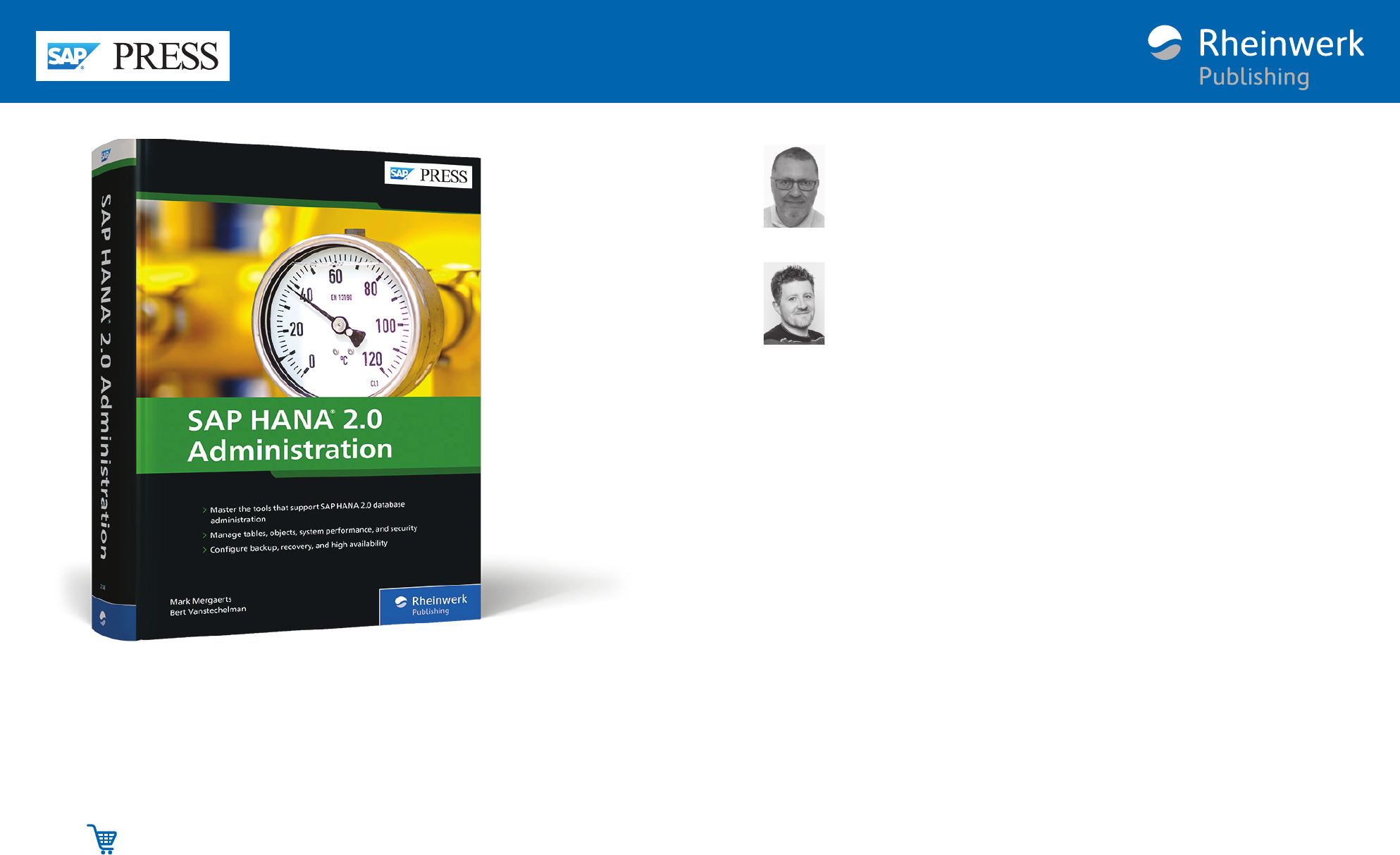
First-hand knowledge.
We hope you have enjoyed this reading sample. You may recommend
or pass it on to others, but only in its entirety, including all pages. This
reading sample and all its parts are protected by copyright law. All usa-
ge and exploitation rights are reserved by the author and the publisher.
Mark Mergaerts is a principal technical consultant at Exper-
tum and has more than 20 years of SAP experience. His activities
concentrate on system administration, database management,
performance, upgrades, and platform and Unicode migrations. He
has written four other books for SAP PRESS.
Mark Mergaerts, Bert Vanstechelman
SAP HANA 2.0 Administration
1056 Pages, 2022, $89.95
ISBN 978-1-4932-2104-2
www.sap-press.com/5287
Bert Vanstechelman is a partner of and principal technical
consultant at Expertum and is the founder of Logos Consulting,
now a part of Expertum. He has more than 20 years of SAP expe-
rience. Bert specializes in platform migrations, SAP installations,
release upgrades, SAP Business Warehouse, SAP Supply Chain
Management, SAP HANA, and OS/DB migrations. Bert is an advisor for SAP
Professional Journal and an SAP Solution Manager Expert. He has written four
other books for SAP PRESS.
